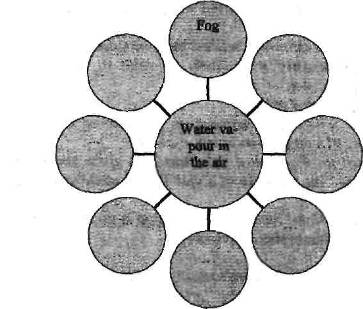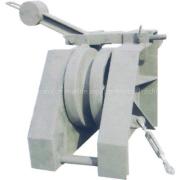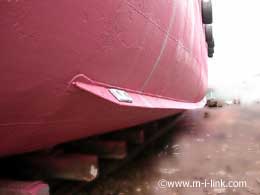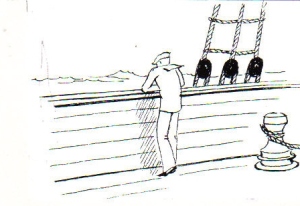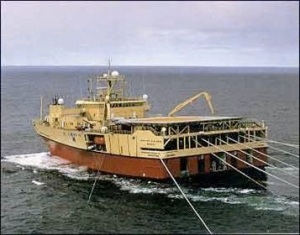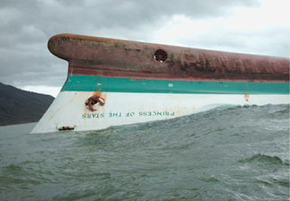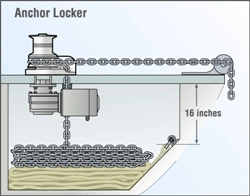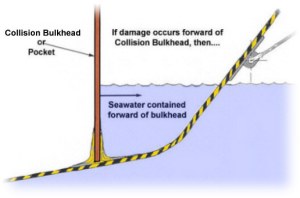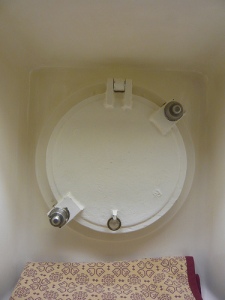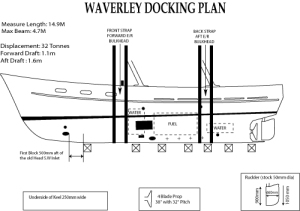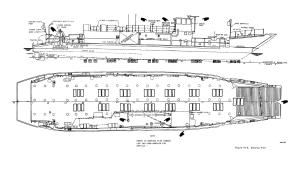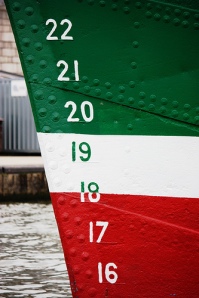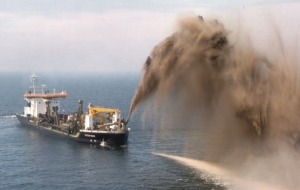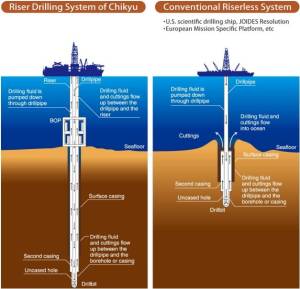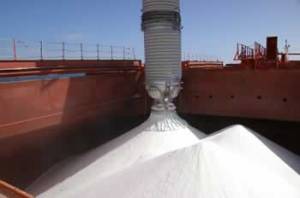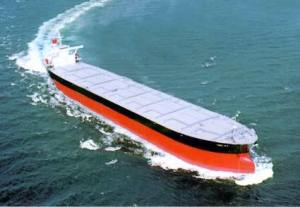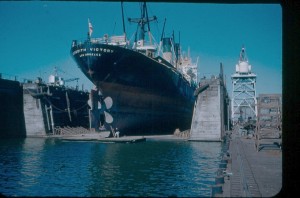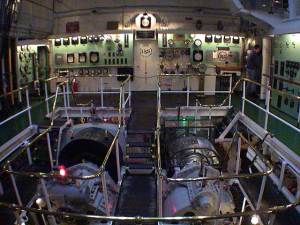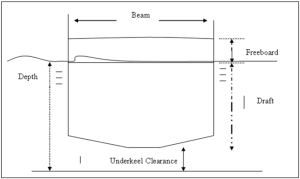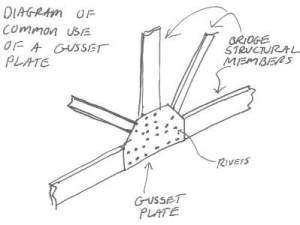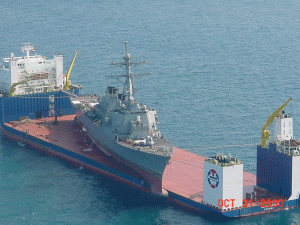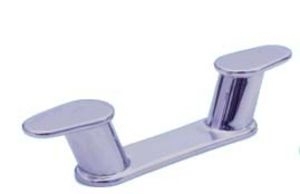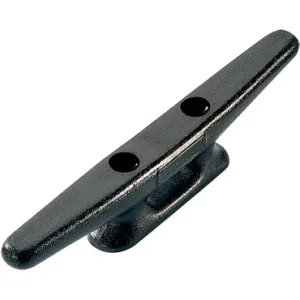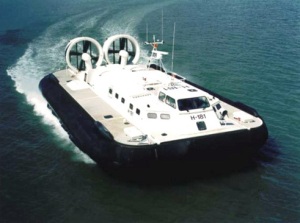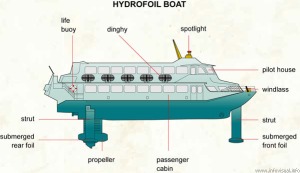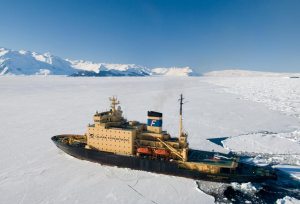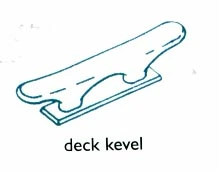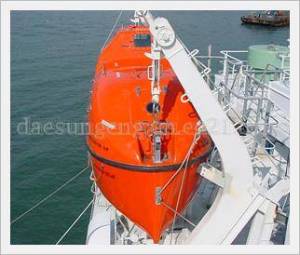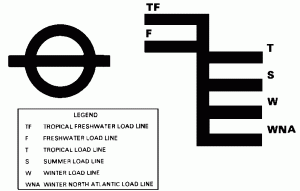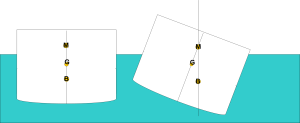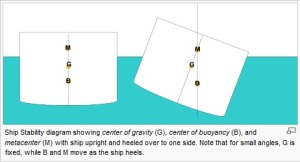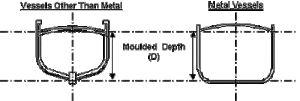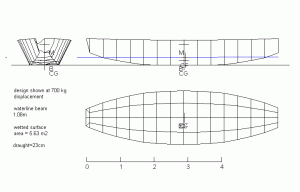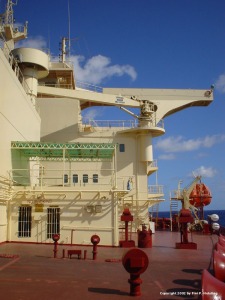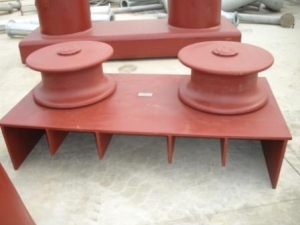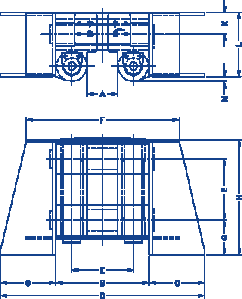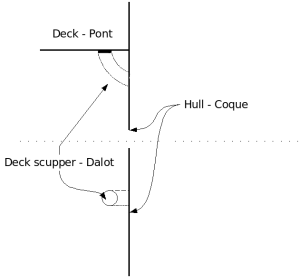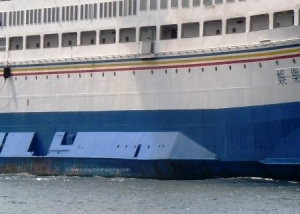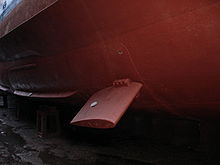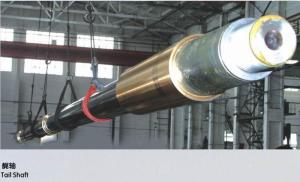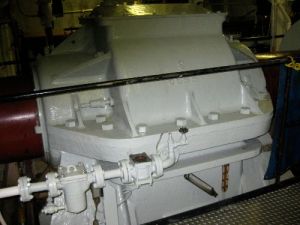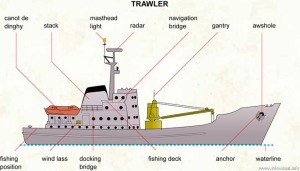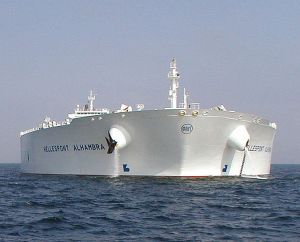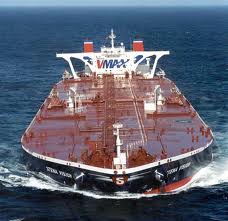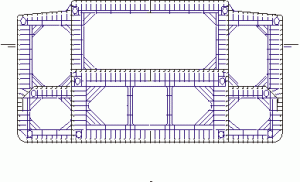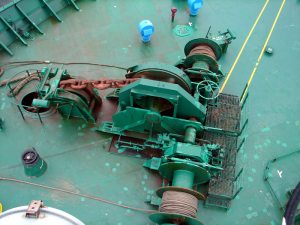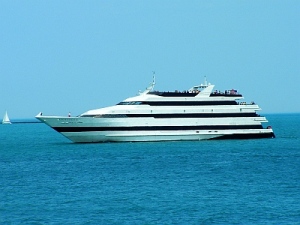boat, ship, vessel, watercraft
* * *
су́дно
с.
ship, vessel (в сочетаниях — равнозаменяемы)
бункерова́ть су́дно — fuel a ship
су́дно вы́брошено на бе́рег — the ship is stranded
выве́шивать су́дно на ста́пель-бло́ках — fair a vessel plumb [set a vessel in an upright position] on the blocks
высаживать(ся) с су́дна — disembark [put ashore, land] from a vessel, leave a vessel
грузи́ть су́дно — load a vessel
закла́дывать (но́вое) су́дно — lay down a (new) vessel, lay the keel for a new vessel
су́дно име́ет оса́дку, напр. 15 фу́тов — a vessel draws, e. g., 15 feet
су́дно нахо́дится в до́ке — the ship is lying at a dock
су́дно (нахо́дится) на прико́ле — the ship is lying idle [is laid up]
обшива́ть (деревя́нное) су́дно до́сками — plank a ship
обшива́ть (деревя́нное) су́дно до́сками вгладь — carvel a ship, plank a ship with carvel work
су́дно остана́вливается — the ship brings herself to rest
су́дно отвали́ло от прича́ла — the ship drew out from her berth
су́дно перела́мывается — the ship breaks her back
поднима́ть (затону́вшее) су́дно — raise [salvage] a (sunken) vessel
су́дно по́лностью снаряжено́ и оснащено́ (для пла́вания) — the vessel [ship] is all found [is well found]
придава́ть су́дну удобообтека́емую фо́рму — streamline the ship
су́дно принима́ет на борт мно́го воды́ — the vessel ships a good deal of water
проводи́ть су́дно в у́зкостях, кана́лах — и т. п. con a vessel
разбира́ть су́дно на лом — break up a ship
разгружа́ть су́дно — discharge a vessel
расцве́чивать су́дно фла́гами — dress a ship
су́дно сади́тся на опо́ры до́ка — the dock takes the ship’s weight
сажа́ть су́дно на опо́ры до́ка — shore a vessel in a dock
снять су́дно с ме́ли — heave off the ship
спуска́ть су́дно на́ воду — launch a vessel, set a vessel afloat
ста́вить су́дно в док — dock a ship
ста́вить су́дно на прико́л — lay up a vessel
ста́вить су́дно на ро́вный киль — bring a ship on an even keel
ста́вить су́дно на я́корь — bring a ship to an anchor
су́дно тащи́тся на я́коре — the ship drags her anchor
су́дно те́рпит бе́дствие — the vessel is in distress
су́дно че́рпает во́ду — a vessel ships water
а́томное су́дно — nuclear-powered vessel
букси́рное су́дно — tug (boat), towboat
винтово́е су́дно — screw(-propelled) vessel
водоналивно́е су́дно — water carrier, water (transport) vessel
возду́шное су́дно (дирижа́блем) — aircraft (not to be confused with airship)
вспомога́тельное су́дно () — auxiliary ship
гидрографи́ческое су́дно — surveying vessel
госпита́льное су́дно — hospital vessel
грузово́е су́дно — cargo vessel, freighter
су́дно для подво́дных иссле́дований — underseas exploration ship
дноуглуби́тельное су́дно — dredging craft
добыва́ющее су́дно () — catching vessel
затону́вшее су́дно — sunk ship, the wreck
зверобо́йное су́дно — sealer
ка́бельное су́дно — cable ship
кабота́жное су́дно — coasting vessel
китобо́йное су́дно — whaler, whaling boat
конте́йнерное су́дно — container ship
кра́новое су́дно — crane ship
ледоко́льное су́дно — ice-breaker (ship)
лесосплавно́е су́дно — timber-carrying vessel
лоцме́йстерское су́дно — boyage vessel
су́дно на возду́шной поду́шке — hovercraft, hovership
надво́дное су́дно — surface vessel
наливно́е су́дно — tanker
су́дно на подво́дных кры́льях [СПК] — hydrofoil craft
нау́чно-иссле́довательское су́дно — research ship
нау́чно-промысло́вое су́дно — fishery research vessel
нефтебурово́е су́дно — drilling vessel
нефтеналивно́е су́дно — oil tanker, oil-carrying vessel
обраба́тывающее су́дно () — factory ship
океанографи́ческое су́дно — oceanographic ship
о́пытовое су́дно — experimental vessel
пассажи́рское су́дно — passenger ship
патру́льное су́дно () — patrol vessel
су́дно пого́ды — weather ship
подво́дное су́дно — submarine (vessel)
пожа́рное су́дно — fire-boat
приё́мно-тра́нспортное су́дно () — fish transport ship
прогу́лочное су́дно — pleasure boat
проме́рное су́дно — sounding vessel
промысло́вое су́дно — catching vessel
промысло́вое, обраба́тывающее су́дно — factory ship
ре́йсовое су́дно — liner
рефрижера́торное су́дно — refrigerator ship
рыболо́вное су́дно — fishing vessel
рыбоохра́нное су́дно — fisheries patrol vessel
су́дно сбо́рной констру́кции — fabricated ship
су́дно секцио́нной постро́йки — fabricated ship
спаса́тельное су́дно — rescue vessel
спорти́вное су́дно — sports vessel
сухогру́зное су́дно — dry-cargo ship
торго́вое су́дно — merchant ship
тра́нспортное су́дно — transport ship
тре́йлерное су́дно — trailer ship
What is another word for loading of a ship?
Synonyms for loading of a ship
load·ing of a ship
This thesaurus page includes all potential synonyms, words with the same meaning and similar terms for the word loading of a ship.
Are we missing a good synonym for loading of a ship?
The Web’s Largest Resource for
A Member Of The STANDS4 Network
Browse Synonyms.com
Quiz
Are you a human thesaurus?
»
What’s the synonym of twee?
-
A. hopefully
-
B. tasteless
-
C. gift
-
D. precious
Thank you
Thanks for your vote!
We truly appreciate your support.
|
Contents |
Index |
Ship, Shipping Operations and Shipping Terms |
||
|
Page |
328 |
|||
Chapter 5
ABS (American Bureau of Shipping). This is a Classification Society. (See also Chapter 7.)
AFRA (Average Freight Rate Assessment). This is a freight billing system which is composed of the weighted average of independently owned tanker tonnage. The London Tanker Brokers’ Panel determines rates for various size categories, for example: 1 5,000124,999—25,000/44,999—45,000/69,999 applicable for six months commencing each January and July. AFRA allows an assessment of a freight scale for various size tankers.
AFRA can also be relevant to such matters as the calculation of demurrage for tankers. For example, in Fina Supply Ltd v. Shell UK Ltd. (1991) the Poitou was nominated to load an oil cargo at Sullom Voe in February 1989. Under the demurrage provisions in the charterparty, the appropriate rate of demurrage was to be determined by applying the AFRA appropriate to the size of vessel actually used and to the date of presentation of the Notice of Readiness. The vessel’s size fell into a range of AFRA which provided a figure of 101.8 per cent as a multiplier to be applied to the appropriate demurrage rate in the Worldscale demurrage table. The case was decided on a number of issues but is given here to show that AFPA does have relevance to commercial and legal matters such as demurrage.
Angle of repose. When bulk cargo is loaded by “pouring” on to a fiat surface, it forms an angle between the cone slope of the cargo and a horizontal plane. Low angles of repose indicate that the bulk cargo is prone to shifting at sea. The IMO “Code of Safe Practices for Bulk Cargoes” (the “Bulk Code”) distinguishes between cargoes having angles of repose less than and greater than 35 degrees.For cargoes with a smaller angle of repose the Code recommends level trimming and filling in of spaces in which they are loaded. One example of a low angle of repose would be with soda ash loaded at Long Beach, California. The angle of repose of this cargo is about 25 degrees.
Anticorrosive paint. This is a special type of rust-preventing primer on a bituminous base. It is used as a primer for vessel’s bottom paints in dry-dock. It has two functions: to prevent corrosion and to bind old anti-fouling that has become porous because the antitoxins or poisons have escaped.
Antifouling composition. These coatings are for underwater use on hulls. They Contain poisons based on copper and mercury compounds. The poisons prevent the adhesion of organisms to the hull.
During the life of the vessel, the poisons “leach” or are gradually released into the sea, killing off the organisms. This paint must never be applied to bare steel because the copper and mercury compounds may cause severe corrosion.
Anti-fouling is proof against the attachment of seaweed, barnacles and other marine growth on the underwater shell of vessels. In modern painting schemes, various compositions are used, such as “selfpolishing copolymers” (SPC) which reduce marine growth on the underwater shell plating and thus reduce resistance, increasing speed for the same engine power and fuel consumption.
|
Contents |
Index |
Ship, Shipping Operations and Shipping Terms |
||
|
Page |
329 |
|||
API gravity. In the oil industry influenced by the United States the “American Petroleum Institute” scale of mass/volume is used. The API scale is based on a standard, reference temperature of 60 degrees F. and can be converted to “specific gravity” (SG) by the formula:
SG (at 60 degrees F.) =_____141.5_____
API + 131.5
Apparel. The cargo capacity may be defined in a charterparty as follows:
“… tons, not exceeding what she can reasonably stow and carry in addition to her tackle, apparel, provisions, bunkers and furniture.”
The word “apparel” relates to the equipment of the vessel such as anchors, chains, lifeboats, etc.
Arrest or seizure under legal process. A ship may be arrested for a maritime claim against it through legal action, as a guarantee for payment for damages. Before a ship can be arrested, a court must approve such action. The procedures for ship arrest vary between countries.
If the vessel is arrested, she may be released as soon as the shipowners or P. & I. Club have provided sufficient security by a cash deposit or by providing a guarantee, countersigned by a bank, for payment of the claim and costs. If no security is given the ship may be sold and the claim and costs satisfied out of the sale proceeds.
Articles of Agreement. This was the name given to the document in which the terms of the crew employment agreement was contained. Under some flags, the Crew Agreement is still called the “Articles”. The name came from the different paragraphs in the document, each one numbered as “Article 1”, “Article 2”, and so on. The Agreement was also sometimes called “ship’s articles” or “shipping articles” and indicated that the contract was between the seaman and the master.
Back haul. This may be a diversion for a tanker to move cargo on the return leg of a voyage in order to minimise the ballast mileage. For example, a tanker may proceed from the Caribbean to North Europe and back directly (with a longer ballast leg) or via the Mediterranean and a port in the United States North of Cape atteras (USNH) with a cargo on board.
Back Letter. Back letters may be drawn up to complement a contract in order to lay down rights and/or obligations between both contracting parties, which, for some reason or other, cannot be included in the original contract. This expression is also used for “letters of indemnity”. (See Letters of Indemnity in Chapter 3)
Balespace. The balespace of a vessel is the volume capacity of cargo spaces under deck (including hatchways), expressed in cubic feet or cubic metres. The balespace is obtained as follows:
Length of each hold multiplied by breadth (measured to inside of cargo battens at half length of the hold) multiplied by depth (measured from top of ceiling to underside of beams).
The expression “balespace” does not relate only to space available for cargo in bales but refers to any other kind of packing, e.g., cases, casks, etc.
Ballast. In order to increase the stability of ships, which have to be dispatched without cargo and to ensure that the propeller will be immersed sufficiently, say about two-thirds of its diameter, a sufficient quantity
|
Contents |
Index |
Ship, Shipping Operations and Shipping Terms |
||
|
Page |
330 |
|||
of ballast will be loaded before sailing. The quantity of ballast depends on the type of vessel, quantity of water which can be taken in the ballast tanks and also the voyage to be made. Seasonal weather conditions which may be expected on the voyage must also be considered.
Barratry. Under the U.K. Marine Insurance Act 1906 the term barratry includes every wrongful act willfully committed by the master or crew to the detriment of the owners or charterers, as the case may be. The act must be committed intentionally without connivance on the part of the owners. From this point of view negligence does not constitute “barratry” as there is no question of any wrongful act committed with the object of causing loss of or damage to ship and/or cargo.
Examples of acts within the definition of “barratry” are:
Scuttling of vessels with malicious intent (not, for instance, to extinguish fire).
Concealing stowaways on board.
Smuggling, without owner’s consent.
Under the terms of hull insurance policies, shipowners may be covered for barratry of the master and mariners.
Beaufort Wind Scale. At sea the wind speed is expressed in numbers according to the Beaufort scale. The Beaufort Number (BF) is estimated from the sea surface appearance.
|
Beaufort |
Description of wind |
Speed in Knots |
|
0 |
Calm |
Less than 1 |
|
1 |
Light air |
1—3 |
|
2 |
Light breeze |
4—6 |
|
3 |
Gentle breeze |
7 — 10 |
|
4 |
Moderate breeze |
11—16 |
|
5 |
Fresh breeze |
17—21 |
|
6 |
Strong breeze |
22—27 |
|
7 |
Moderate gale |
28—33 |
|
8 |
Fresh gale |
34—40 |
|
9 |
Strong gale |
41—47 |
|
10 |
Whole gale |
48—55 |
|
11 |
Storm |
56—63 |
|
12 |
Hurricane |
64 — 71 |
The Beaufort wind force scale extends to Force 17 (up to 118) knots but Force 12 is the highest which can be identified from the appearance of the sea.
Bilge. The bilge of a vessel with double bottom tanks is a triangular channel on both sides formed by the margin plate of a double bottom, the curvature of the outer skin of the vessel and the bilge ceiling. The bilge ceiling can be regarded as a continuation of the ceiling on the tank top. More simply, the radius part
of the shell plating joining the bottom and the side shell is the “bilge”.
The water collected in the ship’s bilges can be pumped out by suction pipes running through both bilges.
Bill of health. The Bill of Health is the certificate that used to be issued by the local authorities indicating the general health conditions in the port of departure or ports of call. Before sailing, the Bill of Health was given a visa by the Consul of the country of destination. International Health Regulations now apply, and Bills of Health are no longer very common, but not all countries are bound by these. In some

|
Contents |
Index |
Ship, Shipping Operations and Shipping Terms |
||
|
Page |
331 |
|||
countries Bills of Health issued by the Consuls of those countries may be officially required. (See also
Maritime Declaration of Health.)
Block coefficient. The block coefficient of a vessel is obtained by dividing the underwater volume of displacement of a ship by the volume of a block of the same length and breadth, and of height equal to the draught of the ship. The block coefficient depends upon the “lines” of the ship. Passenger vessels with fine lines have a lower block coefficient than cargo ships with full lines. The abbreviation for Block Coefficient is generally given as Cb.
Blockade. Belligerent powers have the right of blockade, i.e., the right to blockade enemy ports or coastal territory for ocean shipping by military measures.
The blockade must be respected by neutral states. Running a blockade, if unsuccessful, may entail boarding and searching for contraband and confiscation of ship and cargo.
Bonded stores. Ship’s stores which can be delivered under special arrangements direct from a bonded warehouse to the vessel without payment of Customs duties.
Bonding. This is an operation that was performed (and can still be used in some ports) on oil tankers to prevent electrical discharges caused by a difference of discharged. A shore grounded cable was attached to the vessel before the cargo potential between ship and shore when the cargo of oil was being loaded or hoses are connected. The loading or discharging of oil can lead to static electricity charging and the discharge can lead to explosion if this occurs when the cargo hoses break or are disconnected because explosive oil vapours may be present during cargo-handling operations.
Boot topping. The boot topping is part of the outside shell of the vessel between the light and loaded draught, that is, that part of the hull which is exposed alternately to wind and water. Moreover, the vessel’s berthing and unberthing and also tugs’ rubbing against the ship in the arrival and departure from ports lead to severe abrasion in this region.
It was customary to use a special kind of paint, which dries quickly, for the boot topping region. The normal antifouling paint, when exposed alternately to water and wind, is less cohesive. A coat of boot topping paint was laid over the anti-Corrosive paint.
However, with modem, high quality paints the boot topping hull region is no longer defined as requiring special coating. The same coating may be used between the light loadlines and the upper deck except that there is still likely to be a higher degree of abrasion in this region. (See Figure 5.2.)
Breadth moulded. This expression relates to the maximum breadth of a ship measured amidships between the outside (heels) of the frames, i.e. to the inside of shell plating. (See also Extreme breadth.)
Figure 5.2
|
Contents |
Index |
Ship, Shipping Operations and Shipping Terms |
||
|
Page |
332 |
|||
Break bulk cargo. This is cargo carried on board traditional, conventional general cargo ships. The cargo is loaded and discharged one piece at a time (heavy cargoes) or a few pieces at a time, such as a number of bales or drums or a bundle of steel sheets.
Broken stowage. This refers to space not occupied by cargo iii a cargo compartment or even in a container. It can be caused by fittings in the ship, such as car decks in a ro-ro vessel or web frames in a cargo hold. It can also be caused by the non-uniform shape of the cargo pieces themselves, such as the spaces around protrusions in heavy machinery or between curved casks.
Broken stowage represents lost cargo space and therefore lost earning capacity. Moreover, broken stowage is a void space, which could encourage cargo movement while the vessel is moving in a seaway.
Therefore broken stowage must be avoided as far as possible both by planning cargo stowage so that the least space is wasted and by attempting to fill empty spaces between cargo. This can be done by dunnage or by small, nearly flexible parcels of cargo such as coils of wire or small bales, or, in the case of timber cargoes, smaller parcels of pieces of the timber. Exporters of timber from the Baltic ship “ends” for filling the space left unoccupied. Such filling up cargo is carried at a lower rate, for example twothirds of the normal rate.
The percentage of waste depends upon various factors, e.g., the kind of cargo and packing (bags or cases), space occupied by dunnage, type of vessel (one or more tweendecks), number of hold obstructions and the lines of the ship’s hull which affects the shape of the holds, in particular those nearest to the bow and stem, etc. As a matter of course more space may be lost in fast cargo vessels, which have sharp lines for speed. Another factor is the loss of space with bagged goods because bagged cargo may be subjected to more pressure in the lower holds than in the tween decks of general cargo ships.
Builder’s certificate. As the name indicates, this certificate is issued by the shipbuilding yard, containing a true account of the estimated tonnage; the year and place where the vessel was built and also the name of the owners and other details. This certificate is required in addition to the declaration of ownership , on the first registry of the ship.
Bulk cargo. The IMO “Code of Safe Practices for Solid Bulk Cargoes” defines this cargo as:
“A cargo consisting of solids in particle or granular form, with or without entrained moisture, generally homogeneous as to composition, and loaded directly into a ship’s cargo spaces without bagging or packaging.”
Huge volumes of cargo in international trade are transported in bulk form in specialised bulk carriers. However, small percentages of the different bulk commodities may still be fixed for ships which are not specialised bulk carriers, for example, general cargo ships and there will then be important cosniderations to be taken into account. The main hazard with some dense bulk cargoes is stress or lack of stability, caused by improper weight distribution. In purpose-built ore carriers these problems are minimised because of planned loading instructions from the ship designer and also the strength and design of the ship itself.
There are various categories of hazard with bulk cargoes. For example,
(a)improper weight distribution can result in structural damage;
(b)improper stability or reduced stability can occur during the voyage because of cargo shift; the improper stability can be excessive, where the vessel is too “stiff” with a large metacentric height because
|
Contents |
Index |
Ship, Shipping Operations and Shipping Terms |
||
|
Page |
333 |
|||
high-density cargo, such as iron ore, is loaded too low down; it can also be deficient;
(c)some commodities heat spontaneously, e.g., coal and ore concentrates;
(c)toxic or explosive gases can be emitted, e.g. from coal;
(d)severe corrosion can be caused by some bulks such as sulphur ;
(e)determination of quantity loaded can be difficult (see “draft survey”);
(f)some cargoes, such as ore concentrates and similar finely divided materials, liquefy when shipped
in a damp state; they may appear to be in a relatively dry granular state when loaded yet may contain sufficient moisture so as to become fluid under the stimulus of compaction and the vibration which occurs during a voyage; in the resulting viscous, fluid state the cargo may flow to one side of the ship with a roll one way but not completely return when the ship rolls the other way; the vessel may progressively reach a dangerous heel;
(g) damage can be caused by improper cargo-handling methods; e.g., ‘‘pouring’’ of heavy lumps of a high—density bulk cargo can damage the bottom of the hold; grabs used for discharge can also damage the vessel’s structure.
Therefore, before loading any solid bulk cargo, the master and shipowner should obtain detailed, comprehensive and current information from the shipper.
Bulkheads. These are steel divisions across the vessel either transversely or fore and aft. The functions of bulkheads are:
1.To increase the safety of a ship. By dividing a ship into separate watertight compartments, the damage in case of collision may be confined to one compartment. Should one compartment be flooded, the bulkheads must be strong enough to withstand the pressure of water, so that the adjacent compartments remain dry.
2.To separate the engine room from the cargo holds or cargo tanks. 3.To increase the transverse strength of a vessel
4.To reduce the risk of fire spreading from the compartment of outbreak to the other compartments.
The number of watertight bulkheads of a cargo vessel depends upon the ship’s length and design and the Rules of the Classification Society which covers the vessel. The Rules generally require that a “collision bulkhead” is fitted forward, between 5 and 8 per cent of the vessel’s length from the forward end of the load waterline. Fifty per cent of the damage caused in a collision occurs at the forward end of the vessel and this strong bulkhead is expected to prevent the water from flooding
No 1 cargo compartments. Rules also require a minimum of three others if the machinery space is amidships or two if the machinery space is aft. These are to separate the machinery space from the cargo spaces and also an afterpeak bulkhead to provide subdivision at the extreme after end of the vessel. The propeller shaft passes through the afterpeak tank, which is also used for housing parts of the steering arrangements and for containing either fresh water or ballast. The number of bulkheads required by Classification Societies increases with the size of the vessel, mainly to produce additional transverse strength and increase the amount of subdivision for watertight integrity.
Butterworth tank cleaning system. This is a method for cleaning and gas freeing oil tanks by means of high pressure jets of water, either cold or heated. The apparatus consists essentially of double opposed nozzles which rotate slowly about their horizontal and vertical axes, projecting two high pressure streams of water against all inside surfaces of the deck, bulkheads, tank framing and shell plating.
|
Contents |
Index |
Ship, Shipping Operations and Shipping Terms |
||
|
Page |
334 |
|||
Capacity plans. The capacity plan shows a longitudinal and transverse profile of the vessel, and diagrams of loadlines as well as the principal particulars, such as:
Gross tonnage; net register tonnage; deadweight capacity on winter, summer and tropical loadline; deadweight and displacement scale on varying draught; this scale also shows the moment to change trim 1 cm and the TPC for each draught; a diagram with measurements of winter, summer, tropical and fresh water loadlines with a diagram of the position of the deck line; this is usually placed alongside the deadweight and displacement scale so that the deadweight or displacement can be found for any loadline at a glance; grain and bale capacity of all cargo spaces in cubic feet or cubic metres and the position of the centre of gravity of the space; bale capacity of all cargo spaces in cubic feet or cubic metres; capacity in cubic metres and tonnes of double bottom tanks, peaktanks, deeptanks and fuel tanks and the positions of the centre of gravity of these spaces; capacity of all stores and refrigerating chambers.
(See Figure 5.3 (p. 420) for a “Deadweight Scale” on a Capacity plan for a bulk carrier.)
Cargo battens or sparring. In older-style general cargo vessels, cargo battens are fitted fore and aft horizontally inside the ship’s frames in the holds and tweendecks at a regular distance of approximately 30 centimeters to prevent contact between the cargo and the frames or shell plating. The wooden planks are fitted to the frames by means of hooks, so that they can be removed. The cargo battens keep the cargo free from moisture or sweat, which may condense on the ship’s sides.
The cargo battens are not sufficient as dunnage and in many cases extra dunnage is required.
Cargo plan or stowage plan. In the regular liner trade it is customary to draw up a stowage plan, showing in different colours the part of the ship in which the various parcels have been stowed, stating at the same time marks and destination.
Such a document gives a clear picture of the stowage of each parcel and it will enable agents at the port of discharge to take the necessary preparatory measures for the discharge of the vessel well in advance. Moreover, in case of damage or it is important to know which parcels are affected.
Cargo oil pump (COP). This is a pump used on board tankers for discharging cargo and loading or discharging ballast. The pumps are usually located at the bottom of the pump room and can be of various types, e.g., the centrifugal turbine type or the steam-driven reciprocating, duplex type.
Cash flow. Cash flow represents the total funds that corporations generate internally for investment in the modernisation and expansion of the fleet or for making an acceptable profit. This is a method of calculating the revenue against the expenses. For vessels, the revenue consists of either freight or hire and the expenses can be classified and separated into different categories, such as:
Voyage costs—fuel consumption, port charges, canal dues..
Operating costs—crew, stores, insurance, maintenance, administration.. Cargo-handling costs …
Capital costs—financing structure, interest, capital payments… Taxes—national corporate taxes, cargo taxes…. Dividends—to shareholders …
In the financing of vessel acquisition, bankers and other financial institutions paid more attention, in 1990 and 1991, to a shipowner’s cash flow than to the expected capital growth that had been the case in the 1980s. Consequently, financing of ships became more difficult.
|
Contents |
Index |
Ship, Shipping Operations and Shipping Terms |
||
|
Page |
335 |
|||
Ceiling. The ceiling consists of wooden planks laid on top of the double bottom tanks. The planks are laid longitudinally and prevent contact between the cargo and the double bottom. In some cargo vessels a ceiling is only fitted below the hatchway as a platform for cargo. The ceiling in itself is not sufficient as dunnage for bagged cargo and extra dunnage, e.g., is required, in order to ensure a good outturn. The ceiling and cargo battens are considered as permanent dunnage in contrast with dunnage such as mats, boards, burlap, paper, etc, which is “portable” or “temporary” dunnage.
Centre of buoyancy (B). This is the geometric centre of the under water shape or volume of a floating object. The buoyancy force provided by the liquid in which the object floats acts vertically upwards through B.
Centre of gravity (G). The line of action of the weight (force) of a body acts vertically downwards through this point, named “G”. For a uniform block, G is at the centre. For a ship, the position of G depends on the various weights in the ship.
Centreline bulkhead. Some general cargo, tramp vessels, were fitted with centerline bulkheads extending from the bulkheads to the hatchways. Apart from increasing the longitudinal strength, such centerline bulkheads mean a considerable saving in expenses for shifting boards required by vessels carrying grain in bulk. Such grain tight shifting boards had only to be fitted in the lower holds over a distance equal to the length of the hatchways.
Certificate of registry. The certificate of registry is issued by the national authorities of the country in which the vessel’s owners are based.
The certificate of registry which establishes the nationality and ownership of a ship shall be used only for the lawful navigation of the ship.
Clean ballast. A tank on board an oil tanker may be so cleaned since oil was last carried in it that the effluent from it would not produce visible traces of oil on the surface of the water or on nearby shorelines or cause a sludge or emulsion to be deposited beneath the surface of the water or on nearby shorelines. When the effluent is discharged, the vessel must be stationary and the discharge must be into clean, calm water on a clear day for the above criteria to apply.
The ballast may also be discharged through suitable oil discharge monitoring and control systems but the oil content must not be more than 15 parts per million for the effluent to be considered to be “clean ballast”, despite visible traces of oil being present.
In the attempts to stem pollution by oil from ships, the MARPOL Convention was adopted in 1973 and a Protocol added in 1978 which aimed at preventing pollution by oil from ships. Under MARPOL, existing ships were permitted to discharge oily mixtures into the sea under very strictly controlled circumstances. Such ships had to be fitted appropriately to prevent operational pollution. They were permitted to have either Dedicated Clean Ballast Tanks (CBT) or Segregated Ballast Tanks (SBT) or operate Crude Oil Washing (COW) depending on size. For crude oil tankers over 70,000 deadweight tonnes, the Clean Ballast Tank option ended in 1985 and for those over 40,000 it ended in 1987.
“New tankers” (built, delivered or converted after a range of dates from 1979 to 1982) could have only “Protectively located” SBTs and COW.
If a tanker is not a “new tanker” there are requirements for control of operational pollution and control of the discharge of oil. One criterion permitting discharge from these tankers is that the effluent discharged must meet the description of “clean ballast”.
|
Contents |
Index |
Ship, Shipping Operations and Shipping Terms |
||
|
Page |
336 |
|||
Coefficient of fineness of waterplane area (Cw). This is the ratio between the area of the waterplane and the area of a rectangle of the length and maximum breadth of the vessel’s waterplane: This will vary with draught.
Cofferdam. In oil tankers the oil tanks are separated from the engine room by means of a cofferdam formed by two transverse bulkheads. The cofferdam extends over the entire breadth of the vessel and prevents leakage from the oil tanks to the engine room or diesel-oil bunkers. The pump rooms are also separated from adjacent tanks by cofferdams.
Coiled ship. This ship type would most probably be an oil tanker or a tanker to carry liquids in bulk. It would be provided with coils through which steam is passed to heat the liquid to reduce its “viscosity” and enable it to be pumped more easily.
Collision bulkhead. (Sometimes called a forepeak bulkhead.) All vessels must-be fitted with a minimum number of bulkheads. (See Bulkheads above.) The most important is the collision bulkhead fitted forward. The bow of a ship involved in a collision has a serious chance of being damaged. The damage can be very severe. Therefore a heavy bulkhead is specified by the Classification Society and also under the SOLAS 1974/1978 Convention. The collision bulkhead must be watertight up to the uppermost continuous deck (the “freeboard deck”) and located at a distance from the forward perpendicular of between 5 per cent and 8 per cent of the ship’s length or 10 metres, whichever is more. There are other criteria for collision bulkheads, which need not be set out in detail here. Reference to the relevant document containing the Rules and regulations of a Classification Society and also the SOLAS Convention will assist with the details.
The main object in constructing a collision bulkhead is to prevent flooding of the forward hold in case of collision. In practice, the collision bulkhead on board cargo ships is placed at the minimum distance in order to obtain the greatest cargo space in the forward hold.
Combination carrier. (See also Ship types.) Fundamentally, this is a vessel designed to carry either liquid or dry bulk cargoes. If a vessel is a specialist vessel, for example, only carrying crude oil, there is a disadvantage to the shipowner because the vessel would have to be ballasted on one leg of each passage. The vessel cannot earn money for the shipowner while it is in ballast, unless, of course, it is on a period time charter or on a demise charter. The combined carrier was developed mainly as bulk carrier capable of carrying oil in wing tanks. The type was originally developed as an ore/oil carrier (0/0) but further design developments led to a vessel which is flexible enough with the cargoes that it can carry to be called an OBO, or Ore/Bulk/Oil.
The O/O carrier is similar in construction to an ore carrier which has strengthened structural components for the heavy ore cargoes and wing tanks for the oil. The ore compartments are usually high up in the vessel so that the centre of gravity of the high-density ore cargo is raised. If this were not done, the vessel would have too large a “metacentric height” and be too stiff, moving very violently in a seaway.
The OBO is similar in construction to a conventional bulk carrier but can carry lighter dry bulk cargoes or ores and oil in wing tanks.
The combination carrier is more expensive to build but gives the owner some flexibility.
Complement. The entire crew of a vessel is called the “complement”. The complement can be subdivided into, for example, the officer complement, and the rating complement.
|
Contents |
Index |
Ship, Shipping Operations and Shipping Terms |
||
|
Page |
337 |
|||
Concentrates. This is a material in small particle form which results from a processing of natural ore. The main hazard associated with concentrates is that moisture entrained in the particles may settle out and the surface reach a nearly fluid state which will affect the ship’s stability if the cargo shifts. Moreover, some concentrates, such as iron concentrates produced when iron is crushed dry, contain sulphur so that if concentrates become damp the sulphur reacts with the oxygen in the surrounding air to produce heat. Compartments containing concentrates should not be ventilated in order to reduce the oxygen content.
Constructional differential subsidy—Operating differential subsidy. (See Subsidies). These were countervailing subsidies paid by the United States Government to U.S. shipowners in foreign trade in order to offset the effects of subsidies paid to foreign competitors. During President Reagan’s Administration in the 1980s, these subsidies were gradually phased out.
Contamination. If a cargo which is sensitive for some reason is damaged by the nature of another cargo or substance, the former is “contaminated”. This would be the situation if one grade of oil, e.g., a clean oil product on board a tanker, was loaded into a tank that was insufficiently cleaned. The refined oil would be sensitive to contamination. Contamination of oil cargoes can also occur if more than one grade of oil is being carried in different tanks and the valves and/or pipelines between tanks leak. In oil tankers that carry oil it is customary to have at least a two-valve separation between grades to avoid this damage which can lead to very large cargo claims on the owner or operator of the tanker.
In dry cargo ships contamination can occur also between cargoes and also from fumes and other noxious gases from the machinery spaces if the cargo is not properly stowed and adequate ventilation not carried out. Under the obligations for the carriage of goods by sea, the carrier must care for the cargo on passage. Therefore, permitting cargo to become contaminated would be a breach of this obligation and can lead to very heavy claims.
Cross trades. On trade routes between two places or countries the ships belonging to each country may have a large share of the trade but ships belonging to other countries may be allowed to carry cargo as “cross traders”. A cross trader therefore carries cargo between places or ports in countries whose flag the vessel does not fly. Many traditional shipowners have operated as cross traders, e.g., much of the United Kingdom’s invisible exports or earnings from services comes from ships registered in the U.K. but carrying cargo between other countries.
In the Convention on a Code of Conduct for Liner Conferences 1974, the “40/40/20” Code requires cargo sharing on routes serviced by liner conferences on the basis that equal shares will be carried by national lines on the routes and no more than 20 per cent by other countries’ vessels. (See also Chapter 4.)
Daily operating costs. This expression covers the daily running costs of a vessel which can be expressed in a fixed amount per day and which are not conditional upon the quantity of cargo, service speed, etc. (see also Cash flow).
Date line. When steaming from West to East time is lost for each time zone. Conversely, when proceeding from East to West time is gained.
The international date line running through the Pacific Ocean (about the 180 degree Meridian) indicates the place for change of date. When crossing the date line proceeding westward, the date must be advanced by omitting one day.
Conversely, when proceeding in an opposite direction there will be a loss of time and the date must be put back one day by repeating the same day and date.
It should be noted that in order to keep islands belonging to one group, for 3 example, Aleutian Islands
|
Contents |
Index |
Ship, Shipping Operations and Shipping Terms |
||
|
Page |
338 |
|||
and the Tongan Islands on the same date, the 180 Meridian is not exactly followed by the date line.
Deadweight capacity. The deadweight is the tonnage of the cargo and other items the vessel can carry at different draughts. Thus, at the statutory summer draught, the deadweight is called the “summer deadweight”.
The deadweight of a vessel is the total weight of cargo, bunkers, dunnage, provisions, fresh water, ballast (if any), stores and spare parts, expressed in tonnes of 1,000 kilogrammes, which a vessel can lift when loaded in salt water to her maximum draught, either winter, summer or tropical loadline, as the case may be. The deadweight is equal to the difference between the vessel’s displacement on her loaded draught and the displacement on her light draught (see Capacity plan for a diagram of a deadweight scale and also Light displacement or light weight).
The deadweight capacity is related to the cargo the vessel can carry under a charter. For commercial reasons the word can be divided into:
“DWAT” or “Deadweight all told”—the total deadweight, usually to the summer, salt water draught, and
“DWCC” or “Deadweight cargo capacity”—the mass of cargo only that the vessel is capable of carrying.
Deals, boards, battens and scantlings. Light sawn timber from the Baltic is classified in deals, boards, battens, scantlings and ends, depending on size. The following sizes are customary in the trade:
|
Thickness in mm |
Breadth in mm |
|
|
Boards |
50 |
150 |
|
Scantlings |
50 |
75—150 |
|
Battens |
100 |
150—180 |
|
Deals |
50+ |
230—250 |
Charterparties for full cargoes of lumber provide for shipment of a certain percentage of short lengths (ends) for filling (broken stowage) at a reduce rate of freight.
Deck cargoes. Many cargoes can be carried on deck because of their size or weight of individual units. Ondeck cargo is prone to damage and/or loss overboard and the carrier should try to reduce his liability accordingly. Remember that as far as the Hague-Visby Rules are concerned, “goods” (for which a carrier is responsible under the Rules, excludes “… cargo which by the contract of carriage is stated as being carried on deck and is so “carried”. The word “and” is important. For example, if a carrier is given liberty to carry the cargo on deck (as in most bills of lading and charterparties) but does not carry the cargo on deck, he is responsible and can limit his liability under Article IV, r.5, for damage to it. (See Bills of lading and Deck cargo in Chapter 3.)
Deck cargoes are usually dangerous goods such as asbestos, compressed gases, flammable liquids, corrosives, explosives; timber cargoes, such as heavy logs; long structural steel; heavy bridge girders or sections, railway engines, boilers, pontoons, boxed machinery and small vessels.
Deeptanks. In order to increase the water ballast capacity; many older, multi-deck cargo ships are equipped with deeptanks running from the tank top of the double bottom to the lower or upper tweendeck and extending over the entire breadth. As a rule the deeptanks were constructed amidships forward of the engine room or at both ends. The reason for this was to provide capacity for water ballast, thus improving the draught but with hardly any change in trim.
|
Contents |
Index |
Ship, Shipping Operations and Shipping Terms |
||
|
Page |
339 |
|||
In general cargo vessels deeptanks were also suitable for the carriage of vegetable oil in bulk, e.g. palm oil, coconut oil, etc. By means of oil tight partitions and decks it is possible to carry different kinds of oil in adjacent tanks. Each compartment in the lower holds is separated from an adjacent tank in the tweendecks by tank lids, which can be closed oil tight by means of bolts. The dimensions of these tank lids are such as also permit stowage of dry general cargo in the deeptanks.
The deeptanks are equipped with heating coils in order to enable discharge of edible oil at the required temperature. This was another reason the deeptanks were situated close to the engine room or machinery space: it was relatively easy to supply steam to the heating coils.
Before loading of vegetable oil cargoes, the deeptanks and heating coils were subjected to pressure under supervision of a competent surveyor, in order to trace signs of leakage. If no defects were found, the surveyor issued a certificate of tightness, which is an important document proving, in case of leakage, that carriers have exercised due diligence.
Density. For liquids in bulk the ratio of the mass to unit volume is the unit of measurement known as the “density”. This leads to another measurement unit where the ratio of the density of the liquid to the density of fresh water is known as the “specific gravity”. The units of density are in tonnes per cubic metre or kilogrammes per cubic metre, 1,000 kilogrammes being one metric ton or “tonne”. Therefore, the density of fresh water is taken to be 1 tonne per cubic metre. The density influences the draughts of the ship and therefore the deadweight and displacement.
Depth. The depth is the vertical distance measured fromthe keel to the deck. The extreme depth is the depth measured at the ship’s side from the uppermost continuous deck to the lower point of the keel. The moulded depth is measured from the top of the keel plate (the “base line”) to the underside (that is, the heel) of the deck beam at the ship’s side amidships.
Dirty. This expression is regular1y used in tanker freight market reports and refers to fixtures for “dirty” oils, e.g., fuel oil, lubricating oil and crude oil, in contrast with “clean oils”, e.g., gasoline, diesel oil, etc.
A “dirty service” is the tanker transportation of crude oil and residual fuels. A “dirty ship” is a tanker which has been carrying crude and heavy persistent oils such as fuel oil. “Dirty ballast” is ballast that is carried in unwashed cargo oil tanks.
Disbursements. This expression covers all payments made by the ship’s agents for port charges, stevedoring expenses, tug hire, customs fees, stores, bunkers, water, etc., on behalf of owners. The agents may charge a certain disbursements’ commission on such advances, e.g., 2½ per cent.
Displacement. Because a floating body “displaces” its own weight of water, the expression has two meanings:
(a)The volume of water, displaced by a vessel, measured in cubic metres (volume of displacement or underwater volume).
(b)The quantity of water displaced by the vessel expressed in metric tons (displacement).
The term “displacement” without any qualification relates to the weight of the complete ship in metric tons.
The displacement in water is obtained by multiplying the underwater volume by the density of the water.
The displacement varies with the density of the water in which the vessel floats. In salt water, the displacement is higher than in fresh water at the same draught.
|
Contents |
Index |
Ship, Shipping Operations and Shipping Terms |
||
|
Page |
340 |
|||
Displacement scale. The displacement scale indicates:
1.Displacement at varying draughts and the number of tonnes required to increase the draught of the ship one centimetre at the various draughts. This number is not a fixed number but varies according to the draught. In light conditions fewer tonnes are required to put down the ship one centimetre on account of the fine lines of the ship’s structure.
2.Deadweight capacity in tonnes at different draughts. 3.Maximum draughts on winter, summer and tropical loadlines.
Dock water allowance (DWA). When a vessel moves from salt water to water of lower density it will increase its draught and vice versa. The amount of change is known as the “dock water allowance”. The dock water allowance depends on the “Fresh water allowance” (“FWA”) which represents the change in draught when moving between salt water (density 1.025 tonnes per cubic metre) and fresh water (1 tonne per cubic metre). The DWA can be estimated from a formula:
FWA (1.025 — d) 0.025
where d = the density of the water in which the ship floats.
Double bottom. The double bottom, extending from the forepeak to afterpeak tank, considerably increases the safety of the vessel in case of serious bottom damage by grounding, which might otherwise result in flooding of the cargo holds or engine room. Moreover, the double bottom, which is subdivided into a number of tanks, is suitable for carriage of water ballast, fuel oil, fresh water etc., and increases the longitudinal strength of the vessel.
The double bottom tanks are accessible from the ship’s holds or tunnel by means of manholes, which are closed by watertight covers with bolts.
Down by the head—Down by the stern—On even keel. These expressions mean: 1.The draught forward exceeds the draught aft.
Such a “trim” will have a detrimental effect upon the ship’s speed and steering. 2.The draught aft exceeds the draught forward.
In most cases a certain drag is preferable in connection with the steering of the ship. Too much drag may result in loss of speed. Ships sailing in ballast may need to be trimmed by the stern 1 to 1.5 metres so that the propeller will be sufficiently immersed, say at least two thirds of the diameter, otherwise the power developed may be wasted.
3.The draughts forward and aft are equal.
Down to her marks. This expression means that the vessel has been loaded to her maximum permissible draught, either winter, summer or tropical loadlines, as the case may be. It does not imply that all cargo space has been filled. If both deadweight and cargo space have been fully utilised the ship is “full and down It depends on the stowage factor of the cargo whether the vessel will be full and down.
Upon checking the weight of the cargo loaded by a vessel when down to her marks, there may be a considerable difference with the deadweight capacity for cargo based upon the ship’s capacity plan, after allowance for bunkers, water, stores, etc.
This difference may be explained by incorrect estimate of bunkers, water, stores, dunnage, etc., or
|
Contents |
Index |
Ship, Shipping Operations and Shipping Terms |
||
|
Page |
341 |
|||
incorrect reading of the ship’s draught in choppy water.
Sufficient allowance should be made for the difference in specific gravity of salt and fresh water, the loadlines being based upon loading in seawater.
Draught (also “Draft”). This is the vertical distance between the waterline and the keel. During construction of a vessel, the marks showing the draught are cut into each side of the stem and sternpost and clearly painted from a certain distance below the light draught to a certain distance below above the loaded draught. Sometimes the draught is also indicated on both sides amidships near the loadlines, so that if the vessel should show signs of hogging or sagging in the course of loading, this can be noticed immediately by comparing the draught fore and aft with the draught amidships.
If the mean draught amidships is greater than the mean of the forward and after draughts, the vessel is “sagging”. It is “hogging” if the amidships mean draught is less than the mean of the forward and after draughts. This is -taken into account when a draught survey is carried out to determine the quantity of bulk cargo loaded. The draught surveyor can calculate the draught in different, ways depending on the practice of the firm to which he belongs. Generally, he will take into account if the vessel is hogging or sagging and calculate the means and the mean of means”. An allowance is then made for the parabolic shape of the underwater volume if the vessel is sagging (as is usually the case with bulk carriers and oil tankers) and the deadweight calculated based on this allowance and the vessel’s deadweight scale or displacement tables.
The draught is indicated in feet and/or decimetres. The figures indicating the draught in feet are consecutive and six inches high. The lower side of the figure indicates the draught in feet and the upper side shows the draught in feet, plus six inches. In the event the draught is expressed in decimetres, only even figures with a height of one decimetre are used. The lower side shows the draught in decimetres and the upper side indicates the draught in decimetres, plus 1 din. (See Loadlines.)
Dunnage. The term includes various materials such as timber boards, matting, burlap, rattans, “Kraft paper”, synthetic sheeting or also inflatable nylon bags filled with compressed air.
The use of sufficient dunnage is one of the principal precautions against damage to cargo. Dunnage is laid on the ceiling and along the permanent wood cargo battens, in all places were necessary. The main object of dunnaging is to prevent or limit damage by sweat, breakage, chafing, crushing, moisture and contact with parts of the vessel’s steel structure. It is also used to separate different parcels of cargo and to construct ventilation paths, e.g., in a hygroscopic cargo such as rice.
Strong pieces of timber dunnage may be used to secure loose pieces of cargo from shifting.
Economic speed or Optimum speed. Several factors are considered when determining the economic speed of a vessel. This is the speed producing the best possible financial result for owners mainly because at the economic speed the least fuel will be consumed, especially in times when fuel costs are very high, and also produce the least wear and tear on the main propulsion machinery. These factors include:
1.The prices for bunkers in the ports en route.
2.The relation between fuel consumption of the vessel at high and low speeds.
3.Daily operating costs.
4.The net freight per ton of cargo.
5.Operating profit per day.
6.Future employment of vessel, i.e., when the vessel should be ready to load for the next voyage.
7.The state of the freight market: good market means high speed.
8.Maximum design speed.
9.Technical ability of engine to operate at very low speeds.
|
Contents |
Index |
Ship, Shipping Operations and Shipping Terms |
||
|
Page |
342 |
|||
10.The ratio between days at sea and days in port.
11.Weather conditions.
The best method to obtain economic speed is to draw up calculations in a tabular manner for a certain regular trade at varying speeds, e.g., coal from Hampton Roads to the Continent or Japan or grain from the Gulf of Mexico to the Continent or Japan on the basis of full cargoes being carried on one leg of the voyage and the return voyage being made in ballast. Such calculations facilitate a comparison between the financial results. Apart from the economic speed, the economic size also enters in the picture. It is clear that, broadly speaking, the larger the deadweight capacity, the lower are the costs per ton of cargo carried, but here again there are factors which govern the economic size, such as the limits of port facilities to be observed, requirements of the trades which will constitute a main source of employment, etc.
It was thought that the fuel consumption generally varies as the cube of the speed. With the oil crises in 1973 and 1979 more fuel-efficient engines and better bunker consumptions have resulted. The fuel consumption therefore varies also with the year of build of the ship.
The situation is different for liner operators. Obviously, the necessity for liner operators to offer shippers a transit time, which compares favorably with the transit time offered by their competitors, has an important bearing upon the required speed. Another factor is that a higher speed may be required in order to operate a liner service with sailings at regular intervals with a certain number of ships.
Evaporator. This is sometimes also called a “fresh water generator”. Modern vessels are fitted with a fresh water distilling plant. This installation is particularly useful on long voyages as it results in considerable savings on the quantity of fresh water carried, therefore increasing the deadweight capacity for cargo correspondingly. Moreover, time is saved at ports of call where fresh water is ordinarily replenished. Against the advantages, however, should be set the initial cost of distilling plant and distillation of fresh water per ton. The evaporator is also considered when the crew accommodation and fresh water supplies are assessed before a vessel is registered. Under the British system, the shipowner must ensure that there is tank capacity for 90 liters of fresh water per man per day between replenishment of fresh water. This can be reduced to tank capacity of two days’ supply if an approved fresh water generator is carried.
Extreme breadth. This is the maximum breadth of the vessel to the outside of the plating and ship’s structure.
Feeders—Grain. When grain was carried in bulk, feeders were erected to feed the different parts of the holds or compartments, thereby filling any free space which might result from settling of cargo during the voyage. Grain in bulk may settle as much as 5 per cent during a voyage; therefore, measures had to be taken to prevent the shifting of grain because of the settling and the void spaces created.
In any compartment filled with grain there exists a void space between the grain cargo surface and the crown or “deckhead” of the compartment. Various grain regulations have attempted to ensure that at all times during a voyage the vessel has enough intact stability to provide adequate residual stability after taking into account the adverse heeling moments caused by grain behavior within and amongst these void spaces. The necessity to provide temporary grain fittings such as feeders and “shifting boards” (to reduce the transverse movement of the grain causing inclination of the vessel) depended upon achieving the correct relationship between the intact stability characteristics of the ship and the adverse heeling effects of the shift of grain.
New regulations governing the loading and stowage of bulk grain came into operation in 1980 when the International Convention on Safety of Life at Sea (SOLAS) 1974 entered into force. There is also a set of requirements called the “IMO Grain Rules” which is almost identical to Chapter VI of SOLAS and
|
Contents |
Index |
Ship, Shipping Operations and Shipping Terms |
||
|
Page |
343 |
|||
forms the basis of regulations imposed by many countries.
Generally the design of modern bulk carriers to carry grain does not require grain feeders and shifting boards. In small, out-of-the way places, however, and on board small, old general cargo vessels, these fittings may still be used if grain is carried in bulk.
Free from incumbrances. Sale contracts of ships usually contain the proviso “free from incumbrances” which implies that the vessel is free from any mortgage or other debt.
Free surface effect. A tank which is completely filled with liquid is said to be pressed up”, while one which is not is called a “slack tank”. The liquid cannot move in a pressed up tank when the vessel is inclined by external (or internal) forces. The position of the centre of mass (or “centre of gravity”) of the liquid will not change. In a slack tank, the liquid can move and the position of the centre of gravity will change, moving to the lower side. This will cause the position of the centre of gravity of the entire ship to change.
The vertical line of force of the ship’s weight acting vertically downwards through the new position of the centre of gravity can be extended upwards in a reverse direction to cut the original centre line of the vessel at a new “virtual centre of gravity”. This will cause a virtual reduction of the metacentric height and have an adverse effect on the vessel’s stability. (See Metacentric height.)
If the tank is subdivided longitudinally the virtual rise in the position of the centre of gravity is reduced and the reduction in metacentric height is not so severe as if the tank was not subdivided. The cargo tanks in oil tankers are subdivided for this reason and the structural components within the tanks also reduce the free surface effect.
Freeboard. This is the distance measured from the deck to the waterline. (See Figure 5.1, p. 413.) The minimum freeboard of a vessel is the vertical distance from the freeboard-deck to the loadlines, indicating the maximum permissible draught, measured at the middle of the ship’s length. The freeboard deck is the uppermost continuous deck equipped with permanent means of closing all openings, which are exposed to the elements. This uppermost continuous deck is indicated on the ship’s side by a small horizontal line (deckline) above the loadlines mark.
The rules for the minimum freeboard for ocean vessels start from the principle that a certain “reserve buoyancy” is one of the fundamental requirements to ensure that the ship is seaworthy. The reserve buoyancy is that portion of a vessel above the water line, which is weather tight (including superstructures).
When assigning the freeboard, several factors enter into the picture, such as hull, form, depth, length of superstructures, and other ship features. Freeboards are assigned by governments or Classification Societies on their behalf. The rules are in the Loadlines Convention 1966.
When a vessel is issued with an International Loadline Certificate 1966 (“ILLC”) the minimum freeboards are indicated for the different loadlines. The minimum statutory freeboard is based on the summer, salt water loadline. The vessel may also be assigned a “greater than minimum freeboard” if the owner applies and the vessel meets certain criteria. (See Modified tonnage in Chapter 6.)
The statutory freeboard shown on the ILLC is the minimum. In practice the vessel may load to a lower draught and the “actual freeboard” may be more than the statutory freeboard. This is taken to be the distance from the deck to the waterline.
Under the International Convention on Load Lines of Ships 1966, the countries which were party to the Convention introduced their own rules on the Convention details. The basic freeboards that are calculated according to these rules depend on the length and type of vessel. “Type A vessel” is designed to carry only liquid cargoes in bulk and in which the cargo tanks have only small access openings closed by watertight gasketed covers of steel or equivalent material. These vessels are assigned with the lowest freeboards owing to the fact that because they ‘are nearly sealed, their buoyancy is unlikely to be lost
|
Contents |
Index |
Ship, Shipping Operations and Shipping Terms |
||
|
Page |
344 |
|||
unless they are damaged.
All other ships are “Type B vessels”. Basic Type B freeboards are larger, which means a lower draught. The Type B freeboard can be increased or reduced depending on the type of ship and its fittings. If vessels have old-fashioned hatchways covered with portable beams and covers, their freeboards are increased. Vessels having steel weathertight covers fitted with gaskets and clamping devices, improved crew protection, better arrangements for freeing water on deck and good subdivision characteristics, are considered to be safer and can have a freeboard reduced from the basic Type B freeboard. A greater reduction can be enjoyed by such vessels up to the total difference between the Type A and basic Type B freeboards. The Type B vessel which is assigned a Type A freeboard is called a “Type B— 100” vessel. Its subdivision requirements will be very severe. Other Type B vessels may be assigned a freeboard based on 60 per cent of the difference between Types A and B freeboards if their subdivision requirements are less severe.
Bulk carriers will be most advantaged if they can reduce their freeboards and load to deeper draughts. Ore carriers with two longitudinal bulkheads may be as sealed as tankers and can enjoy the B—100 freeboard.
Freight units. When charging freight for the carriage of goods and the rate of freight is to be based on weight, a distinction can be made between:
|
short ton |
= 2000 pounds = 907.18 kilogrammes |
|
long ton |
= 2240 pounds = 1016.06 kilogrammes |
|
metric tons |
=1000.00 kilogrammes |
Freight in the liner trades can be based on cubic measurement. The “revenue ton” was 40 cu. ft. before metrication and is now 1 cubic metre, which is approximately 35.3 cu. ft. In the liner trades freight rates may be assessed on weight or measurement basis at ship’s option, the freight will be on the weight or measurement of the individual packages, whichever produces the greatest revenue. In these trades, the freight rates can also be based on other units, e.g., per container (the “box rate”) or a uniform freight for all cargo, “freight all kinds” (FAK), in a particular unit, be it a box or a tonne weight.
In order to ensure safe carriage, valuable cargo, which requires special attention, will attract freight at a certain percentage of the value (ad valorem rates). Weight and measurement are not taken into account when computing freight on the basis of the value.
The expression “freight ton” or “shipping ton” or “revenue ton” relates to the tons upon which freight charges have been based, either measurement or weight.
Fresh water allowance or FWA. This is the change in draught of a vessel when it moves from salt water (density 1.025 tonnes/cu.m) to fresh water (1 tonne/cu.m). The FWA for a vessel for a draught at or near the summer loadline can be calculated by the formula:
Displacement
4 x TPC
where, TPC = the tonnes per centimetre immersion. (See also TPC and Dock water allowance.)
Full and down. A vessel is said to be “full and down” when loaded in such a way that upon sailing she is down to her loadline marks-each winter, summer or tropical loadline whilst the cargo space has been fully utilised. Unless rates of freight for heavy and light cargo vary considerably, best results, from a revenue
|
Contents |
Index |
Ship, Shipping Operations and Shipping Terms |
||
|
Page |
345 |
|||
standpoint, are obtained by loading a ship full and down. To achieve this result, a proper ratio between light and heavy cargo must be determined, which depends on the type and quantity of cargo available.
Fumigation. When the vessel has rats or other vermin on board, and also infestation from cargo, these undesirable elements must be eliminated. This is done by fumigation. Some fumigation agents may be toxic for humans.
Under International Health Regulations, all ocean vessels must be in possession of a certificate of deratisation, which is valid for a maximum of six months. The validity can be extended by one month if the vessel can be inspected or fumigated at the next port. If the vessel is free from rats or if the number is limited, it may not be necessary to fumigate. In that case a “Deratisation Exemption Certificate” will be issued by the competent authorities and is also valid for six months.
Apart from the delay to the vessel, fumigation is an expensive measure so that it is imperative to take all necessary precautions. Fumigation may also be necessary to minimise infestation when certain cargoes are carried, rice or other grains.
Grain fittings. These were shifting boards and feeders for ships carrying full cargoes of grain. Special clauses had to be inserted into charterparties to cover the effect of these fitting on laytime. (See Grain clauses in Chapter 1.)
Grain space.The grainspace is the complete capacity of the ship’s cargo spaces (including hatchways), measured in cubic feet or cubic metres. The measurements are taken from the tank top or top of ceiling, where fitted, to the underside of the deck plating and to the outside of the ship’s frames. The grainspace is the capacity available for cargo shipped in bulk, which is free to flow between the frames and beams.
The term “grainspace” not only refers to gram in bulk, but to all commodities so shipped such as coal, phosphate, salt, etc. Cargo shipped in bulk can flow to the ship’s sides, so that the space inside of cargo battens and beams is fully utilised.
The difference between grain and bale space varies from 2—10 per cent depending on the type of vessel (see Figure 5.1, p. 413).
Hatch beams or hatch webs. Hatch beams, also known as hatch webs, are found in older general cargo vessels. These are heavy beams, fitting into sockets welded or riveted to the inner side of the hatch coamings. The hatch beams serve to support portable hatch covers. Hatch beams also restore to some extent the transverse structural strength of the vessel, which has been affected by the absence of deck beams over the full breadth of the ship.
In some ships, steel pontoon hatch covers weighing about two tons are used for closing the hatchways, thus dispensing with the hatch beams. These pontoons are handled by the ship’s derricks. The hatchways in shelterdeckers were closed by means of pontoons whilst hatch beams and wooden hatch covers were used for closing the hatchways in the tweendeckers.
In modern ships, a special hatch covering system has been designed which can be operated easily by the winches, saving time, compared with the normal hatch board type. This hatch covering is classified into three categories: the wire or chain pull cover, the hydraulic cover and the side rolling cover. The many advantages of this type of hatch cover make it suitable for use on all types of dry cargo vessels.
Hatchways. The hatchways are the rectangular openings in the ship’s decks giving access to the cargo holds. The vertical plating around the hatchways is called the “hatch coaming”.
The hatchways are usually closed by hatch covers. The hatchways are made weather tight. (See also
Per workable hatch per day in Chapter 2.)
|
Contents |
Index |
Ship, Shipping Operations and Shipping Terms |
||
|
Page |
346 |
|||
Heating coils. Vessels carrying cargo oil in bulk may be fitted with steam heating coils in order to maintain the required temperature for pumping. By circulating steam through the coils it is possible to increase the temperature gradually to the required level to facilitate pumping by reducing the liquid viscosity.
Fuel oil tanks are also equipped with the necessary heating coils, in order to ensure sufficient liquid fluidity for pumping at all times.
Horsepower (hp). The power developed by engines was expressed in “brake horse power”. Power is now measured in watts (W). The multiple for ships’ engines is in kilowatts (kW). 1 kW = 1.34 hp.
IGS (Inert gas system). After the Convention on Safety of Life at Sea 1974 and that on Prevention of Marine Pollution from Ships 1973 entered into force oil tankers had to be fitted with such a system. Inert gas is produced and piped to the cargo tanks in order to reduce the oxygen content of the yap ours in the tank. This makes the atmosphere in the cargo tanks non-flammable when the tanks are not completely gas free. Hydrocarbon gas in oil tanks cannot burn in an atmosphere containing less than 11 per cent oxygen by volume. If the oxygen content is kept below, say, 5 per cent by volume, fire or explosion should not occur in the space.
The inert gas is produced in a fixed IGS. There are usually two methods of producing inert gas in an•• oil tanker. Ships with main or auxiliary boilers (for example, in steam turbine ships) can use the gas from the engine flue which contains only about 2 to 4 per cent oxygen. This is “scrubbed” with sea water in a scrubbing tank to remove sulphur dioxide (a very corrosive substance) and other harmful substances and then blown into the tanks through a fixed piping system. Alternatively, a vessel without such boilers (for example, a diesel engine vessel, the most common type) cannot use the exhaust from the diesel engine. The oxygen content will be far too high. An inert gas generator is used in which diesel or light fuel oil is burned to produce the gas. The gas is then scrubbed and cooled and piped to the tanks as described above.
The IGS also contains barriers to prevent any petroleum gas from the tanks returning to the engine room where the IGS plant is located. These barriers take the form of a deck water seal and various nonreturn valves.
Keel. This is a continuous plate running the entire length of the vessel at the middle part of the bottom plating.
Knot. (See also Nautical Mile). A knot is 1 nautical mile per hour and is the measurement unit for speed of vessels and also aircraft.
Length between perpendiculars (LBP). The length between perpendiculars is the length between the foreside of the stem and the afterside of the rudder post at the vessel’s summer loadline. In a ship without a rudder post, the after perpendicular is the centreline of the rudder stock.
Length overall (LOA). This is the extreme length of the ship, measured from forward to aft.
Light displacement or light weight. This expression relates to the weight of the hull completely equipped, plus the weight of the machinery, boilers, lubricating oils, cooling water, water in boilers and spare parts, but excluding bunkers, cargo, dunnage, provisions, stores, lubricating oil, ballast, crew, passengers, their personal effects and fresh water. The vessel’s draught at light displacement is called “light draught”.
Load Lines Convention 1966. The regulations laid down in the Load Lines Convention 1930 were revised in July 1968 when the International Convention on Load Lines 1966 came into force. In general the 1966
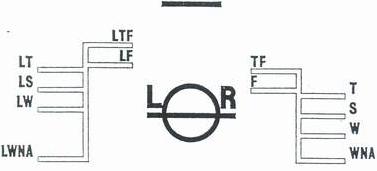
|
Contents |
Index |
Ship, Shipping Operations and Shipping Terms |
||
|
Page |
347 |
|||
Convention allows for a smaller freeboard for large ships, but calls for more stringent protection of openings in decks and superstructures. The tabular freeboard of dry cargo ships, if fitted with steel watertight hatch covers, has been considerably reduced.
Load lines. The deck line and load lines, laid down in Load Line Rules, are marked on the ship’s side as follows.
The deck line is a horizontal line 300mm in length and 25mm in breadth marked amidships with its upper edge passing through the point where the continuation outwards of the upper surface of the freeboard deck intersects the outer surface of the shell.
The load line disc is 300mm in diameter, intersected by a horizontal line 450mm in length and 25mm in breadth, the upper edge of which passes through the centre of the disc. The disc is marked amidships below the deck line.
The horizontal lines are 230mm in length and 25mm in breadth which extend from, and are at right angles to, a vertical line marked 540mm forward of the centre of the disc and which indicate the maximum depth to which the ship may be loaded in different circumstances and in different seasons. These lines are as follows:
Figure 5.6
SThe Summer Load Line indicated by the upper edge of the line which passes through the centre of the disc and also by the upper edge of a line marked S.
WThe Winter Load Line indicated by the upper edge of a line marked W. This is 1/48 of the summer draught below S.
WNA The Winter North Atlantic Load Line indicated by the upper edge of the line marked WNA. This line is not marked on a vessel over l00m in length. The line is 50mm below W.
TThe Tropical Load Line indicated by the upper edge of a line marked T. T is 1/48 of the summer draught above S.
FThe Fresh Water Load Line in summer indicated by the upper edge of a line marked F. This is the distance above S equal to the “Fresh Water Allowance” (FWA).
TF The Tropical Fresh Water Load Line indicated by the upper edge of the line marked TF. This is above the T line by a distance equal to the FWA.
(See also Timber Load Lines and Fresh water allowance.)
The letters marked alongside the disc and above the line through the centre of the disc indicate the name of the classification society, for example Lloyd’s Register of Shipping (L.R.) which may assign the freeboard.
In all cases the freeboard is indicated by the vertical distance from the upper edge of the deck line to the upper edge of the load line in question.
|
Contents |
Index |
Ship, Shipping Operations and Shipping Terms |
||
|
Page |
348 |
|||
The load lines S, W, WNA and T indicate the maximum draught in salt water. The maximum depths to which a ship may be loaded in different seasons in the various parts of the world are laid down in the Load Lines Rules 1968.
The world has been divided into various “load line zones” and seasonal areas. These are shown in a chart carried on board the vessel. (See Appendix VIII for a facsimile of the Load Line chart.) These zones govern the depth to which a vessel may be loaded.
A vessel passing in the course of her voyage from one zone or area into another zone or area, in which another load line applies, must have been loaded in such a way that when she arrives in the zone or area in question, her mean draught will not be in excess of the maximum draught allowed in the second zone or area.
The following example will serve to explain the position:
A vessel has the following deadweights when loaded to the appropriate loadlines:
|
Winter: |
9,650 metric tonnes |
|
Summer: |
10,000 metric tonnes |
|
Tropical: |
10,350 metric tonnes. |
The vessel can be fixed to load a full cargo of grain at Santos at a good freight rate for Hong Kong, calling at Cape Town and Singapore for fuel and water.
Daily consumption (tonnes per day): Fuel—20
Water— 10
Reserves to be kept on board at all times: 5 days fuel and water.
|
Passages: Santos—Cape Town |
10 days; all Summer |
|
Cape Town—Singapore |
15 days; Summer, then Tropical |
|
Singapore—Hong Kong |
4 days; 2 days Tropical then |
|
2 days Summer. |
Assuming the vessel loads to its Summer marks at Santos and takes only the essential fuel and water
|
for each part of the voyage: |
||||||
|
Port/Passage |
Deadweight |
Excess |
Cargo |
Assumed deadweight |
||
|
Allowed |
Assumed |
Fuel |
Water |
|||
|
Dep. Santos |
10,000 |
10,000 |
9,550 |
300 |
150 |
|
|
San—C. Town |
10,000 |
9,700 |
— |
9,550 |
200 |
100 |
|
Arr. C. Town |
100 |
50 |
||||
|
Lift at C. Town |
10,000 |
10,150 |
150 |
9,550 |
300 |
150 |
|
Dep. C. Town |
400 |
200 |
||||
|
Cape—S’pore |
10,350 |
9,700 |
9,550 |
300 |
150 |
|
|
Arr. S’pore |
100 |
50 |
||||
|
Lift at S’pore |
10,350 |
9,820 |
9,550 |
80 |
40 |
|
|
Dep. S’pore |
180 |
90 |
||||
|
S’pore—Sunisner |
10,000 |
9,760 |
9,550 |
40 |
20 |
|
|
Arr. Summer |
140 |
70 |
||||
|
Summer—Hong Kong |
10,000 |
9,700 |
9,550 |
40 |
20 |
|
|
Arr. Hong Kong |
100 |
50 |
The theoretical calculation shows that there would be an excess of deadweight at only one point. Because a decision has been made by management to keep five days reserves at all times, and the only
reduction can be made in cargo, this has to be reduced to 9,400 tonnes. Of course, the reduction in freight can be overcome if space is available, e.g., when leaving Singapore so that additional bunkers can be taken if the price is lower. In practice, the shipowner may keep a smaller reserve or none at all but this
|
Contents |
Index |
Ship, Shipping Operations and Shipping Terms |
||
|
Page |
349 |
|||
can be very dangerous if the vessel meets bad weather or goes to the assistance of another vessel in distress.
Where seagoing vessels navigate a river or inland water deeper loading is permitted corresponding to the weight of fuel, water, etc., required for consumption between the point of departure and the open sea.
When loading in fresh water or in dock or river water of any density less than that of sea water a “Dock Water Allowance” is made for the difference in density.
Lower hold. General cargo vessels may have one or two tweendecks (upper and lower) dividing the cargo compartments into lower hold and tween deck space.
Management agreement. This expression may be connected with the chartering of tankers by the major oil companies on long-term demise charters, combined with a so-called “Management Agreement”. However, in the modern shipping industry many shipowners give their ships out to independent managers under a management agreement. To provide a service to the maritime industry BIMCO produced “SHIPMAN”, a Standard Ship Management Agreement in 1988. (See Appendix IV for a facsimile of the box layout of SHIPMAN, with acknowledgements to BIMCO.) An original form should be used to obtain the best benefit. The boxes on the front contain a brief description of an item and a reference to the relevant clauses in the second part of the form. The clauses contain the details and are, of great importance.
Demise chartered tankers may be operated by oil companies in exactly the same way as their own tankers. All running expenses, including crew’s wages, repairs, docking, insurance, survey, etc., are for charterers’ account. Charterers undertake to maintain the vessel in efficient condition and to redeliver the vessel to her owners in the same good order and condition as when delivered.
Under the so-called “Management Agreement” the owners undertake to operate the tanker on behalf of the charterers in accordance with their instructions—all operating expenses being for charterers’ account—against annual payment on an agreed management fee. Under a “Management Agreement” the shipowners, acting as managers undertake to make all arrangements for operating the tanker according to charterers’ instruction and at charterers’ expense, which implies inter alia:
To appoint the master and officers;
To engage a full complement of officers and crew; To equip and supply the vessel;
To arrange for drydocking, repairs, maintenance, survey, etc; briefly, to do all work normally connected with the commercial operation of a ship.
The question may be raised why the oil companies resorted to chartering by demise, combined with a “Management Agreement”. The explanation is that the volume of chartered tanker tonnage has assumed such proportions that a big organisation would be required to deal with all operating matters.
By bringing foreign owners into the picture for tankers chartered on a demise basis, combined with a “Management Agreement”, advantage was taken of already existing organisations with experience in the operating of ships. A great part of the normal work connected with ships’ operation was thus transferred, so that the necessity to expand the oil companies’ own organisation did not arise.
Manifest. A manifest is a document containing complete specifications of the goods loaded by a vessel for various destinations. As a rule cargo manifests are drawn up by the agents in the ports of loading based upon the information contained in the bills of lading.
The manifest shows: Name of vessel; Port of loading and date of sailing; Port of destination, and in various columns: Number of bills of lading; Marks of packages; Number of packages and contents; Names of shippers and consignees; Notify address, if any; Weight/Cubic measurement; Rate of freight per unit; Total rebate; Net freight.
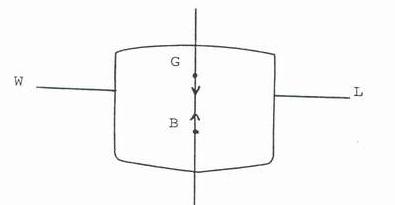
|
Contents |
Index |
Ship, Shipping Operations and Shipping Terms |
||
|
Page |
350 |
|||
In some foreign countries it may be required that manifests be certified by the respective Consul in the port of shipment. Usually Customs authorities require detailed manifests when the vessel arrives in a port to discharge.
Maritime Declaration of Health. When a vessel arrives at a port to which health regulations apply, the master may be required to make a report about the health conditions on board his vessel and also about any circumstances on board which are likely to cause the spread of infectious disease. He needs to make a report if his ship is not a “healthy ship”.
The ship can be an “infected ship” if it has on board on arrival a case of a disease subject to the International Health Regulations or other infectious disease or where a plague infected rodent is found on arrival. A ship is a “suspected ship” if it does not have on board persons who have certain diseases but which has called at some infected places before arrival or where there was cholera on board before arrival or where there is evidence of abnormal mortality among rodents, the cause of which is unknown. A vessel is a “healthy ship” if it is neither infected nor suspected.
Some ports will require even a master of a healthy ship to make a Maritime Declaration of Health despite being given free pratique. (See Free pratique in Chapter 1.) The Declaration contains details of the vessel, the place of issue and date of its deratting or deratting exemption certificate (these are valid for six months), the number of passengers and crew and the list of points of call from the commencement of the voyage with the dates of departure. Then follow six questions concerning:
(a)the outbreak on board of plague, cholera, etc.;
(b)plague or abnormal mortality among the rats or mice on board;
(c)the non-accidental death of any person on board during the voyage;
(d)any infectious disease during the voyage;
(e)the presence of anysick persons on board on arrival;
(f)other condition on board which could lead to infection or the spread of disease.
Depending on the answers to the questions the vessel could be placed into quarantine.
Metacentre. This is the point where the buoyancy force up through the vessel’s centre of buoyancy (B) when the vessel is inclined cuts the original line of force upwards through the original B when the vessel is upright.
Metacentric height. This expression may be explained best by the following figures:
Figure 5.7
The ship is floating upright in still water
WL = Waterline.
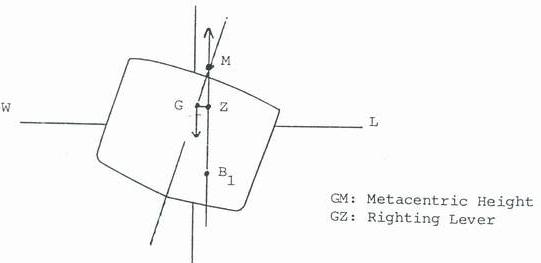
|
Contents |
Index |
Ship, Shipping Operations and Shipping Terms |
||
|
Page |
351 |
|||
G = Centre of gravity.
B = Centre of buoyancy of water displaced by the ship.
G & B are lying in the same vertical line amidships.
The ship is in equilibrium. The upthrust or buoyancy acting through B is equal to the weight of the ship acting downward through G.
Figure 5.8
The ship has inclined to one side through external force and has a slight heel. (Figure 5.8.) The position of G has not changed, assuming the cargo has not shifted.
B1 = New position of centre of buoyancy. Owing to the change of the immersed part of the ship, the position of B has shifted to the lower side (B1).
G and B are no longer lying to the same vertical plane amidships.
M= Metacentre, being the point of intersection of the perpendicular line drawn from B and the plane amidships.
GM = Metacentric height.
GZ = The “arm” or “lever” of the “couple” which has been formed.
The forces of upthrust (buoyancy) and downthrust (weight) are so disposed that there is a tendency for the ship to return to the upright when the inclining force is removed. Hence the vessel is “stable” and GZ is a “righting lever” or “righting arm”.
On an unstable vessel the position of G is higher, which may result from empty double bottom tanks, stowage of cargo on deck, absorption of water in deck cargo, etc. Summarising, the centre of gravity of ship, cargo, water, bunkers, stores and equipment must always be below the metacentre.
The vessel will have:
1.Positive stability if the metacentre is above the centre of gravity.
2.Neutral stability if the metacentre coincides with the centre of gravity in which case there is no righting lever to restore the original position.
3.Negative stability if the metacentre is below the centre of gravity with the risk of capsizing.
If the metacentric height is very large the vessel will be “stiff” and will roll in bad weather at very short intervals, subjecting the ship to heavy strain, which may cause damage to the ship’s structure, apart from the risk of shifting cargo through excessive rolling. If the vessel is inclined as a result of
|
Contents |
Index |
Ship, Shipping Operations and Shipping Terms |
||
|
Page |
352 |
|||
unsymmetrical distribution of weight within the vessel she is said to have a “list”. In this case G will not be in the amidships vertical plane. She may be perfectly stable, but will not remain upright.
On the other hand, if the metacentric height is too small the ship will be “tender”. It will roll less violently and may take a long time to return to the upright. This may also cause danger in heavy weather, possibly because the cargo can shift because of the delay in returning to the upright position. (See also Free surface effect.)
Monsoons. Monsoons are seasonal winds blowing in opposite directions. The territory in which monsoons prevails, extends from 30 S—30 N latitude in those regions in which the oceans are surrounded by vast areas of land:
|
North of Equator |
|
|
North East Monsoon |
October—April |
|
South West Monsoon |
April—October |
|
South of Equator |
|
|
South East Monsoon |
April-October |
|
North West Monsoon |
October-April |
Nautical mile. This is the unit of distance used at sea. It is the length of one minute of latitude and this varies from the equator to the poles. For convenience a standard nautical mile is assumed to be 1,852 metres or 6,080 feet, which is the true length of a nautical mile in about latitude 52 degrees.
On even keel. See Down by the head.
On her beam ends. This term is used to describe a vessel which has listed as a result of shifting of cargo or ballast to such an extent that her deck edge is submerged and her righting power is insufficient to restore the original position.
Out-of-pocket expenses. The out-of-pocket expenses of a vessel in operation only cover the extra expenses which are incurred in comparison with a vessel lying idle in the home port. Wages, food, etc., as well as depreciation charges in full can be deducted from the running costs of the vessel in operation, in order to arrive at the out—of—pocket expenses.
Owners’ agents. If the consignment clause in a charterparty provides for charterers’ agents to be employed at ports of loading or discharge, it is in owners’ interests to appoint their own agents who can assist the matter in any controversy which may arise. Ordinarily charterers’ agents will protect their principals’ interests first and owners’ interests second. Should difficulties arise, the master should be in a position to apply to owners’ agents who are familiar with the custom of the port. Owner’s agents may be called “protecting agents”.
Peak tanks. Distinction is made between the forepeak tank and aft peak tank. The forepeak is the space between the stem and the collision bulkhead. The distance between the stem and the collision bulkhead must be at least 5 per cent of the ships’s length and not more than 8 per cent. (See Collision bulkhead.) The forepeak tank is the part of the forepeak up to the deck.
The after peak tank occupies the space between the stern and the afterpeak tank bulkhead. Both peak tanks may be used for fresh water or ballast.
Plimsoll mark. This name for the load line is derived from Mr. Samuel Plimsoll, a British politician, who
|
Contents |
Index |
Ship, Shipping Operations and Shipping Terms |
||
|
Page |
353 |
|||
strongly advocated measures to cease the practice of overloading vessels and placing the lives of the seamen on board in grave danger.
In 1876 this action resulted in legislation being enacted in the United Kingdom, and this brought the desired result and the Merchant Shipping Act was amended accordingly. (See also Load lines.)
Protest. (See also Sea protest.) A letter of protest or note of protest may be given by the master to various parties such as shippers, charterers, or stevedores, who engage in activities which are unacceptable to the master.
Reserve buoyancy. The submerged part of a vessel provides it with buoyancy. The volume of the enclosed spaces above the waterline is the reserve. They provide additional buoyancy as weights are loaded to immerse the vessel deeper.
Reserve buoyancy determines the depth to which the ship can be loaded and also the assignment of loadlines and freeboards.
Salvage costs. This expression includes all expenses properly incurred by the salvor in the performance of the salvage services. (See Chapter 10.)
Sea protest. In case of damage to a vessel or her cargo or when she has encountered exceptionally heavy weather during the voyage which may have caused damage, the master will register a protest (“note a protest”) before the competent authorities, e.g., notary public or Consul. Such a protest may be extended or completed within a certain limit of time after arrival.
In some European countries a sea protest is essential before the shipowner can declare general average.
Seasonal ports. Ports which are only accessible to ocean shipping during part of the year, such as ports in the St. Lawrence and in the White Sea, are called seasonal ports. Because of ice, these ports and their approaches are closed for navigation between December and spring.
Segregated ballast tanks. These are tanks which must be provided on board crude oil tankers after the MARPOL 1973/1978 Convention entered into force in 1983. Cargo oil and ballast must be segregated to prevent pollution. Segregated ballast is ballast water that is introduced into a tank which is completely separated from the cargo oil and oil fuel system and which is permanently allocated to the carriage of ballast or to the carriage of ballast or cargoes other than oil or noxious liquid substances. (See also Clean ballast.)
Settling tanks. Motorships are fitted with settling tanks. Fuel oil may be contaminated with water, which settles to the bottom of the tank and can be drained. This process is accelerated by heating the fuel oil by steam heating coils. Two tanks are usually fitted.
The capacity of settling tanks is such that alternately the daily quantity of fuel can be drawn from one of the tanks, so that sufficient time is left for the settling of the fuel oil in the remaining tanks. The capacity of each tank can be about 12 hours supply.
Sheer. The sheer of a vessel is the longitudinal curvature of the deck from the lowest point on deck amidships. The average sheer of a general cargo vessel is about 1 per cent of the ship’s length. The sheer may increase the vessel’s reserve buoyancy. Sheer features in the assignment of load lines. (See also
Load lines.)
|
Contents |
Index |
Ship, Shipping Operations and Shipping Terms |
||
|
Page |
354 |
|||
Shifting boards. In older ships loading grain in bulk, all necessary and reasonable precautions were taken to prevent the grain from shifting by fitting shifting boards. For ships fixed for loading a full cargo of bulk grain, the condition that the vessel must be in all respects ready to load not only implied that the cargo compartments had to be clean, dry and ready to receive the cargo of grain, but shifting boards also had to be in place. A surveyor’s certificate tothis effect was produced when serving notice of readiness on the charterer or his agents. Now, ships are designed specially to carry grain safely in bulk and shifting boards may not be necessary. In any case the ship must possess a “document of authorisation”.
Shipbroker. The shipbroker acts as an intermediary between charterers, shippers and consignees of cargo on one side and the shipowners or carriers by sea on the other. The principal functions of a shipbroker are:
(a)Fixing of carters for cargo liners and tramp vessels (chartering brokers)
(b)Acting as chartering agents for large trading concerns
(c)Negotiating the sale or purchase of ships.
Shipowners. The owners of a vessel are the persons or companies officially registered as owners of the ship. The certificate of registry, issued by the registrar, contains the particulars which have been entered in the “register”, concerning the “ownership” of the vessel, in particular:
(a)the name of the ship and home port, i.e., port of registry
(b)the particulars respecting her origin stated in the declaration of ownership.
(c)the name and description of her registered owner; if more than one, the proportionate share of each.
Ship types. The development of ship types has been dictated very largely by technological advances, mechanisation and specialisation for different cargoes carried. The various designs can be divided into different categories, commercial, industrial and service vessels (leaving aside military vessels).
|
SHIP TYPES |
||
|
Commercial vessels |
Industrial vessels |
Service vessels |
|
General cargo ships |
Dredgers |
Tug boats |
|
Container ships |
Pipe-laying vessels |
Off-shore supply |
|
Oil tankers |
Drilling vessels |
boats |
|
Chemical tanker |
Semi-submersjbles |
Crane support |
|
Liquefied gas |
Incinerator vessels |
vessels |
|
carriers |
Hopper barges |
Diving support |
|
Dry bulk carriers |
Fish processing vessels |
vessels |
|
Combination carriers |
Fish catchers |
Fire boats |
|
Ore/Bulk/Oil carriers |
Fisheries research |
Pilot boats |
|
LASH vessels |
ships |
Environmental |
|
(Lighter aboard ship) |
Oceanographic research |
protection |
|
Roll on/Roll off |
vessels |
vessels |
|
vessels |
Ocean mining vessels |
Garbage collection |
|
Integrated tug/barge |
Seismic exploration |
vessels |
|
Heavy lift ships |
vessels |
|
|
Timber carriers |
||
|
Livestock carriers |
||
|
Passenger ships |
|
Contents |
Index |
Ship, Shipping Operations and Shipping Terms |
||
|
Page |
355 |
|||
At the end of 1989, the world fleet trading commercially was (according to Lloyd’s Statistical Tables
|
1989): |
Gross tonnage (‘000) |
Deadweight (‘000) |
|
Ship type |
||
|
Oil tankers |
123726 |
238454 |
|
Ore and bulk carriers |
109509 |
193540 |
|
General cargo |
51680 |
75869 |
|
Container ships |
22735 |
24647 |
|
Ore/bulk/ore carriers |
19973 |
37835 |
|
Liquefied gas carriers |
10054 |
10358 |
|
Oil/chemical tankers |
5852 |
9900 |
|
Chemical tankers |
3409 |
5850 |
Six of these ship types are illustrated in Figures 5.9 to 5.14. The illustrations are meant to be very fundamental to show certain features and plans, profiles and midship sections.
Signed under protest. If charterers or shippers object to the insertion of a certain clause in the bills of lading, the master may sign the bills of lading under protest. The words “signed under protest” affect the master’s signature so that it cannot be produced as evidence.
Should there be any serious doubt as to the correctness of the quantity or weight inserted in the bills of lading, it is necessary to include the qualification “signed under protest” in the bills of lading, or to have an official protest drawn up. Alternatively, the master may give to the other side a “letter of protest”.
Sounding. See Ullage.
Stability. The stability of a ship is the tendency she possesses to return to her original position after she has heeled because of external forces. The stability of a ship mainly depends upon the metacentric height. (See Metacentric height.)
Stowage factor (SF). This is the numeral, which expresses the volume (space) in cubic metres or cubic feet occupied by a unit mass of cargo, i.e., 1 tonne (1 metric ton) when stowed. It is an empirical figure reached by experience of previous stowage and takes into account “broken stowage” and dunnaging. For example, the actual volume occupied by 1 tonne of a piece of cargo may be 2.5 cu. in. but because of its awkward shape and the need to separate it from other, adjacent cargo, it will occupy 2.73 cu. m. The SF is then said to be 2.73.
Before general metrication, stowage factors were given in cubic feet per ton (of 2,240 pounds). Indeed, these figures were easier to remember. For example, jute in bales stowed at about 65 (ft3 /ton). The metric SF is about 1.81.
It must be stressed that SFs are always quite approximate values and the actual space taken up by a parcel of cargo will depend on the care taken in stowing it, the shape of the compartment, the type of dunnage used, the form of packing, the need for a greater or lesser segregation from other cargo in the same compartment and even the season in which the cargo is loaded. SFs are therefore useful at the planning stages before a cargo is loaded so that it can be considered how best to load the cargo on board the vessel or in a container to maximise the space used with the greatest safety.
In the case of bulk liquids, SF is replaced by SG—the “specific gravity”—which is the mass (tonne) per unit volume (m3). This is because bulk liquids will fill the compartment into which they are loaded.
Stowage plans. See Cargo plan.
|
Contents |
Index |
Ship, Shipping Operations and Shipping Terms |
||
|
Page |
356 |
|||
Subsidies. A subsidy is a financial assistance for shipping. There are many types of subsidies. Their main purpose is to help develop shipping activities or to assist a national fleet in the face of foreign competition. Subsidies can be long-term or permanent or used only when shipowners are faced with financial fiscal difficulties. Subsidies can be directly paid to shipowners or indirectly assist the shipping industry.
Construction, credit, insurance, operating and scrap-and-build subsidies are some of the many direct subsidies. Indirect assistance can include shipbuilding, taxation and depreciation allowances, and reductions in port and canal tolls for national flag carriers. Subsidies are one form of protectionism and can act against free competition in the market of shipping industry.
In the United States, the Constructional Differential Subsidy (CDS) and the Operating Differential Subsidy (ODS) were quite notorious after the Second World War. The U.S. flag fleet operating in foreign trades is usually subsidised. Before the Reagan Administration, U.S. flag ships had to be built in the U.S. and have U.S. crews. The shipowners were guaranteed differences between their own costs and those of typical competition by the CDS and ODS. During the Reagan Administration, additional CDS funding ceased so the shipyards could build ships only for the coastal trades where no subsidies were given. Even the ODS was cut back.
Sweating. See Ventilation.
Tally. Upon delivery of cargo, the number of packages is checked by tally clerks. The information on tally clerks’ sheets is inserted on the mate’s receipts and bills of lading.
Tarpaulins. In older, general cargo ships, before proceeding to sea it is customary to place three tarpaulins over the hatch covers, thereby ensuring watertightness. The tweendeck hatches may also be covered by a tarpaulin.
Timber Load Lines. Special timber load lines can be used only when a ship carrying a cargo of timber on deck complies with the Load Line Rules.
For the carriage of timber as deck cargo, the IMO “Code of Practice for Timber Deck Cargoes” must be followed.
The timber deck cargo must be compactly stowed, lashed and secured. It must not interfere in any way with the navigation and necessary work of the ship or with the provision of a safe margin of stability at all stages of the voyage, regard being given to additions of weight, such as those due to absorption of water and to losses of weight, such as those due to consumption of fuel and stores.
During the winter season the height of the timber deck cargo above the weather deck may not exceed one-third of the extreme breadth of the ship. At other times the regulations do not prescribe any limit. The deck load may be built up to any height, consistent, of course, with the general requirements of safety and stability, and must not exceed the designed maximum permissible load on the weather decks and hatches. The height of the deck cargo should be restricted so that the visibility from the navigation bridge is not impaired and any forward facing profile of the timber cargo on deck does not present overhanging shoulders to a head sea.
Ship’s personnel must also be protected and, if timber cargo is carried on deck, guard rails or guard lines must be provided on each side of the deck cargo, together with a lifeline to allow the crew to move along the surface of the timber over the length of the ship. The IMO “Code of Safe Practice for Ships Carrying Timber Deck Cargoes” contains many more guidelines, all aimed at overall safety.
The special timber load lines are marked on the ship’s sides as follows (the “L” standing for “lumber”,
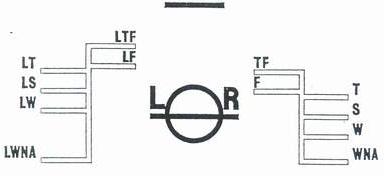
|
Contents |
Index |
Ship, Shipping Operations and Shipping Terms |
||
|
Page |
357 |
|||
another word for wood):
LS = The Summer Timber Load Line indicated by the upper edge of a line. LW = Winter Timber Load Line.
LWNA = The Winter North Atlantic Timber Load Line. This is level with the WNA Line. LT=The Tropical Timber Load Line.
LF = The Fresh Water Timber Load Line in Summer.
LTF = The Fresh Water Timber Load Line in the Tropical Zone.
Figure 5.15
In all cases the freeboard is indicated by the vertical distance from the upper edge of the deck line to the upper edge of the load line in question. The lumber freeboard is less than the normal summer freeboard to indicate that the timber may add to the ship’s superstructure volume and thus improve the
|
reserve buoyancy. |
|
|
(See also Load lines.) |
L |
Tonnage marks. These are marks, which are painted on the sides of some ships whose tonnage is measured as if the space between the upper deck and the second deck from above is not included in the tonnage. The tonnage that these ships have is called either “modified” or “alternative” tonnage. (See Modified Tonnage in Chapter 6.)
TPC. Tonnes per Centimetre Immersion. If the vessel is loading in salt water and the freeboard is checked it may be found that more cargo can be loaded to immerse the ship another few centimetres. It is useful to convert this to tonnes. This is the TPC. The TPC varies with the draught and with the water density. Changes in draught cause a change in displacement and the TPC assists in calculating the change. TPC can be calculated by the formula
TPC = (A) x (d)
100
where A = area of water plane at a certain draught and d= density of water in which the ship floats.
Trim. The trim of a vessel is the difference between the draughts fore and aft. If the draught fore and aft is the same, the vessel is “in trim” or “on even keel”.
If charterers have the option to take delivery of the cargo in more than one port, it is important that the ship will be in seaworthy trim upon sailing from the first port of discharge, i.e., that the draught fore and aft will be such that the ship can proceed on her voyage without affecting its manoeuvrability or safety. It is preferable to arrange for a deeper draught aft than forward, in order to have a more manageable ship in
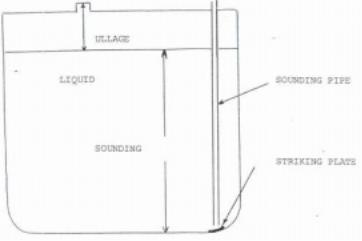
|
Contents |
Index |
Ship, Shipping Operations and Shipping Terms |
||
|
Page |
358 |
|||
good trim.
It may be added that where a bulk cargo is to be discharged at two or more ports it is customary to stipulate in the charterparty “the vessel is to be left in seaworthy trim between ports of discharge”. If the master has not been informed of the intention of the charterers to exercise the option of discharge at more than one port at the time of loading, additional expenses may be incurred at the first port of discharge to comply with the “safe trim” requirement. These additional expenses are recoverable from the charterers. Leaving the vessel in seaworthy trim may involve more measures and expenses than seeing to the proper draught fore and aft.
“Trim” also refers to the leveling of a bulk (or other dry cargo) either to make more space for other cargo or to prevent the shifting of dry bulk cargo.
Tween deck. General cargo vessels may have one or more tweendecks (upper and lower) dividing the cargo compartments into lower hold and tween deck space. There may be more than one tween deck in older style general cargo ships and certain passenger ships.
Ullage. This is a measurement of space between the surface of liquid in a tank and the top of the tank inner surface. Ship’s ullage tables are drawn up, based on the internal volume of a tank measured from some reference point, e.g., the lip of an “ullage” hole. The reverse of ullage is sounding. This is the depth of liquid in a tank measured from the liquid surface to some reference point at the bottom of the tank “Sounding tables” may complement or replace “ullage tables”. (See Figure 5.16, p. 456.)
This expression covers the free space left in the tanks after loading liquids in bulk. In oil tankers, ullage is left in order to leave room for expansion when the oil is heated to a higher temperature before discharge. Oil can also expand with atmospheric temperature changes so that oil tanks are customarily loaded to 98 per cent capacity.
Unseaworthiness. If the condition of a vessel is such that she is not reasonably fit in all respects to encounter the ordinary perils of the sea, either by insufficient maintenance and repairs, incomplete crew, insufficient equipment or wrong stowage of cargo, etc., she is referred to as being unseaworthy. Unseaworthiness can affect charterparties and other contracts of carriage of goods by sea and can also affect the shipowners’ protection under his marine insurance policy. (See Seaworthiness in Chapters 1 and 3 and also Chapter 8.)
In addition to these problems, many ports exercise port state control, whereby they inspect ships visiting their ports and if the ships are so unseaworthy as to be dangerously unsafe, the penalties for the shipowner and the master can be very high. The ship can also be detained.
Figure 5.16
|
Contents |
Index |
Ship, Shipping Operations and Shipping Terms |
||
|
Page 359 |
||||
|
Ventilation. Cargo |
damage due to climatic conditions includes such effects as mould formation, |
germination of grain, corrosion and rust on metals, and wetting of sensitive materials such as leather. The general cause of such damage is condensation from various sources.
Ventilation of cargo spaces cools the cargo (or warms it if necessary) so that temperature differences between the cargo and the atmosphere are kept to a minimum. Ventilation also prevents the accumulation of moisture in the cargo space, whether this be a cargo hold or a container, thus reducing condensation within the space. The purposes of ventilation also includes dissipation of gases which can be flammable and/or noxious, removal of heat, and removal of taint which can damage odour-sensitive cargo. Considerable harm can be done to some cargoes by ventilating too much and to others by not ventilating at all. Some cargoes, which contain moisture, may give off this moisture on the sea passage. These are called “hygroscopic” cargoes. Moreover, if cargoes are loaded in a-cool climate and then the vessel travels to a warmer climate any incoming air may condense on the cargo. Cargo may then give off moisture. This is known as “cargo sweat”. If the ship loads in a warmer climate -and proceeds to a cooler climate, the cold sea temperature will cause the air in the hold to condense on to the ship’s structure and can also damage cargo. This is known as “hold sweat” or “ship’s sweat”.
For example, if canned goods are loaded in New York in winter for transit through the Panama Canal, the cans will not be much warmer on approaching the Canal than when they were loaded. However, the outside temperature will have risen, as will the “dew point”. (The dew point of the air is the temperature of a glass or metal object just cold enough to cause dew to appear on it when exposed to that air.) Ventilation will cause the outside air to enter the cargo space and deposit moisture on to the colder cans. This would be cargo sweat.
On the other hand, if bags of rice are loaded in Burma in December for discharge in Japan, as the vessel proceeds to the destination the vessel’s steelwork becomes cooler but the cargo retains much of its high temperature in the cargo spaces. Rice is a hygroscopic cargo. The warmth inside the mass of rice will cause an upward current of air from the cargo to condense underneath the cold decks or container tops and this moisture can be deposited on the cargo.
Washplate. In order to minimise the movement of fuel oil or water in partially filled tanks during heavy weather, thereby exposing the tanks to heavy strain, longitudinal washplates are fitted, thus reducing the free surface.
(See also Free surface effect.)
Watch system. At sea the day of 24 hours is divided into duty periods or watches with traditional names:
|
Afternoon watch |
Noon—4 pm. |
|
First dog watch |
4 pm—6 pm |
|
Last or second dog watch |
6 pm—8 pm |
|
(The two dog-watches are combined into the “evening watch”) |
|
|
First watch |
8 pm—midnight |
|
Middle watch |
Midnight—4 am |
|
Morning watch |
4 am—8 am |
|
Forenoon watch |
8 am—noon |
WORLDSCALE. On 1 January 1989, a “New tanker nominal freight scale” took the place of the old system of freight scales for tankers called simply “Worldscale”. The new system, with a new basis of calculation of the freight rates, was called “New Worldscale”. However, by 1 January 1990, this had become so accepted in the tanker markets that the word “new” was dropped.
The Worldscale system generally governs tanker fixtures and freight rates and the system is an index
|
Contents |
Index |
Ship, Shipping Operations and Shipping Terms |
||
|
Page |
360 |
|||
based on the cost of operating a standard tanker on the route chosen for the fixture. The index is changed every six months by the Worldscale Association with offices in New York and London and published in books which are distributed to subscribers to the service. The changes reflect the actual changes in the costs for the standard vessel.
Basis of calculation: All rate calculations, which are made in U.S. dollars, are per tonne for a full cargo for the standard vessel based upon a round voyage from loading port or ports to discharging port or ports and return to first loading port using the under-mentioned factors.
All of the factors shown are purely nominal and for rate calculation purposes only. In particular, the fixed hire element of US$12,000 per day is not intended to represent an actual level of operating costs, nor to produce rates providing a certain level of income or margin of profit, either for the standard vessel or for any other vessel under any flag.
(a)Standard Vessel
Total Capacity 75,000 tonnes
(i.e., the vessel’s capacity for cargo, plus stores, water, and bunkers, both voyage and reserve).
|
Average service speed |
14.5 knots |
|
Bunker consumption steaming |
55 tonnes per day |
|
Purposes other than steaming |
100 tonnes per round voyage |
|
In port |
five tonnes for each port involved in the |
|
Grade of fuel oil 380 centistokes |
voyage |
(b)Port Time
Four days for a voyage from one loading port to one discharging port; an additional 12 hours being allowed for each extra port involved on a voyage.
(c)Fixed Hire Element
US$12,000 per day
(d)Bunker Price
US$74.50 per tonne
This price represents the average worldwide bunker price for fuel oil (380 cst) during September 1988 as assessed by Cockett Marine Oil Limited (of London).
(e)Port Costs
Port costs used are those assessed by the Worldseale Associations in the light of information available to them up to the end of September 1988, the rate of exchange used for converting costs in a local currency to U.S. dollars being the average applicable during September 1988.
(f)Canal Transit Time
24 hours is allowed for each transit of the Panama Canal 30 hours is allowed for each transit of the Suez Canal. Mileage is not taken into account in either case.
(g) Laytime
The fine allowed for loading and discharging shall be 72 hours and shall be subject to whatever qualifications, if any, in the charterparty.
|
Contents |
Index |
Ship, Shipping Operations and Shipping Terms |
||
|
Page |
361 |
|||
(h)Route Policy/Distances
The following route indicators are used in the Schedule and when quoting rates:
C which means via Cape of Good Hope, laden and in ballast.
|
CS |
which means via Cape of Good Hope, laden, Suez Canal in ballast. |
|
S which means via Suez Canal, laden and in ballast. |
|
|
P which means via Panama Canal, laden and in ballast. |
|
|
CP |
which means via Cape of Good Hope, laden, Panama Canal in ballast. |
|
H which means via Cape Horn, laden and in ballast. |
|
|
CH |
which means via Cape of Good Hope, laden and in ballast, and Cape Horn, |
|
laden and in ballast. |
Судно
не приспособлено для лоцманского трапа.
1. Permission
to take pilot, at… UTC , have , in position… you. —
INFORMATION. —
2. embark,
at…hours local time , will, pilot —
3. vessel, your,
pilot boat, approaching , is —
. pilot, on , port
side , keep boat —
. pilot transfer,
change to , for, VHF channel —
. wait for, in,
pilot, in present, stop , position and —
. pilot transfer,
for, VHF channel, change to —
. completed , stand
by , until, pilot transfer , on VHF channel —
. suspended ,
pilotage at, (name) Pilot Station ,until… (date and local time) —
. due to , Pilot
Station , cannot, pilot, embark at —
(Abridged from the
IMO Standard Marine Communication Phrases) Exercise 14. Standard Marine
Communication Phrasesthe word order in the following sentences right or wrong?
Correct the sentences thai are wrong. Follow the examples given in the first
and the second sentences Examples:
1…… INFORMATION.
Pilot ladder has broken steps.
Right
2. INFORMATION.
You may navigate by yourself (or wait for pile
at… station),
… Wrong
INFORMATION. You may navigate by yourself (or wait for pile at… buoy).
3. INFORMATION.
Pilotage at (name) Pilot Station resumed.
4. INFORMATION.
Pilot boat approaching.
. INFORMATION.
Pilot will embark at…hours local time.
. INFORMATION. You
are exempted from pilotage.
. INFORMATION.
Pilotage at (name) Pilot Station suspended until…(date and time).
. INFORMATION.
Pilot cannot embark at (name) Pilot Station because…
. INFORMATION.
Pilot ladder unsafe.
. INFORMATION.
Embarkation possible.
11.INFORMATION.
Vessel suited for pilot ladder.
12.INFORMATION.
My ETA at… (name) Pilot Station… hours local time.
13. INFORMATION.
Boarding arrangements do not comply with SOLAS -Regulations.
(Abridgedfrom the
IMO Standard Marine Communication Phrases).15. Re-order the following groups of
words to make questions.the example given in the first sentence:
1.pilot,
take , I, must Must I take pilot?
2.require,
you , do , pilot
3. at…, (name)
Pilot Station ,you, do ,pilot, require
. is ,ETA, at…
(name)Pilot Station ,what ,your, in , local time
. local, is , time,
what
. Present, what,
your position
. distance , (name)
Pilot Station , what, your, is from
. station, pilot
boat, on , is
. position , I,
Pilot, can, what, take, in
. will, embark ,
pilot ,when
. freeboard, is,
your, what
. accept, shore
based navigational, do, assistance , you, from, pilot
. wrong , what,
with , is , pilot ladder16. Make the following sentences into questions
acceptable in standard communications (IMO SMCP). Follow the example given in
the first sentence Example:
1.
Do you know when the pilot will
embark? …QUESTION. When will pilot embark?…
2.
Could you please tell us if you
require pilot?
3. Could you tell
me your ETA at… (name) Pilot Station?
. Would it be
possible for you to inform us whether you can proceed without pilot?
. Could you tell me
what your freeboard is?
. Do you know if a
pilot boat is on the station?
. Could you tell us
what your present position is?
. Do you know the
local time?17. Fill in the missing words in the text belowfrom the following
list using appropriate form of the verb
must manoeuvre call
for may hoist mean require
come embark meet show
to
In some ports,
ships. take pilots. They…… take pilots…… the ship
into or out of the
harbour. Ships may……………………………. a pilot by radio or by
hoisting the signal. They……………….. also call for a pilot by
radiotelephone. Ships usually the International Code Flag «G». This
flag «I require a pilot». Soon the pilot boat
alongside the ship
and the pilot her. The watch officer…. the pilot at
the ladder. Then he……… him the
bridge.
. Match the
opposites
|
1. to arrive |
a) to disembark |
|
2. to berth |
b) to complete |
|
3. to proceed |
c) to depart |
|
4. to start |
d) to unberth |
|
5. to embark |
e) to stay |
|
6. to resume |
f) to break |
|
7. to repair |
g) to suspend |
|
8. to keep |
h) to hoist |
|
9. to low |
i) to increase |
|
10. to decrease |
j) to move |
. Choose the right
answer
1. Where may
pilots be obtained?
a)
from the office of the Harbour
Master
b)
from the port pilot station
c)
in the offing
2. What flag
should a vessel display when she requires pilot in daylight?
a)
the flag «H»
b)
the flag «G»
c)
the flag «K»
3. What does
the flag «G» mean?
a)
I have a pilot aboard
b)
I require a pilot
c)
I want to communicate with you
4. What is
the signal for a pilot at night?
a)
the flag «G»
b)
blasts on the ship’s siren
c)
blasts on the ship’s whistle
5. What must
captains indicate when requesting pilots by?
a)
the ETA of the ship
b)
the name of the ship
c)
the draught of the ship
Exercise 20. Match
the synonymes
1.
to inform a) to understand
2.
to depart b) to unload
3.
to arrive c) to contact
4.
to acknowledge d) to berth
5.
to comprehend e) to leave
6.
to communicate f) to come
7.
to moor g) to confirm
8.
to discharge h) to advise
9.
to carry out i) to get
10. to
receive j) to fulfill
Exercise 21. Which
letter flags deal with the topic «PILOTAGE AND PILOTS»? Name
them5activitywatching the video programme «Bridge Routines » study
the dialogue and be ready to watch the film:ship is at sea, running up to the
Pilot Station. The entire action, with the exception of the Third Officer’s reply,
takes place inside the wheelhouse.are the Master, the watchkeeping Officer
(2/0), a helmsman and the Pilot.
|
Pilot (to 2/0): |
Half ahead. |
||
|
2/0 (Rings Telegraph): |
Half ahead, Pilot. |
||
|
Pilot: |
Starboard Ten. |
||
|
Helmsman: |
Starboard Ten, Sir. |
||
|
Pilot: |
Midships. |
||
|
Helmsman: |
Midships, Pilot. |
||
|
Pilot: |
Steer zero zero three. |
||
|
Helmsman: |
Midships. Steady on zero zero |
||
|
Pilot: |
Dead slow ahead. |
||
|
2/0 (Rings Telegraph): |
Dead slow ahead, Pilot. |
||
|
Pilot (to helmsman): |
What is your course? |
||
|
Helmsman: |
My course is zero zero three, Sir. |
||
|
Pilot (to Master): |
Captain, we are coming up to the |
||
|
water. |
|||
|
Master (to Pilot): |
Yes, Pilot. |
||
|
Master (on radio): |
«Arabiyah» Captain to |
||
|
3/0 (on deck, on radio): |
«Arabiyah» Third Mate to |
||
|
Pilot (to Master): |
Captain, when I’ve left, keep |
||
|
Master (to Pilot): |
Alter course at the fairway buoy. |
||
|
3/0 (to Pilot): |
The Pilot boat is approaching, |
||
|
Pilot: |
Please, sign my papers, Captain. |
||
|
Master: |
Certainly, Pilot. |
||
|
Pilot: |
Thank you. Good-bye, Captain. |
||
|
Master: |
Thank you, Pilot. Third Mate, |
||
|
3/0: |
Yes, Sir. |
||
|
Master (to 2/0): |
Stop Engines. |
||
|
2/0 (to Master): |
Engines stopped, Sir. |
||
|
Master (to helmsman): |
Steady. Let me know when she does |
||
|
Helmsman (to Master): |
Steady on zero zero three, Sir. |
||
UNIT 5. LIGHTS
PART
I. Vocabulary and reading
these words orally
and learn them by heart
Light — огонь
fa Alternating I. — переменный
огонь
fa Anchor I. ~ якорный
огонь
fa Fixed I — постоянный огонь
fa Flashing I — проблесковый
огонь
fa Front I. — передний огонь
fa Group-flashing I. — группо-проблесковый
огонь
fa Group-occulting I — группо-затмевающийся
огонь
fa Leading I. — створный
огонь
fa Masthead I. — топовый
огонь
fa Navigation I. — ходовой
огонь
fa Occulting I. — затмевающийся
огонь
fa Rear I. — задний огонь
fa Revolving I — вращающийся
огонь
fa Riding I. — штаговый
огонь
fa Stern I — гакабортный огонь
fa Unwatched I. — необслуживаемый
огонь
fa Isophase light I. — изофазный
огонь
fa Eclipse — затмение
fa Elevation — высота
(над
уровнем
моря)
fa Exhibit показывать,
выставлять,
зажигать
(огонь)
fa Flash — вспышка, проблеск;
подавать
световой
сигнал
fa Height — высота (объекта)
fa Lantern — фонарь fa To
obscure — затемнять
fa Show — показывать,
выставлять
(огонь)
fa Visibility — видимость
fa Visible ~ видимый fa
Structure — постройка,
сооружение
fa Pile — столб, свая
fa Pillar- стойка, столб
fa Pole ~ столб, шест
fa Post — столб, веха
fa Staff- шест, шток
fa Tower ~ башня fa Mast- мачта1.
Scan the text and complete the chartare used to ensure safe navigation. There
are several types of lights. The main of them are the following:Fixed light is
a light that shines continuously. Its abbreviation is F. All lights are
indicated by abbreviations on nautical charts.Flashing light is a light with a
short light interval anda long dark interval. Its abbreviations is FI, but in
nautical charts the abbreviations of the corresponding rhythms
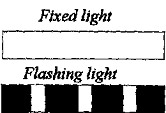
(quick — 50-80 flashes per minute) or VQ (very quick — 80-160 flashes per
minute) are used.characteristic of the Occulting light is contrary to that of
the flashing light: the occulting light has a long light interval and a short
dark interval. In other words: it
an interrupted
light.abbreviation is Oc/Occ.lights are flashing or occulting lights in which
the light-intervals are exhibited in groups that are repeated at regular
intervals, for example F (3) or Oc (2).Isophase light has a light interval and
a dark interval of equal durations. Its abbreviation is ISO.lights are mostly
of white (W), red (R), blue

(BVBu) and green
(Gt) colour. In case a light changes its colour it is called
alternating.Alternating light (Al) is a light that shows different colours
alternately, for example ALWGR (Alternating light White/ Green/ Red).Morse Code
light is a light in which appearances of light of two clearly different
durations are grouped to represent a character or characters in the Morse
Code.applications of the types of light are determined by the fact whether a
light is conspicuous or not.most conspicuous light by far is the Flashing
light. Therefore it is always used to indicate danger.least conspicuous light
is the Fixed light Therefore it should merely be used to illuminate an object
or an area.are exhibited from different conspicuous structures, such as towers,
poles, posts, buoys, beacons, staffs, masts and lighthouses.2. Before
completing the table watch the CD-ROM pro-gram «International Maritime
English Programme » (Lights)
|
Types of lights |
Characteristics |
Exercise 3. Answer
the questions
1.
What types of lights are mentioned
in the text?
2.
What light shines continuously?
3.
What is the characteristic of Fl?
4.
What do abbreviations Q and VQ mean?
5.
What is the difference between Fl
and Oc?
6.
Which light has light intervals
equal to dark intervals?
7.
What is Al?
8.
What are group lights?
9.
What light is the most conspicuous?
10. What is a
fixed light used for?
Exercise 4. Find in
the text above the English equivalents for the following words and expressions
1.
Изофазный
огонь
2.
хорошо
видимый (приметный)
3.
шест,
шток
4.
столб,
шест
5.
постоянный
огонь
6.
башня
7.
затмевающий
огонь
8.
столб,
стойка
9.
переменный
огонь
10.
морская
карта
11.
показывать
(выставлять) огонь
12.
проблесковый
огонь
13.
огонь
Морзе
14.
группо-затмевающийся
огонь
15.
очень
быстрый проблесковый огонь
Exercise 5. Choose
the correct answer
1. A light
which is constantly visible.
a)
a flashing light
b)
a fixed light
c)
an occulting light
d)
an isophase light
2. A light
which changes its colour is …
a)
flashing
b)
green
c)
red
d)
alternating
3. A light
which has a light and a dark interval of equal durations is …
a)
constantly invisible
b)
isophase
c)
occulting
d)
leading
4. A light
which has a longer light interval and a shorter dark one.
a)
an occulting light
b)
an isophase light
c)
a fixed light
d)
a flashing light
5. The
duration of eclipse is longer than that of light.
a)
a flashing light
b)
a fixed light
c)
an occulting light
d)
an isophase light
6. The most
conspicuous light by far is …
a)
a fixed light
b)
a flashing light
c)
an isophase light
d)
an occulting light
Exercise 6. Read
andtranslate passages from Pilot Books. Check yourself by finding the
corresponding Russian translation
|
1. K. light is exhibited, at an |
a) |
4.
В.
and N. lights in line, bearing 149°, 1 lead to the harbour. 5. Two lights,
disposed vertically at ele vations of 20 and 26 feet (6ml and 7m9), are
exhibited from a white con crete mast with black bands, 16 feet (4m9) in
height, situated on the head ofthemole.fi <#»528383.files/image037.gif»> Light structure — маячная
постройка
Р^
Truncated structure — пирамидальная
постройка
Р*
Brick — кирпич;
кирпичный
Р»
Concrete — бетон; бетонный
Р^
Iron — железо;
железный
^ Steel — сталь; стальной
Р5″
Stone — камень;
каменный
Р^
Wood-дерево
Р5′
Wooden деревянный
Р»
Angle — угол
Р^
Circular — круглый Р»
Hexagonal — шестиугольный Р5″
Octagonal — восьмиугольный Р»
Pyramidal пирамидальный Р^
Quadrangular — четырёхугольный
^Rectangular прямоугольный Р=»
Square квадратный
Р^
Triangular — треугольный18.
Read the text and answer the questionslighthouse is a structure exhibiting a
light. This light serves as an aid to navigation. Lighthouses are always
conspicuous.are built on land and at sea. In most cases lighthouses are erected
on solid foundations.vary in shape. They can be circular, pyramidal,
quadrangular, square, cylindrical triangular, rectangular, hexagonal and
octagonal. They are built of stone, brick, concrete, iron, steel, wood, etc.are
painted white, yellow, red, etc. Sometimes they are painted in horizontal and
vertical stripes of different colours. (A band is a horizontal line, a stripe
is a vertical line). The lights may be fixed, flashing, occulting, alternating,
group-flashing.leading lights are exhibited, the front light is always lower
than the rear light.may be connected to the telephone system for life-saving
purposes.
1.
What purpose does a lighthouse
serve?
2.
Where are lighthouses built?
3.
What shape can lighthouses be?
4.
What material are lighthouses built
of?
5.
What types of lights may be
exhibited from lighthouses?
6.
What does the Odessa lighthouse look
like?
7.
Which light is exhibited higher, the
front or the rear one?
Exercise 19.
Translate from Russian into English
1.
Маяк
— постройка, на которой выставлен огонь.
2.
Маяки
устанавливаются на берегу и в море.
3.
Маяки
могут иметь ажурное основание.
4.
Имеются
различные формы маячных построек.
5.
Для
постройки маяков используются различные материалы: камень, фпич, железо, сталь.
6.
Огни
бывают разного цвета: зелёные, белые, красные, жёлтые.
7.
На
маяках выставляются постоянные, переменные, проблесковые, задевающиеся и другие
огни.
8.
На
плавучий маяк нельзя полагаться.
9.
Находится
ли маяк на своём штатном месте?
10.
На
каком расстоянии от порта находится этот маяк?
11.
Плавучий
маяк окрашен в красный цвет со словом «Санкт-1етербург» на его бортах.
12.
Какой
пеленг этого маяка? — Пеленг этого маяка 85°.
Exercise 20. Ask
questions using the model1: This light is exhibited at an elevation of 10 feet.
What elevation is this light exhibited at?
1.
A red light is exhibited at an
elevation of 9 feet.
2.
An alternating light is shown at an
elevation of 141 feet.
3.
A fixed light is placed at an
elevation of 50 feet.
4.
A group flashing light is exhibited
at an elevation of 37 feet.
Model II: Castle
harbour is situated on the eastern coast. Where is Castle harbour situated?
1.
This lighthouse is built on land.
2.
A metal tower is situated westward
of Drum point.
3.
A flashing green light is exhibited
at the head of a breakwater.
Exercise 21. Fill
in the gaps with appropriate prepositions
1._________________ A
light is exhibited_____ an iron column, 7 feet height, situated the
head of the jetty.
2.
The lighthouse is connected_ the
telephone system__ life-saving purposes.
3.
A fixed light is exhibited_ an
elevation___ 10 feet,___ black and white
wooden post,
situated______________ the outer extremity_______ the mole the entrance____________ A.
harbour.
4.
Lighthouses are located land or __ sea.
5.
A lightboat, painted red is moored__ the
edge___ the shoal.
6.
Lighthouses vary_ appearance. They
are built___ steel, stone, wood,
7.
What is the height the tower?
8.
What are the leading lights
exhibited ?
Exercise 22.
Translate from English into Russian
1.
Shambles lighthouse, painted red,
with the name «Shambles» in white on the sides, is moored nearly half
a mile eastward of the 10 fathoms edge of the bank. The vessel has a tower
amidships from which a revolving light is exhibited at an elevation of 40 feet.
A fog signal is sounded from the light-vessel.
2.
A Kghtboat painted red and from
which a red flashing light every four seconds is exhibited is moored near the
edge of the shoal that extends off Khersonese point, about one quarter of a
mile south-westward of the point.
3.
The old lighthouse, a framework
tower, is situated close southeastward of the new one, and in 1929 was still
conspicuous.
4.
The light-vessel is off the station.
5.
«Stripes» is the term used
to indicate markings which are vertical, unless stated to be diagonal.
6.
«Bands» is the term used
to indicate horizontal marking.
Exercise 23. Which
word is the odd one out? Why? Check the meaning of new words in your dictionary
|
1. square |
circular |
concrete |
pyramidal |
|
2. pillar |
base |
pole |
post |
|
3. cable |
fathom |
mile |
mast |
|
4. hut |
dwelling |
foot |
house |
|
5. green |
front |
white |
red |
|
6. brick |
stone |
wood |
granite |
|
7. flash |
tower |
sparkle |
eclipse |
|
8. hexagonal |
octagonal |
visible |
rectangular |
|
9. exhibited |
shown |
disposed |
erected |
|
10.cape |
point |
mole |
bay |
24. Use your
dictionary and match the oppositesblack short horizontal westward band eastward
dark land
southern fixed white rear eclipse
sea front flash alternating
light vertically stripe long
Exercise 25.
Translate the text from Russian into English
Воронцовский маяк
Маяк основан в 1845 году. Он
установлен на оконечности карантинного мола Одесского порта по инициативе
известного русского флотоводца, первооткрывателя Антарктиды адмирала Михаила Петровича
Лазарева.
Первая башня была деревянной. В
1863 году сооружается стальная баш-w,
которая была взорвана в 1941 году во время героической обороны Одессы. Также
был сильно повреждён мол.
В 1954 году после
восстановления мола, получившего название Рейдо-зый, установлена новая
цилиндрическая башня маяка высотой 26 метров. Башня белого цвета, фонарное
сооружение красного. Дальность действия огня красного цвета достигает 15 миль.
Воронцовский маяк является
передним маяком створа, ведущего в акваторию порта с моря. Задним маяком этого
створа служит задний одесский створный маяк, береговая четырёхгранная башенка
которого установлена на крыше белого многоэтажного здания на высоте 20 метров
на расстоянии 1,2 мили от Воронцовского переднего маяка. Дальность действия
огня заднего маяка, также красного цвета, составляет 18 миль.
В настоящее время Воронцовский
маяк с соседними Ильичевским и Григорьевским маяками обеспечивает безопасное
плавание в сложном и с интенсивным судоходством районе, обеспечивает подход к
трём крупнейшим Черноморским портам — Одессе, Ильичёвску и Южному.
UNIT 6. BUOYS AND
BEACONS
PART
I. Vocabulary and reading
these words and
expressions orally and learn them by heart
Beacon — знак
на
берегу
или
на
воде
r^ Conical b. — конический
знак
Ф*
Floating b. — плавучий знак
^ Leading b. — створный
знак
^ Light b. — светящийся знак
^ pile b. — знак на
сваях
Ф*
Buoy — буй;
(гл.
ограждать
буями)
^ Buoyage system — система
ограждения
^ Barrel b. — бочкообразный буй
fc* Bell and whistle b. — буй
с
колоколом
и
свистком
Р*
Сап
Ь.
— цилиндрический
буй,
тупоконечный
Ь*
Cask b. — бочкообразный буй
^ Chequered b. — буй,
раскрашенный
в
шахматном
порядке
9s- Conical b. конический
буй
fa» Fairway b. — буй,
ограждающий
фарватер
$> Horizontally striped b. — буй
с
горизонтальными
полосами
Р*
Light b. — светящийся буй
^ Mooring b. — швартовная
бочка
Ъ* Nun
b. — буй в виде
усеченного конуса; двойной буй (с конусами с обеих сторон)
Р» Pillar
b. — столбовидный
буй
$*■ Spar
b. — веха
$* Spherical
b. — сферический буй
^ Spindle
b. —
веретенообразный буй
fa»
Unlit b.
— несветящийся буй
Р* Vertically
striped b
— буй с вертикальными полосами
$* Wreck
b. — буй,
ограждающий затонувшее судно
fc»
To indicate
— указывать
^ 7b employ — применятьconcerning
buoys and beacons
$* Ball -шар*
Band- полоса*
Broom голик,
метла*
Downturnedb. — голик раструбом
вниз>-
Upturned b. — голик раструбом
вверх
Р=» Buoyage
— ограждение
фарватера
· Cage
— клетка на знаках ограждения » Cone
— конус
· Inverted
с. — конус, повёрнутый вершиной вниз
· Cross
— крест
· Cylinder
— цилиндр
· Disk
— диск
· То
erect — устанавливать (буй)
· То
establish — устанавливать (буй)
· Mark
— знак, отметка; (гл. отмечать, ограждать) =* Тор т. — топовая фигура
*■ То moor
— устанавливать (буй) =* Painted
— окрашенный *■ Point
— вершина
·
p. downwards — вершиной
вниз
·
p. upwards — вершиной
вверх
·
points apart — вершинами
врозь
·
points together — вершинами
вместе ^ Shape — фигура
** Diamond s. — ромбовидная
фигура
^ Stripe
полоса
^ То surmount
увенчивать, помещать над чем-либо
^* Steep to — приглубый,
отрывистый*
a shoal awash — омываемая
мель»
J 8 feet
patch — 18-футовая
отличительная глубина
ft*
20 feet least
water — минимальная
глубина 20 футов
ft*
two brooms
bases apart
— два голика раструбами врозь
ft*
two brooms
bases together
— два голика раструбами вместе
ft» a black
and white spar buoy — чёрно-белая
веха*
a bank with 4 to 5 fathoms over it — банка
с
глубиной
от
4 до
5 саженей*
offshore — на некотором
расстоянии от берега.
Memorize the
translation of the following sentences* The fairway is buoyed. — Фарватер
обставлен
(ограждён).*
The fairway is unbuoyed. — Фарватер
не
обставлен
(не
огражден).*
Leave this buoy to starboard (to port). — Оставьте
этот
буй
справа
ва).’
This buoy marks the inner part ofT. shoal. Этот буй отмечает
внутрен э часть мели Т.
ft— A spar buoy in
5 fathoms marks the western side. ~ Веха над
5-саженной Зиной ограждает западную сторону.
Ф*
You can pass that buoy on either side. — Можно
пройти
этот
буй
с
любой
стороны.*
These buoys cannot be relied upon. — На
эти
буи
нельзя
полагаться.*
Uncharted
reef rock/
shoal reported
in position
— не нанесённый на карту риф/ скала/ отмель находится, по донесению, в точке
…
9* Dangerous
wreck/’ obstruction located in position is marked by — опасное
затонувшее
судно
в
точке,
ограждено
буем1.
Read the text and try to retell itand Beaconsand beacons are used for marking
dangers at sea, for marking approaches to entrances, for defining channels,
fairways and their positions etc.and beacons may be of various shapes and
colours. The shape is more important than colour, as certain shapes are used
for particular purposes. Buoys may be lit and they may have topmarks.are pillar
shaped buoys, can buoys, spar buoys, spindle buoys, nun buoys, spherical buoys
etc.colour may be green, red, black, yeDow etc.night many buoys exhibit lights:
green, red, white, yellow etc.may be checkered or painted in horizontal bands
or vertical stripes.may be surmounted by top marks, such as a can, a cone, a
sphere, cones points upward, cones points downward, cones base to base, cones
point to point, a ball, a staff, a cross, downturned brooms, upturned brooms
etc. Topmarks may be painted in green, red, black and other colours.2. Answer
the questions
1.
What are buoys and beacons used for?
2.
What do they mark?
3.
What do you know about the shapes
and colours of buoys and beacons?
4.
How are buoys and beacons painted?
5.
What topmarks do you know?
6.
What may buoys be surmounted by?
К
Exercise 3. Retell
the text, using the expressions listed below
a) The text is headlined
b)
The text deals with
c)
The aim of the text is to provide
some information on
d)
The text describes. Further it is
said that… In conclusion
РАНТ
2
4. Scan the
textsystems and types of buoysmain buoyage systems that are employed world-wide
are the Lateral buoyage system and the Cardinal buoyage system. Buoys in the
Lateral system are used to indicate the port and starboard sides of the
fairways.Lateral system is subdivided into two separate systems: the IALA-A
system and IALA-B system (IALA stands for International Association of Aids to
Lighthouse Authorities).countries in the world employ the A-system; the
starboard side of the fairway is indicated by the green-coloured conical shape,
and the port side is indicated by the red-coloured can-shape.and some oriental
countries employ the B-system: starboard is indicated by a red-coloured cone,
and the port is indicated by a green-coloured can.in the Cardinal system are
used to indicate how to pass a danger (e.g. a wreck) in a certain quadrant or
area.position of the danger is indicated by North-, South-, East-, and
West-Cardinal buoys. They will give the navigator information regarding the
vessel’s position in reference to the position of the danger. Cardinal buoys
are pillar- or spar-shaped.buoys indicate special features in the fairway that
can be looked up in the Pilot book. They may have any shape and are fitted with
a yellow lightmarks mark safe water of sufficient depth and indicate that one approaches
the coast. They are pillar-, spar-, or spherical-shaped and are fitted with a
white light.danger marks are pillar- or spar- shaped and are fitted with a
white light.of buoys
buoy conical buoy
pillar buoy spar buoy spherical buoy (cone) (sphere)
Exercise 5. Answer
the questions
1.
What buoyage systems are employed
worldwide?
2.
What are buoys in the Lateral system
used to indicate?
3.
What subsystems is the Lateral
system subdivided into?
4.
How is the starboard side of the
fairway indicated in the A-system?
5.
How is the port side of the fairway
indicated in the A-system?
6.
What subsystem is employed in
America and some oriental countries?
7.
What are buoys in the Cardinal
system used to indicate?
8.
How is the position of the danger
indicated?
9.
What will give the navigator
information regarding the vessel’s position in reference to the position of the
danger?
10.
What colour light are special buoys
fitted with?
11.
What do landfall marks mark?
12.
What colour light are isolated
danger marks fitted with?
13.
Where can you read about buoys and
beacons?
Exercise 6. Find in
the text the English equivalents for the following words and expressions
1.
основные
системы ограждения буями
2.
латеральная
система ограждений
3.
кардинальная
система ограждений
4.
конус
красного цвета
5.
цилиндр
зелёного цвета
6.
лоция
7.
достаточная
глубина
8.
подходы
к побережью
9.
правая
сторона фарватера
10.
информация
относительно местоположения судна
11.
местонахождение
опасности
12.
восточные
страны
13.
указывать
Exercise 7. Watch
the International Maritime English Programme (Lectures. Buoyage) and get
acquainted with the Lateral and Cardinal Buoyage System) Listen, take notes,
and draw in colour Cardinal Buoys and Cardinal Buoyage around a wreck8. Outline
their main characteristics
PART3
9. Scan the
text(Daymarks)are not only distinguished by their shapes and colours, but also
by their topmarks (daymarks). The shapes of these topmarks may be a can, a
cone, a sphere or a cross.pillar- or spar- buoys are fitted with red or green
can-shaped or conical topmarks. When the buoys are can- or conical-shaped
themselves they are not fitted with any topmarks.buoys are fitted with two
black cones.is indicated by two cones points up;is indicated by two cones
points down;is indicated by two cones point to point;is indicated by two cones
base to base.special buoy, whose meaning is indicated in the pilot book,
carries a yellow cross.safe water buoy (landfall buoy) is fitted with a single
red sphere.isolated danger buoy carries two black spheres.10. Watch the
International Maritime English Programme ((Lectures. Topmarks) and get
acquainted with the Lateral and Cardinal Buoyage System) Listen, write down,
draw in colour and outline the main characteristics
a)
of the Lateral buoys;
b)
of the Cardinal buoys;
Be ready to
describe orally any of them and answer the following questions11. Complete the
chart
|
CARDINAL SYSTEM |
IALA-A SYSTEM |
IALA-B SYSTEM |
|||||||||||
|
Picture |
Features |
Picture |
Features |
Picture |
Features |
||||||||
|
Shape: |
Shape: |
Shape: |
|||||||||||
|
Colour: |
Colour: |
Colour: |
|||||||||||
|
I |
Topmarks: |
Topmarks: |
Topmarks: |
||||||||||
|
NORTH BU |
Light: |
Light |
Light: |
||||||||||
|
W |
Number: |
Number- |
|||||||||||
|
Shape: |
Shape • |
||||||||||||
|
Ч |
Colour: |
Colour: |
|||||||||||
|
(SB)STARBa |
Topmarks: Light: |
Topmarks: Light: |
|||||||||||
|
Shape: |
|||||||||||||
|
H BUOYS |
Colour: Topmarks: |
Number: |
Number: |
||||||||||
|
Shape: Colour: |
Shape: Colour: |
||||||||||||
|
8 |
• ! |
• Topmarks: Light: Number: |
Topmarks: Light |
||||||||||
|
WEST BUOYS ! |
Shape Colour: Topmarks: Light. |
PORT SIDE | |
Shape: Colour: Topmarks. Light: |
Shape: Colour: Topmarks. Light: |
|||||||||
|
Shape. Colour: Topmarks: Light: |
Shape. Colour Topmarks: Light. |
||||||||||||
|
EAST BUOYS |
Shape: Colour: Topmarks. Light: |
||||||||||||
|
Shape: Colour: Topmarks. Light. |
Shape: Colour. Topmarks Light: |
||||||||||||
Exercise 12. Answer
the following questions
1.
What systems is the buoyage system
divided into?
2.
What is the lateral system used for?
3.
What is the Cardinal system used
for?
4.
How are the North Cardinal buoys
indicated?
5.
How are the South Cardinal buoys
indicated?
6.
How are the West Cardinal buoys
indicated?
7.
How are the East Cardinal Buoys
indicated?
8.
What information does a pillar buoy
provide itself?
9.
What are the Yellow Spherical buoys
used for?
10.
What are the spherical buoys painted
in vertical stripes used for?
11.
How is direction of the ship marked
in a I ALA -A system?
12.
What are the odd numbers used for in
a Lateral System?
13.
What are the even numbers used for
in a Lateral System?
14.
What lights may be exhibited from
Lateral buoys?
15.
What are the cardinal colours? What
do they mean? Draw the picture.
16.
What lights are used on Safe water
buoys?
РАНТ
413. Read the paragraphs from Pilot — book and translate them into lussian
1.
There are three buoys in the harbour
marking the channel.
2.
A red bell buoy with a staff is
moored close off the north-eastern extremity )fDoboy.
3.
A black nun buoy is placed at the
western end of the channel in a depth of 15 feet. Vessels must pass northward
of it
4.
A black spar buoy, with conical
topmark, is moored in a depth of 10 feet, on he shoal extending off the western
entrance point of the bay.
5.
A green wreck buoy lies close
eastward of the black beacon buoy and on he south side of a sunken wreck, on
which there is a least depth of 26 feet.
6.
A red spar buoy, surmounted by a
ball, is moored in a depth of 5 V2 feth-Dms, at 6 cables eastward from the old
lighthouse, to mark the extremity of the -ocky ledge extending in that
direction.
7.
A can buoy and red spar buoy lie on
the south-eastern side of the shoals on he northern side of the approach, at a
distance of 16 miles, 82° true, from Zumber Lighthouse.
8.
A spherical buoy painted in black
and white horizontal stripes, surmounted by an iron staff and cross, lies close
south-eastward of Cabretta.
9.
A black spindle buoy with cylindrical
topmark is moored off the extreme of the shallow ree£ extending about 1
/3 cables southward from rocky ledges, one of which
dries 9 feet.
10.
A pillar shaped whistle buoy,
painted in black and white horizontal bands, marked «L. P.»,
surmounted by a staff, and exhibiting a white occulting light is placed in 12 fathoms
about 1V4 miles north-eastward of the northern extremity of Tybee Bank.
11.
A black and red vertically striped
conical buoy marked «S. M.», with a topmark consisting of a cone
point down surmounted by a cross, is established off the entrance to Stingray,
and about l3/4 miles eastward of Saldera light-and-whistle buoy.
12.
The fairway buoy, situated about 4
miles north-westward of Cora Lighthouse, is a red and black chequered conical
buoy with a topmark consisting of a double cross over a cone point down. No. 1
red and No. 2 black, situated about 8 cables southeastward of the fairway buoy
have a cage and a truncated cone topmark respectively.
13.
A light-buoy, exhibiting a fixed red
light, established southward of Auts Bank in a position about 13/4 miles
east-north-eastward of Colpoys Point. A light-buoy exhibiting a fixed green
light is established near the anchorage in a position about 5 cables
north-north-eastward of Range Point. The position of the light buoys are not to
be depended upon.
14.
In difficult parts of the river the
channel is marked by red conical and black can buoys; during winter they are
replaced by spar buoys. Red buoys indicate that the channel lies between them
and the right bank and they must therefore be left on the starboard hand by
vessels proceeding up-river.
15.
A light-and-bell-buoy, with red and black
horizontal bands, and showing a short white flash every two seconds, is moored
on the north-eastern side of Potter Rock.
16.
California Rock, small in extent,
with a depth of 9 feet over it, lies nearly in mid-channel in the passage
north-eastward of Pennock Island, about half a mile northward of the
south-eastern extremity of the island. It is marked on its northeastern side by
a black barrel shaped buoy with a topmark consisting of a cone point down.
17. A
light-and-whistle-buoy, painted red, marked No. 2, exhibiting a white flashing
light of one second’s duration every ten seconds, is moored about 3 cables
south-south-westward of Harwell Island.
I. A red beacon
stands on the northern side of the shoal. 2. A red conical beacon stands on the
edge of the reef extending about half a mile south-westward of Felice. 3. A
beacon marks the edge of the reef extending northward from the southern
entrance point of the bay. 4. A beacon, the position of which is approximate,
stands near the northern end of the reef on the western side of the entrance.
5.
A red beacon, surmounted by a cone,
marks the outer end of a reef which extends about 4V2 cables west-south-westward
from Clover, the eastern entrance point.
6.
Too much reliance should not be
placed on the existence of beacons in the vicinity.
7.
The southern patch has a least depth
of 3 fathoms and is marked on its north-western side by a black conical buoy,
surmounted by a cylinder.
8.
A white triangular beacon stands on
the eastern shore of Higgins Channel 2 V4 miles north-eastward of Betton Point.
9.
A beacon surmounted by a white disc,
stands on the southern shore, which, in line with a rock, painted white, bearing
172°, leads to the anchorage.
10.
A red beacon is situated on the
southern side of the fairway, three-quarters of a mile eastward of the
north-western extremity of the reef on the southern side of the entrance.
11.
Two white, square leading beacons,
the front one of which is a stone tower, standing at elevations of 164 and 184
feet, respectively, are situated on the northern side of the port.
12.
On the northern extremity of the
north-western islet is a white pyramidal beacon 13 feet high, surmounted by a
cross, and on the south-eastern islet is a similar beacon surmounted by an
inverted cone and a cross. These beacons in line bearing 105°, lead through the
channel southward of Larzatita Island, situated about a mile west-north-westward.
13.
A white square framework beacon, 29
feet high, stands on the southwestern side of the bay, about a quarter of a
mile westward of the light structure. A white framework beacon surmounted by a
cylinder, 31 feet high, stands on the same side, 4 V2 cables north-westward of
the first beacon.
Exercise 14.
Translate the following sentences into Russian
(A.) 1. A pillar
shaped whistle buoy.
2.
A black barrel shaped buoy.
3.
A ball topmark.
4.
A diamond shaped topmark.
5.
An entrance point.
6.
A fairway buoy.
(B.) 1. The
position of the light-buoy is not to be depended on (upon). 2. Too much
reliance should not be placed …15. Form verbs from the following nouns and
translate both the nouns and the verbs, bearing, breaker, leader, situation,
cross, mark, anchorage.16. Give synonyms to, shoal, starboard, ledge, to
proceed, left.17. Give antonyms to, outer, far, here, less, difficult, always,
much, horizontal, foul ground, shallow water.18. Translate the following
sentences into English
1.
Этот
буй окрашен в красный цвет.
2.
Должны
мы оставить этот буй с правого или левого борта?
3.
На
освещаемый береговой знак нельзя по лататься.
4.
Белый
конический буй, увенчанный шаром, установлен на глубине 10 футов.
5.
Чёрный
тупоконечный буй, расположенный около 4 миль к северо-западу от маяка К.,
отмечает северную сторону мели.
6.
С
какой стороны следует пройти этот буй?
7.
Вы
можете пройти этот буй с любой стороны (с левой, с правой стороны).
8.
Восточная
сторона фарватера ограждена красным береговым знаком.
9.
Белый
треугольный береговой знак стоит на северной стороне мели.
10.
Этот
береговой знак, увенчанный конусом, расположен в 3 /г милях от берега.
11.
Скала
глубиной менее двух футов отмечена белым береговым знаком.
12.
Что
ограждают эти буи? Эти буи ограждают мель.
13.
Как
ограждена мель? Мель ограждена вехами.
14.
Имеются
ли там швартовные бочки?
15.
Нет,
там нет швартовных бочек.
Exercise 19. Read
the following fractions in English
20. Read and
translate. Check your translations by finding the corresponding point in
Russian
|
1. A spherical buoy, painted in |
a) |
||
|
3. Three small red barrel buoys, |
восточного |
||
Buoys and beacons
|
В., |
Black |
Чёрный |
|
Cheq. |
Chequered |
Шахматной |
|
G. |
Green |
Зелёный |
|
Gy. |
Grey |
Серый |
|
H. S. |
Horizontal stripes |
Горизонтальные |
|
R. |
Red |
Красный |
|
v,s. |
Vertical stripes |
Вертикальные |
|
Y. |
Yellow |
Жёлтый |
|
W. |
White |
Белый |
Abbreviations
Bottom
|
b. |
Blue |
Синий |
Ms. |
Mussels |
Ракушки, |
||
|
ы. |
Black |
Чёрный |
моллюски |
||||
|
bk. |
Broken |
Битый |
Оу. |
Oysters |
Устрицы |
||
|
br. |
Brown |
Коричневый |
Oz. |
Ooze |
Жидкий |
||
|
с. |
Coarse |
Крупный |
тина |
||||
|
ca. |
Calcareous |
Известковый |
Р. |
Pebbles |
Крупная |
||
|
Ck. |
Chalk |
Мел |
Рш. |
Pumice |
Пемза |
||
|
ch. |
Chocolate |
Шоколадный |
Qz. |
Quartz |
Кварц |
||
|
цвет |
R. |
Rock |
Скала |
||||
|
Cn. |
Cinders |
Зола |
Rd. |
Radiolarian |
Радиолярий |
||
|
Cy. |
Clay |
Глина |
rd. |
Red |
Красный |
||
|
Co. |
Coral |
Коралл |
S. |
Sand |
Песок |
||
|
d. |
Dark |
Тёмный |
А |
Sc. |
Scoria |
Шлак |
|
|
f. |
Fine |
Мелкий |
|} |
so. |
Soft |
Мягкий |
|
|
G. |
Gravel |
Гравий |
у |
Sh. |
Shells |
Ракушки |
|
|
Gd. |
Грунт |
Sn. |
Shingle |
Галька |
|||
|
Gl. |
Globigerina |
Глобигерина |
sm. |
Small |
Маленький |
||
|
ga- |
Glacial |
Ледниковый |
Sp. |
Sponge |
Губка |
||
|
ga- |
Green |
Зелёный |
sk. |
Specks, speckled |
Пятнистый |
||
|
gy- |
Gray |
Серый |
St. |
Stones |
Камни |
||
|
h. |
Hard |
Твёрдый |
sf. |
Stiff |
Жёсткий |
||
|
It. |
Light |
Светлый |
sy. |
Sticky |
Вязкий |
||
|
Lv. |
Lava |
Лава |
T. |
Tufa |
Туф |
||
|
M. |
Mud |
Ил |
V. |
Volcanic |
Вулканический |
||
|
Mn. |
Manganese |
Марганец |
w. |
White |
Белый |
||
|
Ml. i |
Marl |
Мергель |
Wd. У- |
Weed Yellow |
Водоросли |
UNIT 7. DANGERS
PART
I. Vocabulary and reading
these words and
expressions orally and learn them by heart
Bank — отмель,
банка
P* Drying b. — осушная
банка
P^ Bar — бар, отмель
P** Cliff- утёс> Cluster
of rocks — группа скал
P* Flat — отмель P5″
Ledge — гряда
рифов»-
Patch — группа банок,
группа камней; отличительная глубина; участок Р* Reef
— риф
ЧЬ* Ridge
— подводная гряда, гребень Р* i?ocA:
— скала
Р» Above
water r.
— надводная скала Р^ Below
water r.
— подводная скала Р^ Drying
г. — осыхающая скала Р** ///#/* uw/er
г. — надводная скала Р* Low
wafer r.
— подводная скала Р^ Pinnacle
r. — остроконечная
скала ^ Submerged
г. — подводная скала Р>- Sunken
г. — подводная скала Р» Under
water r.
— подводная скала Р=» Shallow
— мель; мелкий, мелководный 9* s.
water — мелководье 9* shoal
— мель; отмель; мелеть; мелкий
·
attached s. — примыкающая
мель
·
detached s. — отдельно
лежащая мель
·
8. head- коса,
риф
·
s. water — мелководье
Р*
Spit — коса
Р=» Wreck
— затонувшее судно
Р* Го encounter-
встречаться с чем-либо
Р=* Го threaten
— угрожать
Р» Safety
— безопасность
Р*- Fas*
ice — сплошной твёрдый
лёд
Words and word
combinations concerning buoys and beacons* Awash
— омываемый водой
£*- To
break — ломать,
разрушать, образовывать буруны
Breakwater
— бурун, прибой ^ Clear
— ясный, чистый; пройти не задев ft*
Danger опасность ft»
Dangerous — опасный ft»
Learf *%?//? —
наименьшая глубина ft5*
Prudent — осторожный, зд.
на большом расстоянии ft*
one fathom
patch — односаженная
отличительная глубина ft*
5-fathom line
— 5-саженная линия (равных глубин) — изобата ft*
clearing
marks — створные знаки,
ограждающие опасности ft*
off- shore
dangers — отдалённые от
берега (мористые) опасности ft»
off the
coast ofX.
— мористее побережья X.
ft* to
be in
danger — быть
(находиться) в опасности ft*
to be
out of
danger — быть вне
опасности ft» to
be clear
of danger
быть свободным от опасности ft5″
to pass
clear of-
пройти в стороне от ft*
to keep
clear of-
держаться в стороне от ft»
to close
the land
приближаться к берегу
ft»
to give
a wide
berth — пройти в
достаточном (безопасном) расстоянии ft8″
as much
as … 2 miles
— на расстоянии 2 миль ft*
in line
with T.
bearing 41° — в створе с
Т. по пеленгу 41° ft*
under 11 fathoms
— менее 11 морских саженей ft*
well off..
the pier
— на значительном расстоянии от пирса ft*
vessels drawing
20 feet of
water — суда с осадкой
20 футов
Memorize the
translation of the following sentences» There is a danger due to mines
there. — Там имеется
опасность
от
мин.»
This rock must be given a wide berth. — Эту
скалу
надо
обойти
на
большом
расстоянии.*
These rocks must be given a berth of 2 cables. — Эти
скалы
надо
обойти
на
расстоянии
2 кабельтовых.*
Т.
danger with 4 feet (water over it) lies about 3 miles south-eastward ofM. — Опасность
Т.на
глубине
4 фута
находится
около
3 миль
к
юго-востоку
от
М.»
T in a depth of 5 fathoms lies about 51miles westward ofN. Island.
— Т. на глубине 5 саженей лежит около 51 мили к западу от острова Н.
ft* This coast must
be approached with great caution. — К
этому
берегу
надо
подходить
с
большой
осторожностью.I.
Read the text and answer the following questionsare many dangers which the
navigator may encounter. Banks, patches, underwater rocks, shallow waters may
threaten the ship’s safety. When navigating in dangerous areas the navigator
should avoid all these dangers.a rule, all the dangers are shown on the charts.
They are also described in pilot-books. That’s why pilot-books and charts
should always be carefully consulted.in the Northern seas is especially
dangerous, because of ice. In the open sea ships can meet floating ice
formations. Fast ice is often found over shoals. Icebergs broken away from the
parent formation may float in the open sea. Ice formations may prevent the
ship’s movement. They make the navigator sometimes change course and speed.
When sailing in dangerous areas a sharp look-out should be always kept.
1.
What dangers may threaten the ship’s
safety?
2.
What book should a navigator consult
to avoid dangers?
3.
Why is navigation especially
dangerous in the North?
4.
Why is the ice in bays more
dangerous than in the open sea?
5.
What do we call ice formations
attached to the shore?
6.
Where is fost ice found?
7.
What makes sometimes the navigator
change the ship’s course in the Northern seas?
8.
When is it especially recommended to
keep a sharp look out?
Exercise 2.Find the
corresponding English equivalents in the text
1.
могут
столкнуться
2.
угрожать
безопасности судна
3.
следует
избегать
4.
как
правило
5.
описываются
в лоциях
6.
следует
тщательно консультироваться
7.
из-за
льда
8.
сплошной
лёд
9.
менять
курс и скорость
2
3. Listen to SMCP
on navigational warnings and repeat them. Learn them by heart. Record your own
voice. Replay the original and your own version
|
There is a dangerous wreck in |
Опасное |
|||||
|
There is a dangerous rock in |
Опасная |
|||||
|
There is a dangerous shoal in |
Опасная |
|||||
|
There is a drifting mine reported |
По |
|||||
|
There is a gas leakage (from |
Наблюдается |
|||||
|
There is a slick of oil in |
Нефтяное |
|||||
|
There are pipelaying operations in |
Проводятся |
|||||
|
There are cablelaying operations |
Проводятся |
|||||
|
There are salvage operations in |
Проводятся |
|||||
|
There are oil clearance operations |
Проводятся |
|||||
|
There are tankers transferring… |
Танкеры, |
|||||
|
There are current metres moored in |
Измерители |
|||||
|
There are oceanographic |
Океанографические |
|||||
|
There is a derelict adrift in |
Покинутое |
|||||
|
There is a vessel with a difficult |
Судно, |
|||||
|
There is a drilling rig … (name) |
Буровая |
|||||
|
There is an off-shore |
Морское |
|||||
|
There is a … buoy in position |
В |
|||||
|
There is another mark in position |
В |
|||||
|
There is a … buoy in position |
В |
|||||
|
There is another mark in position |
В |
|||||
|
There is a … buoy (showing …) |
Буй |
|||||
|
«here is another mark |
Другой |
|||||
|
‘here is a … light in position |
Огонь |
|||||
|
‘here is a … buoy in position |
Буй |
|||||
|
«here is another mark in |
Другой |
|||||
|
There is a vessel carrying out |
Судно |
|||||
|
There is a vessel carrying out |
Судно |
|||||
|
Abnormally low tides expected in |
Необычно |
|||||
|
Abnormally low tides expected in |
Необычно |
|||||
|
Vessels must keep clear of area |
Суда |
|||||
|
Vessels are advised to keep clear |
Судам |
|||||
|
Vessels must navigate with caution |
Суда |
|||||
|
There is a vessel not under |
В |
|||||
|
There is hampered vessel in |
В |
|||||
|
Radio beacon service … has been |
Радиомаяк |
|||||
|
Advise you keep clear of sea |
Советую |
|||||
|
Route … has been suspended |
Путь |
|||||
|
Traffic lane … has been |
Полоса |
|||||
|
Route … has been discontinued |
Путь |
|||||
|
Traffic lane … has been |
Полоса |
|||||
|
Route has been diverted |
Путь |
|||||
|
Traffic lane … has been diverted |
Полоса |
|||||
4. Match the words
from the left column with the words from the right column
|
1. range scale 2. to suspend 3. |
a. |
J. Listen to the
SMCP again and fill in the gaps using appropriate terms
|
There is a |
dangerous |
…. in position… (marked by… |
|
There is a |
dangerous rock…. |
(markedby… showing…) |
|
There is .. |
…. in position (marked by… |
|
|
…. reported in position… |
||
|
There is , |
…. (from fractured pipeline) in |
|
|
There is a |
in position(extending) |
|
|
There are |
operations in position |
|
|
There are |
operations in position |
|
There are salvage |
||
|
. operations in position |
||
|
.. moored in position |
||
|
There are oceanographic |
moored in position… |
|
|
There is a |
adrift in position… (at… |
|
|
There is a vessel with a |
on passage from… to… |
|
|
There isa |
(name) established in position… |
|
|
There is an off-shore |
(name) established in position |
|
|
There is a… buoy in position… |
||
|
There is another |
in position…unlit |
|
|
There is a… buoy in position… |
||
|
There is mark in position… off |
||
|
There is a… buoy (showing…) . |
in position… |
|
|
There is another mark ( |
) established in position… |
|
|
There isa |
in position… now showing |
|
|
There is |
in position… now showing |
|
|
There is a vessel carrying out . |
in position |
|
|
There is a vessel carrying out.. |
||
|
Abnormally low tides |
in… at… hours |
|
|
Abnormally low tides expected |
in hours |
|
|
area indicated |
||
|
Vessels |
||
|
Vessels must navigate |
||
|
There is a vessel |
in position |
|
|
There is |
vessel in position |
|
|
Radio beacon service |
discontinued |
|
|
Advise you keep clear of sea area |
||
|
Route… has been |
||
|
Traffic has been suspended |
||
|
has been discontinued |
||
|
Route diverted |
||
|
Traffic lane… has been |
6. Listen to SMCP
on dangers to navigation, warnings and assistance and learn them by heart.
Record your own voice. Replay the original and your own version
|
You are running into danger |
Вы |
||||
|
Shallow water ahead of you. |
Впереди |
||||
|
Submerged wreck ahead of you. |
Впереди |
||||
|
Risk of collision imminent. |
Имеется |
||||
|
Fog bank ahead of you. |
Впереди |
||||
|
Bridge will not open. |
Мост |
||||
|
Dangerous obstruction reported |
Сообщается |
||||
|
Unknown objects) in position … |
Неопознанный |
||||
|
Floating ice in position… |
Дрейфующий |
||||
|
(considered hazardous to |
(представляющий |
||||
|
Mine(s) reported in position… |
По |
||||
|
Navigation is closed (prohibited) |
Судоходство |
||||
|
There has been a collision in |
В |
||||
|
Stand by to give assistance. |
Будьте |
||||
|
It is dangerous to … |
Опасно… |
||||
|
Stop |
Останавливаться |
||||
|
Remain in present position |
Оставаться |
||||
|
Alter course to starboard |
Изменять |
||||
|
Alter course to port |
Изменять |
||||
|
Approach close to my vessel |
Приближаться |
||||
|
Vessel… is aground… in |
Судно |
||||
|
Vessel… is on fire in position… |
Пожар |
||||
|
Large vessel leaving. |
Отходит |
||||
|
Keep clear of approach channel. |
Держитесь |
||||
|
Go to Emergency anchorage. |
Следуйте |
||||
|
Your navigation lights are not |
Ваши |
||||
|
You are running aground. |
Вы |
||||
|
Keep clear. I am jettisoning |
Держитесь |
||||
|
Vessel is leaking inflammable |
Судно |
||||
|
Vessel is leaking noxious cargo in |
Судно |
||||
|
Vessel is leaking poisonous cargo |
Судно |
||||
|
I have a long tow. |
У |
||||
|
You are crossing my nets. |
Вы |
||||
|
You are heading towards my tow/a |
Вы |
||||
|
You are heading towards towing |
Вы |
||||
|
I need help… |
Я |
||||
|
I am sinking. |
Я |
||||
|
I will make a lee for… your |
Я |
||||
|
I cannot send a boat. |
Я |
||||
|
I cannot send a raft. |
Я |
||||
|
I will attempt rescue by Breeches |
Я |
||||
|
Is it safe to fire a rocket? It is |
Безопасно |
||||
|
Take command on search and rescue. |
Примите |
Судно |
|||
|
I am in command of search and |
Я |
||||
|
Assistance is no longer required. |
Помощь |
||||
|
You may proceed. |
Вы |
||||
|
You must keep radio silence in |
Вы |
||||
7. Match the words
from the left column with the words from the right column
|
1. ahead of you |
а. |
||
|
2. reported |
b. вредный груз |
||
|
3. hazardous to navigation |
с. |
||
|
4. remain |
d. держаться в стороне от… |
||
|
5. approach channel |
е. |
||
|
6. keep clear |
f. дрейфующий лед |
||
|
7. noxious cargo |
g. Я руковожу поиском и |
||
|
спасением |
|||
|
8. make a lee |
h. препятствие |
||
|
9. to head towards |
i. сообщается |
||
|
10. in the living spaces |
j. воспламеняющийся груз |
||
|
11.1 am in command of searh and |
к. |
||
|
12. to keep radio silence |
1. видимые огни |
||
|
13.1 am sending you a boat |
т. |
||
|
14. large vessel leaving |
п. |
||
|
15.1 am aground 16. Emergency |
о. |
||
8. Listen to the
SMCP again and fill in the gaps using appropriate terms
|
You are running into danger |
|||
|
ahead of you. |
|||
|
ahead of you. |
|||
|
Risk of collision |
|||
|
ahead of you. |
|||
|
Bridge will not open. |
|||
|
renorted at… |
|||
|
Unknown objects) in position … |
|||
|
in position… |
|||
|
(considered |
to navigation). |
||
|
Mine(s) reported in position… |
|||
|
Navigation is closed ( |
)inarea… |
||
|
There has been a |
in position… |
||
|
It is dangerous to … |
|||
|
Remain in present position |
|||
|
Alter course to |
|||
|
Approach |
to my vessel |
||
|
Vessel… is |
in position… |
||
|
Large vessel leaving. |
|||
|
Your navigation lights are not |
|||
|
You are running aground. |
|||
|
Keep clear. I am jettisoning |
|||
|
Vessel is leaking noxious cargo in |
|||
|
I have a long tow. |
|||
|
You are heading towards towing |
|||
|
I need help… |
|||
|
1 am sinking. |
|||
|
I am on fire. |
|||
|
I in collision. |
|||
|
I am aground. |
|||
|
I am on fire… in the engine-room |
|||
|
I have lost a man (at…). |
|||
|
Help with |
|||
|
What is your position? |
|||
|
What assistance is required? |
|||
|
I require … a lifeboat a |
|||
|
I am coming to your |
|||
|
I expect to you at… hours. |
|||
|
Please, send a boat. |
|||
|
Please, send a |
|||
|
lam sending a to you. |
|||
|
Make a lee for my vessel. |
|||
|
Make a lee for the boat. |
|||
|
Make a lee for the raft. |
|||
|
your vessel the boat the raft |
|||
|
I cannot send a boat. |
|||
|
I cannot send a raft. |
|||
|
1 will attempt rescue by Breeches |
|||
|
Is it safe a rocket? It is safe to |
|||
|
Take command on search and rescue. |
|||
|
Vessel… is in command of search |
|||
|
I am in command of search and |
|||
|
You must keep radio silence in |
|||
9. Read and
translate the following extracts from the English Pilot-Books.your translation
by finding the corresponding points in Russian. Mind terms in italics
|
1. Off-lying dangers. — An |
а) |
||||||
|
to S. isles from south-westward or |
канала |
||||||
|
westward requires caution in hazy |
мили |
||||||
|
or thick weather on account of the |
большая |
||||||
|
rocky ledges extending in those |
х |
||||||
|
rections, the principle of these |
ских |
||||||
|
Nan-deeps, about 2 miles west- |
фута |
||||||
|
north-westward of A., C. rocks, B. |
кромке |
||||||
|
rock and C.B. ridge, and the vari- |
на |
||||||
|
ous ledges extending north- |
мы |
||||||
|
westward from P. head at the |
|||||||
|
south-western extremity of the is- |
|||||||
|
lands. P. bank, with a least depth |
|||||||
|
13 fathoms (23m8) over it, lies |
|||||||
|
nearly 3 miles southward of B. |
|||||||
|
rock; the overfalls make it |
|||||||
|
ous to open boats in rough |
|||||||
|
(hazy — туманный; ledge |
|||||||
|
гряда |
|||||||
|
подводная |
|||||||
|
стрина) |
|||||||
|
2. Hats, a group of rocky shoals |
Ь) |
||||||
|
north-eastward of I. islet, cover |
окаймлено |
||||||
|
large area, with depths of less |
ными |
||||||
|
3 fathoms (5m5) over it, with sev- |
мили |
||||||
|
eral heads having depths of from 3 |
бые. |
||||||
|
to 6 feet (0m9 to lm8) over them; |
|||||||
|
boiler, which dries 2 feet (0m6) |
|||||||
|
close within the south-eastern |
|||||||
|
ner of these shoals; the approach |
|||||||
|
С |
|||||||
|
western end of these shoals and |
|||||||
|
foul ground extending from I. |
|||||||
|
(boiler — котел; |
|||||||
|
3. Off-lying banks. — Cape C. |
с) |
||||||
|
лежит |
|||||||
|
Cape C, is a rocky ridge with a |
току |
||||||
|
least known depth of 12 fathoms |
мысом |
||||||
|
(2 lm9) over it near its southern |
восток |
||||||
|
6. S. bank, a shoal of pulverized |
3-х |
||||||
|
is fringed by above-water and |
на |
||||||
10. Read the text
and say what useful information you have got
a)
Dangers. — Spur reef extends nearly
a mile south-south-westward of Middle island. The western side, on which the
sea always breaks, dries 3 feet (0m9); the eastern side was, in 1891, marked by
a wreck. Foul ground extends one mile southward and 172 miles south-eastward
from the reef.
b)
There are numerous shoal patches
scattered about the northern end of the lagoon, within 2 miles of East island,
with depths of from lV2 to 372 fathoms (2m7 to 6m4) over them. The position of
which can best be seen on the chart. (To scatter — разбрасывать)
c)
Parry patch, with depths of 2l/4
fathoms (4ml) over it, at the entrance to Rambler bay, lies nearly 2V2 miles
north-north-eastward of Marianne point. Elder rock, with a depth of 5 feet
(lm5) over it, lies about 2 miles east-northeastward of Marianne point. A
3-fathom (5m5) coral patch lies 7 cables south-westward of Elder rock. About 13
cables north-eastward of Marianne point is a patch with depths of 4 fathoms
(7m3) over it. About 4 cables west-north-westward of this patch is another with
depths of 3 fathom (18m3) line, in the open part of the lagoon northward of
those just mentioned, but ail have a greater depth than 5 fathoms (9ml) over
them.
d)
Minni-Minni patch, with a depth of
17 feet (5m2) over it, lies 872 cables north-westward of the mined settlement
at Minni-Minni. The lagoon southward of Minm-Mmm patch is studded with dangers;
but vessels can proceed to within 3 miles of its southern end by keeping a
careful look-out from aloft, and of buoying the intricate parts. (To stud — усеивать,
усыпать;
intricate сложный, запутанный;
aloft- наверху,нареях)
e)
Dangers. ~ Bank du Vaudreuil lies
maidway between the north-eastern side of Nosi Ovi and the northern shore of Rafaralahi
bay between Sangajira point and Anorontsangana. This bank is broken in the
centre by a passage with depths of from 5 to 8 fathoms (9ml to 14m6); there are
some rocks awash on the southern part of the bank, and depths of less than 3
feet (0m9) over the northern part.
f)
A detached, 2l/2 — fathom (4m6),
coral patch lies 23/4 miles north-westward; a rock with a depth of less than 6
feet (lm8) over it, lies about a mile northward; and some drying patches of
reef lie about 2 miles north-north-eastward of Lavalohalika point. A 4-fathom
(7m3) bank lies in the middle of the entrance to the bay, about 21/2 miles
south-south-westward of the Custom house (Lat 13°55’S, Long. 47°56’E).
g)
Coast. — Outlying shoals. —
Dangers.- From abreast Maromoni point the outer reef which is of the nature of
a submerged barrier reef, and is a continuation of that which begins near Nosi
Kivinji off the north-western side of the Am-bavatobi peninsula, continued
south-westward, from 10 to 15 miles offshore as far as Bali bay, a distance of
156 miles, or, including the portion northward of Maromoni point (Lat. 14°40’S,
Long. 47°28’E), about 230 miles. (Peninsula — полуостров)
h) As soundings on
this outer reef have been chiefly taken not with the object of finding the
shallowest spots on it, but to discover the best passages through, it is not
improbable that depths shallower than any charted may be found in many places;
consequently, whatever a vessel’s draught, it is always best to cross the outer
reef by one of the passages indicated, as they have been examined with some
exactness. (Spot — место;
improbable ~ невероятный,
неправдоподобный;
consequently ~ поэтому,
в
результате))
From Mahajamba bay westward, the principal known shoals on the outer reef, as
well as the passes, are all named. The least known depth is 2 fathoms (3m7) but
there are very numerous patches with depths of from 3 to 41/2 fathoms (5m5 to
8m2) over them. On Thetis bank, off Cape Tanjjona the coral appears to be still
living, and the bottom very irregular; elsewhere the bottom is regular, the
coral being dead and almost always covered with sand of seaweed. (Seaweed — морская
водоросль))
Dangers. — A 43/4 — fathom (8m7) bank lies about 11 miles north-north-westward
and another similar patch about 9 miles north-westward of Maro-moni point.
These banks are of coral and lie near the western edge of the outer reef.)
Diamond bank lies about 7 miles westward of Maromoni point (Lat. 14°40’S, Long.
47°28’E), and 4 miles offshore. There are many heads on this shoal, the least
depth being 15 feet (4m6). All these dangers lie on the outer reef.
) Westward of
Diamond bank there are several 4V4 — fathom (7m8) patches on the outer reef. A
bank, with depths of 374 and 4V4 fathoms (5m9 and 8m2) over it, lies about 8
miles south-westward of Maromoni point and three-quarters of a mile offshore,
and a 4V2 — fathom (8m2) patch lies about 5l/2 miles north-north-eastward of
Marolahi point and l3/4 miles offshore. A reef extends at about 7 cables
westward of Marolahi point with depth of 4 fathoms (7m3) over the extremity.) A
reef, with depths of 2 fathoms (3m7) or less over it, extends 2 cables
northward from Mys Fel’kerzama, the northern extremity of the peninsula; it
merges into a sand rocky ledge, from 2 to 3 cables wide, with depths of from 3
to 4V4 fathoms (5m5 to 7m8) over it, extending west-north-westward to the
western shore of the bay. A black spar buoy, surmounted by a black broom, point
up, is moored about 3 cables west-north-westward of the extremity of Mys
Fel’kerzama. (To merge — сливаться))
Between Mys Mydela and Mys Filisova, a promontory 237 feet (72m2) high, about
11/2 miles north-eastward, the coast is generally high and indented by several
bights, with low shores, which are frequently marshy. There is a fishing
station about half a mile south-westward of Mys Filisova. (Promontory мыс;
to indent — зазубривать;
bight бухта;
frequently часто; marshy -болотистый)
UNIT 8. ANCHORAGES
and readingthese
words orally and learn them by heart
Anchorage
— якорное
место, якорная стоянка
·
Temporary anchorage — временная
якорная стоянка
·
Permanent anchorage — постоянная
якорная стоянка
·
Emergency anchorage — запасная
якорная стоянка
·
Safe anchorage — безопасная
якорная стоянка
·
Fair anchorage — хорошая
якорная стоянка
·
Excellent anchorage — отличная
якорная стоянка
·
Exposed anchorage — открытая
якорная стоянка
·
Sheltered anchorage — защищенная
якорная стоянка
·
Special
anchorage — якорная стоянка
специального назначения
·
Man-of-war
anchorage — якорная стоянка
для военных кораблей
·
Quarantine anchorage — карантинная
якорная стоянка
·
Prohibited anchorage — запрещённая
якорная
стоянка
Р*»
Sufficient — достаточный
Р»- То afford
— предоставить
^ То obtain
— получить
w
Deep draught
— большая осадка
Р* Shelter
— укрытие, убежище
fr Protection — защита
Р8″
Heavy weather — штормовая
погода
Р* Local
knowledge — знание местных
условий плавания
W
Cable area
— растой прокладки кабеля
Р» Prevailing
— преобладающий
Р*- Landmark
~ береговой ориентир
Р»- Bottom
— грунт
Р5* Fine
sand- мелкий песок
F» Coarse
sand- крупный
песок
Р5-
Shingle — галька
Р^ Pebbles
— крупная галька
Р* Mud
— ил
Р^ 0oz£
—
жидкий ил
Р5′ Clay
глина
Р^ Shells
— ракушки
Р=» Stone
— камень
Р*» Gravel
— гравий
Р» Foul
ground — плоходержащий
грунт
W Good holding
ground- хорошо
держащий
грунт
Р»
7Ь
avoid — избегать1.
Scan the text and decide whether the statements below are true (+) or false
(-).may have to anchor at sea when necessary. They may anchor at places where
the depths are sufficient.in depths of from 2 m may be afforded by small
crafts. Anchorages in depths of not less than 7,5 m can be obtained by vessels
of deep draught.may be of different kinds. There are temporary, permanent,
emergency anchorages; they may be safe, excellent, fair, sheltered or exposed
to winds.are usual or special-purpose anchorages such as: the man-of-war or
quarantine anchorages.anchorages are taken by the ships when they need some
shelter or protection to avoid heavy weather for a short time.anchorages are
usually outside or inside the port, when the ships have to wait for a vacant
berth, or a pilot, or a tug.cable areas anchorage is prohibited and ships
should not anchor there.anchorages can be found only by vessels with local
knowledge.anchoring the captain of a ship must have full information as to the
depths, character of bottom, prevailing winds. He must also know bearings from
anchorage to some landmarks. All this information is given in a Pilot book.at
anchorages may be: fine or coarse sand, mud, clay shells, stone, coral, etc.
Foul ground should be avoided.these statements true (+) or false (-)?
1.
Anchorages in depths of from 3 m may
be afforded by vessels of deep draught. ( )
2.
Ships may anchor near some port
waiting for a pilot or a tug. ( )
3.
Ships should not anchor where the
depths are sufficient. ()
4.
Permanent anchorages are sometimes
outside the ports when the ships have to wait for a vacant berth. ()
5.
All anchorages can be found only by
vessels with local knowledge. ()
6.
Ships may anchor at places where the
cable runs. ()
7.
After anchoring the Master of a ship
must have full information concerning depths, character of bottom, prevailing
winds. ( )
8.
Foul ground should be avoided by
vessels. ()
Exercise 2. Read
and translate extracts from the English Pilot books. Check your translation by
finding the corresponding Russian translation
|
1. Anchorages. The best sheltered |
1. |
||||
|
2. Prohibited Anchorage. Anchorage |
холма |
||||
|
7. Outer anchorage. Vessels may |
форте |
||||
3. Work in pairs.
Ask and answer the questions
1.
Where is anchorage prohibited? Where
may vessels obtain anchorages? (2)
2.
What is the best anchorage for small
vessels during the Bora season? Is this anchorage sheltered or not? (1)
3.
For what vessels is this anchorage?
Is the anchorage in the north-western or southern side of the island? Are there
any dangers in the vicinity of the anchorage?
4.
Where should vessels of deep draught
anchor? When is this anchorage dangerous? (5)
5.
What is there in the vicinity of a
rock? Where can landing be effected? (8)
6.
Where can large vessels anchor? What
are the depths at the anchorage? Are there any dangers at that anchorage? (4)
7.
Is the holding ground good or bad at
the anchorage? What is the depth there? (6)
8.
What is the character of bottom at
the anchorage? What are the depths westward of the head of the western
breakwater? (7)
9.
What vessels should anchor northward
of the Q.? Is this anchorage sheltered from winds? (5)
Exercise 4. Find in
the text the English equivalents for the following words and expressions
1.
становиться
на якорь
2.
получить
якорную стоянку
3.
суда
с большой осадкой
4.
со
знанием местных условий плавания
5.
штормовая
погода
6.
район
прокладки кабеля
7.
предоставить
8.
убежище,
укрытие
9.
постоянная
якорная стоянка
10.
временная
якорная стоянка
11.
аварийная
якорная стоянка
12.
открытая
якорная стоянка
13.
безопасная
якорная стоянка
14.
относительно
характера грунта
15.
преобладающие
ветры
16.
береговой
ориентир
17.
пеленг
18.
достаточные
глубины
19.
плохо
держащий грунт
20.
избегать,
обходить
21.
запрещать
Exercise 5. Read
and translate extracts from Pilot Books into your native language
1.
Large vessels anchor in 7 to 10
fathoms, sand, and mud, with le Pouleins light in line with Garean Tower and
Pointe de Tailleger, 290°, and le Gres Rocher, 175°. Small vessels anchor close
in. This position is well sheltered from South and SW winds but with strong
north-westerly or south-easterly winds there is a very heavy sea.
2.
The bay affords excellent shelter
from north-westerly winds, which prevail in summer, but it is insecure in
winter, when winds from opposite directions prevail. A good anchorage is in 6
fathoms, mud, between the villages of Es-carabote and Exteiro.
3.
Vessels are recommended to anchor
about a mile from the north shore of the bay, in depths of from 6 to 12
fathoms, the bottom being generally mud, mixed with sand near the shore, and a
good berth is about half a mile southeastward of Ouaiha Hana; in 4 to 5
fathoms.
4.
Because of the foul ground in Alum
Bay, only yachts and small vessels anchor there. The best position is about 400
yards westward of the ruins of a pier, which extend from the eastern shore,
with the junction of the white and coloured cliffs bearing about 120° and
Albert Fort in range with Hatherwood Point, bearing 39°. A depth of 18 do 21
feet (5.5 to 6.4) will be found in this position.
5.
When merchant vessels are directed
to anchor in Strokes Bay they shall anchor to westward of the beacons showing
the western end of the measured distance, and as close to the shore as their
draft will safely permit.
6.
Anchorage may be obtained during
easterly winds off Klauf, in a depth of 14 fathoms, rock, sand, and stones,
with the summit of Daldjall in line with the western extremity of the coast
southward of it, bearing about 355е,
and the eastern extremity of Hellisey in line with the west side of Sudwey,
bearing about 207°.
7.
Anchorage may be obtained, by
vessels with local knowledge westward of Arnesseyjar, with the northern
extremity of that islet bearing about 85°, and Armes Church, in the
southwestern corner of the bay, bearing about 202 °.
8.
Vessels can moor in certain assigned
positions outside the breakwaters. These anchorage berths are shown on the
charts by capital letter followed by a numeral the largest vessels may anchor
within the breakwaters, sheltered from all winds. Vessels may ride safely to a
single anchor with a good scope of cable out.
9.
Anchorage may be obtained in depth
of from 7 to 10 fathoms (12m8 to 18m3) between Port Louis citadel and St.
Michel island, but care must be taken to keep clear of the channel. Large
vessels secure to No. 1 mooring buoy northward of the citadel, which is moored
in a depth of 31 feet (9m4).
10.
The quarantine anchorage is in
depths of 12 fathoms (21m9) coarse sand and coral, southward of a line joining
P. mountain and Fort W., with light-buoy bearing about 075″, distant 6
cables; two small black buoys for the use of the quarantine guard boat are moored
between the anchorage and B. point the north-western extremity of B. island.
Vessels in quarantine are, however, allowed to enter the harbour in order to
coal in smooth water.
11.
In general, the holding ground in
Exmouth gulf is good, the fine brown sand having almost the consistency of mud.
Anchorage becomes
considerably less exposed towards the southern part, and little or no swell is
experienced south of Learmonth, about 8 miles north north-north-westward of
Point Lefroy. For shallow draught vessels, good anchorage may be had northward
of Point Leffroy, which also provides the best landing, but it is about 9 miles
by road from the nearest habitation.
12. During the
north-eastern monsoon there is anchorage eastward of the sand
ridge which extends southward from Tanjong Doengoe, in depth of from 6 to
8 fathoms (1 lm0 to 14m6) about 2 miles off-shore. In the south-east monsoon
there is good anchorage westward of Tanjong Senna, in depth of from 11 to
14 fathoms (20ml to
25m6), mud; the bay on the western side of this point is foul, and must not be
entered farther than the alignment of the southern extremity of Boean with
Tanjong Senna bearing about 079°.
13.
Vettekulla, about V/i miles
west-north-westward of ortholmen light-structure affords anchorage to small
vessels with local knowledge, in a depth of 10 feet (3m0), sand. There is a
small pier, with a depth of VA feet (3m5) alongside. The anchorage is
approached from the inshore channel leading from Karl-shamn to Metvik.
14.
Prohibited anchorage. Submarine
cables cross the river near the Resident house and are marked by two pairs of
leading beacons. Anchorage is prohibited in the vicinity of these cables.
15.
There is a convenient anchorage for
vessels with local knowledge in a depth of 8 fathoms (14m6), hard sand, with
Hoog Island bearing 215° distant about one mile; also about half a mile
eastward of this islet in a depth of about 11 fathoms (20ml). Care must be
taken, however to avoid the reefs in this locality.
16.
The anchorage space, in from 7 to 9
fathoms (12.8 to 16.5m) is about 800 yards in extent; the bottom is of sand,
and the holding ground is good, but better near St. Mary’s Island than to the
eastward. Vessels should not anchor on the Ridge situated 1000 yards eastward
of Tolls Island, nor on the ground immediately to the southward of it, as the
bottom is rocky and uneven.
Exercise 6.
Decipher the following abbreviations from English Sea Charts Quality of bottom:
1.
G.Co.Oz.
2.
S.Cy.M.
3.
StP.G.
4.
bk.St.Sh.Sn.
5.
S.fSh.
Exercise 7.
Translate from Russian into English
1.
Эта
якорная стоянка защищена от северных ветров.
2.
Лучшее
якорное место в заливе находится на рейде к югу от порта.
3.
Большие
суда могут стать на якорь мористее города В., на глубинах 35.1.-42.5м.
4.
Эта
якорная стоянка опасна при северных ветрах.
5.
Наиболее
защищенное якорное место для малых судов — в С.
6.
При
знании местных условий плавания суда могут стать на якорь у входа в гавань.
7.
Грунт
на якорном месте — песок с ракушкой.
8.
Якорная
стоянка запрещена в районе прокладки подводных кабелей.
9.
Суда
могут стать на якорь западней южной оконечности острова Z.
10. Внутри гавани имеется
якорное место, глубина которого 13м, грунт — песок.
UNIT
9. ANCHORING
I.
Vocabulary and reading
these words and
word combinations orally. Learn them by heart
■ To
secure — крепитьTo slacken
(to reduce) speed- убавить
(замедлить)
скоростьTo
grease — смазывать
^ To remove — удалять,
снимать
To drag
тянуть, тащить, волочить
fa
To allocate
назначить, определить
fa
Embankment — набережная
fa
7b te/
go — отдать (якорь,
конец)
fa
To provide
обеспечить
fa
Provided- (зд.) при условии
fa
Current — постоянное
течение
fa
Gale — шторм, штормовой
ветер
fa
To sheer
— отклоняться
^ Sufficient
— достаточный
fa
Scope of
chain — длина
вытравленной якорной цепи
fa
To obstruct
— мешать, находиться на пути
fa
Unobstructed-
беспрепятственный, свободный
fa
Good-holding
ground — хорошо держащий
грунт
fa
Hawse pipe
— клюз, якорная труба
fa
To afford-
(зд.) давать, предоставлять
fa
To house
— помещать, размещать
fa
To sound-
замерять глубины
fa Soundings — замеры
глубинBearing
пеленгTo
take a bearing on — брать пеленг
на
что-либоRestricted
waters — стеснённые водыTo
determine — определятьTo
pay out (away) — травить,
вытравливатьTo
post — выставлятьTo
post a lookout — выставить
вперёдсмотрящегоIn
dependence (of) — в зависимости
отShackles
— смычки
(якорь-цепи)Adverse
weather — неблагоприятная погодаLow
tensile — слаборастяжимыйHinging
parts — соединительные
частиBandbrake
— ленточный
тормозHawse
ргре-closing
plates- крышка
якорной
трубыWindlass
— брашпиль1.
Scan the text and focus on the equipment used for anchoring and its main
Junction. Enumerate them:may anchor inside or outside the harbour. Before
anchoring it is necessary to slacken speed.the vessel is approaching the
anchorage or her designated berth, the anchor has been thoroughly checked and
prepared: windlass and hinging parts have been greased, bandbrakes tested,
hawse pipe-closing plates removed, etc.order to avoid any unexpected
situations, it is customary to prepare both starboard and port anchors for
letting go.holding ground, such as sand and shells, will cause the anchor to
drag.information about holding ground must be looked up in the pilot book or
chart prior to letting go anchors.a river berth has been allocated by the VTS
Station or port authority, it will sometimes be necessary to «dredge
anchor» in order to make a sharp turn towards the embankmentgo a single
anchor is the simplest method of securing a ship to the bottom. If the holding
ground is good she should rise easily in bad weather provided sufficient scope
of chain is used.in a strong current or in a gale a vessel may sheer
considerably. Therefore it is necessary to have an unobstructed area equal to a
circle whose radius is the length of the ship plus the scope of chain used. If
for some reason, the anchorage doesn’t afford such an area, the ship must be
moored.modern ships the anchors are housed in the Hawse pipe and secured by chain
stoppers. The anchors may be required unexpectedly when on soundings, in narrow
channels in restricted waters or working around docks, etc. The Master or the
Watch Officer must determine how much of chain is to be paid out in each
case.length of chain that is put out is indicated by the number of shackles (1
shackle equals 15 fathoms). Safe anchoring implies that a length of chain equal
to the depth of water plus two shackles must be used.shackles must be put in
the water:
·when the water is
very deep (more than 25 fathoms)
·in adverse weather
·when barges are
passing close to the vessel
·when the anchor
chain has a low tensile strength
·when the anchor
chain is leading ahead
When the anchor is
holding, the anchor lights must be switched on and the anchor ball is
hoisted.vessel in dependence of her length shall carry one or two white lights
visible all round the horizon, one at the foremast stay and the other at the
stern.anchor position must be checked by bearings at regular intervals. When
the vessel is at anchor at night one or more men should be posted on anchor
watch.2. Describe the main steps of anchoring in brief using the following
expressions
1.
inside or outside the harbour
2.
to slacken (to reduce) speed
3.
to approach
4.
to check and prepare
5.
both starboard and port anchors
6.
to let go
7.
to provide
8.
sufficient scope of chain
9.
to sheer considerably
10.unobstructed
area
11.to
require unexpectedly
12.to
determine
13.to
pay out
14.length
of chain
15.number
of shackles
16.anchor
lights
17.to
take bearings
Exercise 3
|
Study the text |
Fill in: ApprJ Notcqypr. |
|
1. Look up holding-ground |
|
|
2. Check windlass because vessel |
|
|
3. Put more lengths of chain in |
|
|
4. Check windlass when the vessel |
|
|
5. Put more lengths of chain in |
|
|
6. Test handbrake because chain is |
|
|
8 Remove hawse-pipe closing plate |
|
|
9. Put more lengths of chain in |
|
|
10. Look up holding-ground |
|
|
11. Look up holding-ground |
|
|
12. Grease anchor-gear hinging |
|
|
13, Put more lengths of chain in |
|
|
14. Prepare both anchors when the |
4. Find out what
the following words mean as they appear in the text •nd learn them by heart
|
Adverse weather |
|
|
Allocate |
|
|
Anchor gear |
|
|
Anchorage |
|
|
Approach |
|
|
Avoid |
|
|
Berth |
|
|
Bower anchor |
|
|
Cast off |
|
|
Current |
|
|
Designated berth |
|
|
Dragging |
|
|
Dredging anchor |
|
|
Embankment |
|
|
Engineroom orders |
|
|
Equal |
|
|
Equipped with |
|
|
Grease |
|
|
Hawse pipe |
|
|
Hawser |
|
|
Holding ground |
|
|
Indicate |
|
|
Prepare |
5. Answer the
questions and work in pairs
1.
Where may ships anchor?
2.
Should a vessel reduce her speed
when anchoring?
3.
May the ships ride to one anchor
only?
4.
What is the simplest method of
securing a ship to the bottom? What should be provided in this case?
5.
Why is it necessary to have
unobstructed area of the anchorage?
6.
Where are anchors housed in modem
ships?
7.
When may anchors be required?
8.
Who is to determine how much of
chain should be paid out?
9.
What length of chain is usually
sufficient?
10. What
information should be entered into the Log Book? By whom?
11. What lights
shall a vessel carry when at anchor?
Exercise 6. Fill in
the gaps with suitable words or word combinations:
1. Ships may anchor inside or___ the harbour.
2.
To bring the ship to anchor, it is
necessary
3.
Ships may ride to one or to anchors.
4.
It is necessary to have area at the
anchorage.
5.
The anchors may be required_____________ ,
in
6.__ must determine
how much of chain is to be paid out.
7.
A length of chain equal to the depth
of water plus is sufficient.
8.
Bad holding ground such as____ will
cause the anchor to drag.
9.
Information concerning holding
ground is given in .
10.
If the anchorage can’t afford an
unobstructed area the ship must be .
11.
A vessel at anchor shall carry or
two____ lights visible all round
the horizon.
12. __ must be
checked by bearings at regular intervals.
PART 27. Read the
commands after the speaker. Learn them by heart. Record your own voice. Replay
the original and your own version
|
Anchoring |
Операции |
|||||
|
Going to anchor |
Подход |
|||||
|
Stand by port/starboard/both |
Приготовить |
|||||
|
Port/starboard/both anchors) |
Левый/правый/оба |
|||||
|
Walk out anchors) |
Припустить |
|||||
|
Anchors) walked out. |
Якорь(-я) |
|||||
|
We are going to an anchorage. |
Мы |
|||||
|
We will let go port/starboard/both |
Мы |
|||||
|
Put,.. shackles in water. |
Вытравить |
|||||
|
Put,.. shackles in pipe |
Вытравить |
|||||
|
Put… shackles on deck |
Вытравить |
|||||
|
Walk back port/starboard/both |
Подобрать |
|||||
|
We will let go port/starboard/both |
Мы |
|||||
|
Let go port/starboard/both |
Отдать |
|||||
|
Port/starboard/both anchor(s) |
Левый/правый/оба |
|||||
|
Pay out cable(s) |
Травить |
|||||
|
Check the cable(s) |
Задержать |
|||||
|
Hold on port/starboard/both |
Задержать |
|||||
|
How is cable leading? |
Куда |
|||||
|
Cable(s) leading ahead/astern/to |
Якорная |
|||||
|
Is/are anchor(s) holding? |
Держит |
|||||
|
Yes, anchors) holding. |
Да, |
|||||
|
No, anchor(s) not holding. |
Нет, |
|||||
|
Are you brought up? |
Вышли |
|||||
|
Yes, brought up in position … |
Да, |
|||||
|
No, not brought up (yet). |
Нет, |
|||||
|
Switch on anchor light(s). |
Включить |
|||||
|
Anchor light(s) switched on. |
Якорный |
|||||
|
Hoist anchor ball |
Поднять |
|||||
|
Anchor ball hoisted |
Якорный |
|||||
|
Check anchor position by bearings |
Проверьте |
|||||
|
Check anchor position by … |
Проверьте |
|||||
|
Anchor position bearing … |
Положение |
|||||
|
Check anchor position every … |
Проверяйте |
|||||
|
Leaving the anchorage |
Снятие |
|||||
|
How much cable is out? |
Сколько |
|||||
|
… shackles out |
Смьгчка(-ек) |
|||||
|
Stand by for heaving up |
Приготовиться |
|||||
|
Standing by for heaving up |
Готовы |
|||||
|
Put windlass in gear |
Сообщить |
|||||
|
Windlass put in gear |
Брашпиль |
|||||
|
How is cable leading? |
Куда |
|||||
|
Cable(s) leading ahead / astern / |
Якорная |
|||||
|
Heave up port/starboard/both |
Выбирать |
|||||
|
Heaving up port/starboard/both |
Выбираем |
|||||
|
How much weight is on cable? |
Какова |
|||||
|
Much weight on cable |
Нагрузка |
|||||
|
Too much weight on cable |
Нагрузка |
|||||
|
No weight on cable |
Якорная |
|||||
|
Stop heaving |
Стоп |
|||||
|
How many shackles are left (to |
Сколько |
|||||
|
..shackles left (to come in) |
… смычек осталось (выбрать) |
|||||
|
Attention! Turn in cable(s) |
Внимание! |
|||||
|
Anchor(s) aweigh/clear off Bottom |
Якорь(-я) |
|||||
|
Cable(s) clear |
Якорная |
|||||
|
Anchor(s) clear of water |
Якорь(-я) |
|||||
|
Anchor(s) home |
Якорь(-я) |
|||||
|
Anchor(s) foul |
Якорь(-я) |
|||||
|
Anchors) secured |
Якорь(-я) |
|||||
and reading.
Practise these words and word combinations orally and learn them by heart>-
Appropriate — соответствующий
f*’ To permit — позволять
fc» To remain — оставаться
fa» Readily identifiable — легко
опознаваемые
$* To ensure — обеспечить
$* To observe ~ наблюдать,
следить
за
чем-либо
£*• То notify — уведомлять
Ф*
То
undertake — предпринимать,
брать
на
себя
^ Necessary measures — необходимые
меры
Р*- То drag
anchor — тащить, тянуть
якорь (якорь потерял сцепление с грунтом)
&*• Readiness
— готовность
£*- То
deteriorate — ухудшать (ся),
портить (ся)
Ф* Applicable
regulations — применимые
правила
Я* То protect
— защитить
^ Environment
окружающая среда
fa
Pollution — загрязнение
^ То comply
— подчиняться8. Read the check list B-8 from
«Bridge Procedure Guide»; memorize and try to retell it. Work in
pairs:at anchor, Officer of the watch should:and plot the ship’s position on
the appropriate chart as soon as practicablecircumstances permit, check at
sufficiently frequent intervals whether the ship is remaining securely at
anchor by taking bearings of fixed navigation marks or readily identifiable
shore objects.that proper look-out is maintainedthat inspection rounds of the ship
are made periodically.meteorological and tidal conditions and the state of the
sea.the master and undertake all necessary measures if the ship dregs
anchor.that the state of readiness of the main engines and other machinery is
in accordance with the master’s instructions.visibility deteriorates, notify
the masterthat the ship exhibits the appropriate lights and shapes and that
appropriate sound signals are made in accordance with all applicable
regulations.measures to protect the environment from pollution by the ship and
comply with applicable pollution regulation.
9. Listening
comprehensionto the following 1MO Standard Marine Communication phrases and
learn them by heart. Record your own voice. Replay the original and your own
version
|
(The following phrases should |
(Перед |
|
|
You must anchor at… UTC. |
Вы |
|
|
You must anchor until pilot |
Вы |
|
|
Do not anchor in position… |
He становитесь на якорь в |
|
|
Anchoring prohibited. |
Якорная |
|
|
Do not dredge anchor. |
Не |
|
|
You must heave up anchor. |
Вы |
|
|
You must anchor in a different |
Вы |
|
|
You must anchor clear of fairway. |
Вы |
|
|
Advise you have your crew on stand |
Советую |
|
|
You have permission to anchor |
Вам |
|
|
You have permission to anchor in |
Вам |
|
|
You have permission to anchor |
Вам |
|
|
You have permission to anchor |
Вам |
|
|
You have permission to anchor |
Вам |
|
|
MV … at anchor in position … |
Теплоход |
|
|
You are obstructing fairway. |
Вы |
|
|
You are obstructing over traffic. |
Вы |
|
|
You are at anchor in wrong |
Вы |
|
|
Are you dragging anchor? |
Ползёт |
|
|
Yes, I am dragging anchor. |
Да, |
|
|
No, I’m not dragging anchor. |
Нет, |
|
|
Are you dredging anchor? |
Протаскиваете |
|
|
Yes, I’m dredging anchor. |
Да, |
|
|
No, I’m not dredging anchor. |
Нет, |
and listeningthese
words orally and learn them by heart. Listen to the dialogues
** Outer roadstead-
внешний
рейд
$* Sufficient
— достаточный
r^
To allocate
назначать, распределять
гЬ» Fathom
— морская сажень (1, 82 м)
$* Patches
of sand-
небольшие участки песка
fc»
To weigh
anchor — сниматься с
якоря, поднимать якорь
r^
To swing
at anchor
— разворачиваться на якоре
r^
To steer
— держать курс на
Р» Landmark
— береговой ориентир
Ъ* То approach
— приближаться
Ф* Shackles
— смычки (якорной цепи)
£» То
allot — предназначать
*R=»
To bear
— править (по курсу), держать курс
$* Ebb ~ отлив,
отливное
течениеpractice
Dialogues
1
|
Captain |
How do you do, sir? |
|
|
Pilot |
How do you do. Pleased to meet |
|
|
Captain |
Shall we anchor at the outer |
|
|
PQot |
Yes, we’ll have to wait for the |
|
|
Captain |
All right, we’ll do that/ What is |
|
|
Pilot |
Anchor position 178° half a mile |
|
|
Captain |
What are the depths at the |
|
|
Pilot |
The depths are about 19 fathoms; |
|
|
Captain |
What is the nature of the bottom |
|
|
Pilot |
There is good holding ground: soft |
|
|
Captain |
That’s good. Is there enough room |
|
|
Pilot |
Yes, there’s plenty. |
|
|
Captain |
All right Shall we keep the |
|
|
Pilot |
I advise you to alter course to 65 |
|
|
Captain |
Thank you. I’ll see to that. |
2
|
Pilot |
We are proceeding to the anchorage |
|
Captain |
All right. Which anchor shall we |
|
Pilot |
We’ll use the starboard anchor. |
|
Captain |
How much of chain shall we need? |
|
Pilot |
I think four shackles will do. |
|
Captain |
What landmarks shall we have there |
|
Pilot |
There is a conspicuous black tower |
|
Captain |
Well, but how shall we proceed |
|
Pilot |
Then we shall alter the course 45 |
|
Captain |
All right, that’s clear. We are |
10. Video activitywatching
the video programme «Anchoring» study the dialogue and be ready to
watch the film:Master and the Chief Officer (C/O) are in the wheelhouse. Ibis
ship is proceeding (at slow ahead) towards the anchorage. The forecastle party
consists of the Chief Officer (C/O) and the Bosun.
|
Master |
Mate, we are approaching the |
|
C/O |
Yes, Captain. Go forward and |
|
Master |
Yes. Walk the anchor back to just |
|
C/O |
Walk the anchor back to just above |
|
Master |
Dead Slow ahead. |
|
2/0 (to Master) |
Dead slow ahead, Sir. |
|
Master (to 2/0) |
Stop engine. |
|
2/0 |
Stop engine. Engine stopped, Sir. |
|
Master (to 2/0) |
Half astern. |
|
2/0 (to Master) |
Half astern. |
|
Master (on radio) |
«Arabiyah», Captain to |
|
C/O (on radio) |
«Arabiyah», Mate to |
|
Master |
Second Mate, what is the sounding? |
|
2/0 |
Sounding forty metres, Sir. |
|
Master (on radio) |
«Arabiyah», Captain to |
UNIT 10. WEATHER
I
and readingthese
words orally, and then read the text
^ Humidity — влажность,
сырость
Ф*
Precipitation — (зд.
метеор.)
осадки
Ф*
Pressure — давление
^ Scale — зд.
шкала
^ Obsolete — устаревший*
Vapour ~ пар (ы),
туман*
Moisture — влага, влажность*
Saturation — насыщенность
(влажность воздуха)
^ Imminent
— надвигающийся, близкий
(*» Drizzle
— изморозь, мелкий дождь
^ #<елУ — град
^ S/eef
— дождь со снегом, слякоть
te9″
Merely — только, просто
^ Rotation
— вращение
^ Hemisphere
— полушарие
fa-
Clockwise — по часовой
стрелке
£» Forecast
— прогноз
погодыL
Read the text and learn the definitions for the meteorological elements
mentioned:elementsconditions have a great influence on the safety during a
voyage and should always be taken into consideration in voyage-planning and
when underway.state of the atmosphere is determined by various meteorological
elements, such as temperature, humidity; cloudiness and fog, forms of
precipitation, barometric pressure, and speed and direction of wind. All these
elements may be referred to as «the weather».change in temperature is
significant in weather-forecasting.measuring temperatures three different
scales can be used:
·the commonly used
Celsius-scale, which measures a temperature in centigrades; »- the obsolete
Fahrenheit-scale.
Humidityrefers to
the amount of water vapour in the air. Warm air is capable to contain a higher
grade of moisture, or humidity, than cold air. The maximum amount of moisture
that air can hold at a specific temperature is known as
«saturation».clouds are the result of a rising mass of cool air. When
the temperature of air falls, water vapour in the air will condense into
droplets or ice crystals, thus forming clouds or fog.very often indicate an
imminent change of weather. Rising clouds is an indication that the weather is
about to clear; lowering or thickening clouds will indicate precipitation.is a
cloud that touches the ground. Dense fog will reduce visibility considerably
and is referred to as «thick weather».is formed when the droplets or
ice crystals in clouds have become sufficiently large to fall to the ground.
Precipitation may take a variety of forms, for example rain, snow, drizzle,
hail or sleet.is the most important factor that determines the condition of the
weather. Wind is merely an amount of air that moves in a horizontal motion over
the earth from an area of high barometric pressure towards an area of low
barometric pressure.barometric pressure generally indicates that a gale or
storm is approaching; rising pressure indicates the approach or continuation of
fair weather.area of low pressure is called a cyclone. A high-pressure area is
an anticyclone.of the rotation of the earth, the circulations of winds in the
northern hemisphere tend to be clockwise around areas of high pressure, and
anti-clockwise around low-pressure areas.the southern hemisphere the directions
of circulation are the opposite.is always named after the direction it is
coming from, not blowing in.force is indicated by the Beaufort-scale numbers.
These numbers, ranging from zero to force 12, refer to the wind-speed measured
in nautical miles per hour.the navigator the wind direction and force are the
most important aspects of meteorological conditions that are forecast in
weather reports by weather stations.must always include an increase or decrease
in force and any change in wind-direction. A change of direction is usually
indicated by the terms «veering» and «backing».veering wind
changes in a clockwise direction. A backing wind changes in anti-clockwise
direction.2. Answer the questions:
1.
Why is the weather so important for
mariners?
2.
How can you measure the temperature?
Do you know the difference between the scales mentioned above?
3.
How does humidity depend on the
temperature of the air?
4.
How can you predict weather judging
on the clouds?
5.
What is the name for a cloud that
touches the ground?
6.
What kinds of precipitation do you
know? What is the difference between them?
7.
What is the influence of barometric
pressure upon the weather-conditions?
8.
Why is it so important to consider
the place you are in while predicting the wind’s movement?
9.
How are the winds named?
10. How is the
force of the wind measured?
. Exercise 3. Fill
in the necessary word:
1. A change of_____ in
a clockwise direction is indicated by the word
«veering».
2._____ is
announced by a lowering or thickening cloudiness.
3.
A change in____ is the most
significant aspect in weather forecasting.
4.
Saturation refers to the maximum
amount of_ in air at a specific
temperature.
5._______________ Circulation
of is anti-clockwise around low pressure areas in the
Northern
Hemisphere.
6.
An irnminent change of weather is
often indicated by .
7.
The amount of air that moves from
one area to the other is referred to as
8._____ can be
measured in three different scales.
9._____ is a result
of a rising mass of cool air.
10. A decrease of_____ of
air will result in the forming of clouds or
11._____ speed is
measured in nautical miles per hour.
12.The
amount of water vapour that is in the air is referred to as .
13.When
a cloud touches the ground we speak of .
14. ____ is formed
when droplets have become large enough to fall to the ground.
Exercise 4.
Complete the chart:
|
Abbreviation |
Direction |
Movement |
Adjective |
Adjective (for winds) |
|
S |
Southward of |
|||
|
NE |
Northeast |
|||
|
N |
Northerly |
|||
|
W |
Western |
|||
|
sw |
Southwestward of |
|||
|
SE |
Southeast |
|||
|
NW |
Northwesterly |
|||
|
E |
Eastern |
Exercise 5. Listen
to the recording
a) You are
going to hear a conversation on the bridge of the MVElga during bad weather.
What are the -weather conditions like? Choose from the list below:
gale tidal stream
tropical storm snow
torrential rain
floating ice high wind
poor visibility
dust storm fog bank
b) Answer the
questions (you may listen to the text again if necessary):
1.
Why has the tanker issued a securite
call?
2.
How long would it take the MV Elga
to reach the tanker’s position in good weather conditions? What about the given
situation?
3.
Why do the Officers try to contact
the Coastguard? What is wrong?
4.
What is the problem with the MV
Elga?
5.
Can the MV Elga assist the tanker?
Exercise 6. Fill in
the schemes
7. Write a short
report describing the weather conditions today. Try to mention all the
meteorological elements you know. Are the conditions favourable for a sea
voyage? Why?
РАНТ 2
Survey
— обозрение, осмотр
tfc»
Vicinity — окрестности,
район
ffc»
Broadcast — передавать по
радио, вещать
^ Trough
— ложбина низкого давления
te»
Ridge — гребень
повышенного атмосферного давления
$* Occlude
— окклюдировать; преграждать
fa*
Overcast сплошная
облачность, пасмурно
рт*
Thunderstorm — гроза»
Thunder — гром
^ Lightning
— молния
fa*
Gtf/e
— шторм, ветер от 7 до 10 баллов
fc-
Squall — шквал
^ (dust)
Haze — дымка,лёгкий
туман
тЬ»Moderate
— умеренный, средний
Exercise
8. Scan the textForecastweather forecast for
seafarers offers a survey of weather conditions that may be expected in certain
places, sea areas and in vicinities of coastal stations within the next 24
hours. A weather forecast is broadcast in radio bulletins and should be
monitored by the navigator and transferred to the Weather Forecast Information
Sheet.Weather Forecast Information Sheet must be made available to all
bridge-personnel and studied regularly and closely in order to determine
short-range weather conditions and visibility.sheet consists of three parts:
· in
the «General Synopsis» information is given about barometric
pressure, position and movement of a depression or anti-cyclone;
· in
me «Forecast for Sea Areas» information is given about wind, weather
conditions and visibility. The presence of a gale is indicated by a
«tick» in the column «gales»;
· in
«Reports from Coastal Stations1′ information is given about wind, weather
conditions, visibility and atmospheric pressure.
Exercise 9. Learn
the abbreviations used in Weather Forecasting by heart:abbreviations used in
the General Synopsis are:= depression (low pressure area, also referred to as
«cyclonic»)= high pressure area (anti-cyclone)= trough of low
pressure~ ridge of high pressure- warm front
С
= cold front
О
= occluded frontabbreviations used in the Forecast for Sea Areas and Reports
from Coastal Stations are:
|
b — blue sky |
m/f — mist followed by fog |
|
|
с |
d-drizzle |
|
|
pc — partly cloudy sky |
tlr — thunderstorm (thunder, |
lightning and rain) |
|
о |
h-hail |
|
|
r-rain |
В-gale |
|
|
R — heavy rain |
G — heavy gale |
|
|
s — snow |
q — squalls |
|
|
r/s — rain followed by snow |
Q — heavy squalls |
|
|
rs — sleet |
z — dust haze |
|
|
m — mist |
var. — winds variable |
|
|
f-fog |
CALM — wind force zero |
|
|
F — heavy fog |
gale is indicated
by a tick (V) in the column «gales». A slash (/) indicates a change.
The use of a capital letter, for example F, or R — will indicate and
intensification of that specific weather condition.may be indicated bypoor-
moderate= good- very goodBarometric Pressure is indicated by
= steady
/ = rising or
rising rapidly
= falling or
falling rapidly10. Watch CD-ROM program «International Maritime English
Programme’* (Weather). Pay particular attention to the way the weather forecast
tables are completed11. Fill in the weather forecast tables: Forecast for Sea
Areas
. Thames: wind
variable, becoming easterly, force three, partly cloudy sky, good visibility.
|
Sea area |
Gales |
Wind: Now/Later |
Weather |
Visibility |
2. Biscay: wind
westerly force six, increasing force eight to nine, heavy quails, moderate
visibility.
|
Sea area |
Gales |
Wind: Now/Later |
Weather |
Visibility |
. Irish Sea: calm,
wind increasing northwesterly force five, backing south-vesterly force three to
four, rain followed by snow, poor visibility.
|
Sea area |
Gales |
Wind: Now/Later |
Weather |
Visibility |
from Coastal
Stations:
1. St. Abb’s Head:
wind west force five, blue sky, three miles, nine hundred linety-two millibars,
falling.
|
Coastal Station |
Wind direction |
Wind force |
Weather |
Visibility |
Barometer |
Tendency |
. Dowsing: calm,
partly cloudy sky, twelve miles, a thousand and twenty two millibars, steady.
|
Coastal Station |
Wind direction |
Wind force |
Weather |
Visibility |
Barometer |
Tendency |
. Bristol: Wind
south west force six, rain followed by thunderstorm, seven miles, nine hundred
seventy-nine millibars, falling rapidly.
|
Coastal Station |
Wind direction |
Wind force |
Weather |
Visibility |
Barometer |
Tendency |
Exercise 12. Listen
to the recording* It is a sea area forecast for 17th April Complete the chart
-with the information for each area.
|
Sea area |
Gales |
Wind: Now/Later |
Weather |
Visibility |
|
Castle Rock |
V |
NW6/8 |
r |
m |
|
Newington |
||||
|
Viewforth |
||||
|
Abercorn |
||||
|
Ferrol |
||||
|
Minnow |
||||
|
Turtle Cove |
IS. Read and learn
the following Standard Marine. Communication Phrases (SMCP). Record your own
voice. Replay the original and your own version
|
Meteorological Information (the |
Метеорологическая |
|||||||
|
Position of tropical storm … |
Местоположение |
|||||||
|
Wind .direction … |
Ветер |
|||||||
|
Wind backing and |
Ветер |
|||||||
|
Wind veering and increasing / |
Ветер |
|||||||
|
Wind expected to increase in |
Ожидается |
|||||||
|
Wind expected to decrease in |
Ожидается |
|||||||
|
Visibility in position … |
Видимость |
|||||||
|
Visibility reduced by |
Видимость |
|||||||
|
Visibility expected to increase, |
Ожидается |
|||||||
|
Visibility expected to decrease to |
Ожидается |
|||||||
|
Sea/swell in position,;.. metres |
Высота |
|||||||
|
Sea/swell expected to increase |
Ожидается |
|||||||
|
Sea/swell expected to decrease |
Ожидается |
|||||||
|
Icing expected/not expected to |
Обледенение |
|||||||
|
Meteorological Questions and |
Вопросы |
|||||||
|
(The following phrases should |
(Перед |
|||||||
|
What is wind direction and force |
Каковы |
|||||||
|
Wind direction… (compasspoints), |
Направление |
|||||||
|
Is wind backing/veering? |
Меняет |
|||||||
|
Wind backing/veering |
Да, |
|||||||
|
What wind direction and force is |
Какого |
|||||||
|
Wind in your position/in position |
В |
|||||||
|
Wind in your position/in position |
Ветер |
|||||||
|
Is wind expected to |
Ожидается |
|||||||
|
Wind expected to increase/decrease |
Да, |
|||||||
|
What is your latest gale warning? |
Какое |
|||||||
|
My latest gale warning is as |
Моё |
|||||||
|
What is your latest tropical storm |
Какое |
|||||||
|
My latest tropical storm warning |
Моё |
|||||||
|
Tropical storm warning at …UTC. |
Предупреждение |
|||||||
|
What is atmospheric pressure in |
Каково |
|||||||
|
Atmospheric pressure …millibars |
Атмосферное |
|||||||
|
What is barometric change in your |
Какова |
|||||||
|
Barometric change … millibars |
Барометрическая |
|||||||
|
Barometric change is… millibars |
Барометрическая |
|||||||
|
Barometer steady |
Барометр |
|||||||
|
Barometer dropping (rapidly) |
Барометр |
|||||||
|
Barometer rising (rapidly) |
Барометр |
|||||||
|
What maximum winds are expected in |
Какой |
|||||||
|
Maximum winds of… knots expected |
В |
|||||||
|
Maximum winds of… knots expected |
В |
|||||||
|
Maximum winds of.., knots expected |
Ветер |
|||||||
|
What is sea state in your |
Каково |
|||||||
|
Height of sea/swell in my |
Высота |
|||||||
|
Is sea state expected to change |
Ожидается |
|||||||
|
No, sea state not expected to |
Нет, |
|||||||
|
Yes.sea/sweli of… metres from |
Да, |
|||||||
|
Tsunami/abnormal wave expected by |
Цунами |
|||||||
|
What is visibility in position…? |
Какова |
|||||||
|
Visibility in position kilo |
Видимость |
|||||||
words that we use
talking about the state of the sea* wave
— волна
^ calm
(glassy) —
зеркально-гладкая поверхность
fa
calm (rippled)
— слабое волнение, рябь, 1 балл
^ smooth
(waveless) — умеренное
волнение, 2 балла, 0,2-0,3 м
$*■ slight
— значительное волнение, 3 балла, 0,5-1,25 м
> moderate
-значительное волненение, 4 балла, 1,25-2,5 м
$*■ rough
~ сильное волнение 5 баллов, 2,5-4,0 м
(Ь» very
rough — сильное волнение
6 баллов, 4-6 м
Р*’ high
— очень сильное волнение, 7 баллов, 6-9 м
$* very
high — очень сильное
волнение, 8 баллов, 9-12 м
$*■ phenomenal
— исключительное волнение, 9 баллов, более 12 м
$* Sea
less than
5fts — волнение менее 5
футов
fa*
Heavy sea
— сильное волнение
fa*
Surge — крутое волнение
fa»
Wavelent — небольшая волна
ft*
Hollow sea
высокие крутые волны
fa» Surging
sea (angry) — бурное море
^ Ground sea -прибой
UNIT 11. TIDES AND
TIDAL STREAMS
I
and readingthese
words and learn them by heart
$* Tide — морской
прилив
и
отлив
ру
Gravitational — гравитационный
fcr Centrifugal центробежный
fa» Springs — сизигия
$* Cancel out — гасить,
сводить
на
нет
Р=»
Neap — квадратура
$* Chart datum — ноль глубин
Р*»
Average — среднийHighest high
tide — самый
высокий
полный
прилив
$* Lowest low tide — самый низкий
малый
прилив
Ф*
Slack tide — стоячий прилив
(отлив)
$* Low Slack- малая стоячая
вода
^ High Slack — полная стоячая
вода
ft* Semi-diurnal tide (SO) — полусуточный
тфилив
(отлив)
ft* Mixed, mainly semi-diurnal tide (MSD) — смешанный
полусуточный
прилив
(отлив)*
Mixed diurnal
tide (MD)
— смешанный суточный прилив (отлив)
ft*
Diurnal tide
(D) суточный прилив
(отлив)
ft*
Oscillation — колебание
ft*
Declination — склонение
светила
Exercise 1. Read
the text quickly and grasp the main gist of each (a, b, c, d) passages.
a) Tides are
mainly created by the gravitational effect of the moon and the Sun on the
earth.
The effect of the
Sun’s gravity on the tides is approximately half of that of the moon.is because
the sun is at a far greater distance from the earth.centrifugal forces caused
by the rotation of the earth influence tides too.
b)
Every other week, at new and full
moon, when the sun and the moon are bom in line with the earth the two
gravitational forces produce exceptionally strong tides which are called
Spring-tides.
c)
When the sun and the moon are at 90
degrees to each other at the first and third quarters of the moon, the pull of
the sun will cancel out half of the moon’s gravitational effect.
As a result of it,
weak tides, called Neap tides are produced.
d) The tide
has a rise and fall, i.e. a vertical motion.
Tides are measured
from chart datum, and levels are always given at average heights.high tides and
lowest low tides are called Spring tides.low tides and lowest high tides are
called Neap tides.
e) When tide
is turning we speak of Slack tide., at Low Slack the tide is about to rise.
High Slack tide is
especially important to the mariner, since it is the best tide to leave and
proceed to open sea.
f) By
«Range»is meant the average difference between 2 waterlevels. Range
can be of 3 types: a) neap range; b) mean range; c) spring range.
Types of Tides
1.
Diurnal tide (D) — One complete
tidal oscillation daily.
2.
Mixed, diurnal tide (MD) — Usually,
and certainly when the moon has low declination, there are two complete tidal
oscillations daily.
3.
Semi-diurnal tide (SD) — Two
complete tidal oscillations daily, both high waters having similar heights as
well as both low waters.
4.
Mixed, semi-diurnal (MSD) — Two
complete tidal oscillations daily with inequalities both in height and time
reaching the greatest values when the declination of the moon has passed its
maximum.
Fill in: a)
b)———————— _
c)
d)
e)
f>___________________________ )
Exercise 2. Read
the text «Tides» attentively to answer the following questions:
1.
What effect are tides mainly created
by?
2.
What are centrifugal forces caused
by?
3.
What forces produce exceptionally
strong tides?
4.
What are these tides called?
5.
As a result of what are neap tides
produced?
6.
When do we speak of slack tides?
7.
Why is high slack tide especially
important to me mariner?
Exercise 3. Pick
out false sentences out of those below and correct them.
1.
The moon is at a nearer distance from
the earth than the sun.
2.
The sun is at a far greater distance
from the moon than the earth.
3.
The earth is at a far greater
distance from the moon than the sun.
4.
The effect of the moon’s gravity on
the tides is much weaker of that of the sun.
5.
Spring tides occur when the sim and
the moon are at 90 degrees to each other.
6.
Neap tides are called weak tides.
7.
The sun, the moon and the earth are
in line every week.
8.
Spring tides are produced at new and
full moon.
9.
At Low Slack the tide is about to
fall.
10.
At High Slack the tide is about to
turn.
11.
When the tide is turning we speak of
Low Slack.
12.
High Slack is the best tide to leave
and proceed to open sea.
tk
~~4 Exercise 4.
Watch the CD-ROM program»International Marir» time English Programme»
(Tides. Lectures) and do the test
Exercise 5. Choose
the correct variant of a, b, c, dare created by the …
a)
rotation of the earth;
c)
effect of the sun’s gravity;
d)
gravitational effect of the moon and
the sun on the earth.
Spring tides are
produced by the …
a)
gravitational effect of the moon;
b)
effect of the sun’s gravity;
c)
centrifugal forces;
d)
two gravitational forces when the
sun and the moon are both in line with the earth.
Neap tides are
produced by the …
a)
gravitational effect of the moon;
b)
pull of the sun;
c)
gravitational effect of the sun and
the moon at 90 degrees to each other;
d)
centrifugal forces caused by the
rotation of the earth.
Slack tides will
occur…
a)
every other week;
b)
when the sun and the moon are at 90
degrees to each other;
c)
when the sun and the moon are both
in line with the earth;
d)
when the tide is turning.
At Low Slack water
the tide is about…
a)
to turn;
b)
to rise;
c)
to fall;
d) to be cancelled
outHigh Slack water the tide is about…
a)
to turn;
b)
to rise;
c)
to fall;
d)
to be cancelled out.
By range is
understood …
a)
two complete tidal oscillations;
b)
inequalities both in height and
time;
c)
one complete tidal osdllation;
d)
differences between high and low
tides.
РАНТ
2Streams and Currentsand readingthese words and learn them by heart*
Standard
port — основной порт (в
предвычислении приливов)
fa*
To predict
~ пред вычислять
fa»
Tidal stream
— приливо-отливное течение
fa» Rising
tide — прилив»
Falling tide — отлив* Rate
(velocity) — скорость
fa*
Set — сущ.
направление, (гл. устанавливаться)
fa»
Tide rip
— рябь, толчея, сулой
fa» Ebb stream
— отлив»
Flood stream — прилив»
High water — полная вода»
Low water — малая вода»
Eddy ~ водоворот»
Tide-guage — мореограф,
приливомер»
Spring rate
— скорость в сизигию
fa»
Neap rate
— скорость в квадратуру
fa-*
Ripple — рябь, толчея,
зыбь
fa»
Race — быстрина, сулой
fa»
Swirl — водоворот
fa»
Surge — зыбь, накат
волны
fa»
Storm surge
— штормовой нагон воды, штормовой ветер
fa»
Under-keel-clearance — глубина
под
килем»
To affect — воздействовать,
влиять»
Rectilinear — прямолинейный»
Gyre — вихрь,
завихрение6.
Read the text «Tidal streams and currents» quicldy and grasp the main
gist of each (a, b, c, d) passagesStreams and Currents
a)
Tidal Streams are horizontal
movements of the water caused by the tides. They can be predicted for any
period in the future.
b)
The tidal streams in European waters
are of the same type as the tides, i.e. they are semi-diurnal in character.
They can be predicted by reference to a suitable Standard port by tables
printed on the published charts.
In some other parts
of the world daily predictions are necessary. These predictions will be found
in Volumes 2 and 3 of Admiralty Tide Tables.
c) The
duration and the rate of tidal streams depend on the depth of water, the con-
tour of the land,
prevailing winds, tides and currents. A distinction is drawn between tidal
streams and currents.
d)
Tidal Streams are astronomical in
origin. Currents are mainly of meteorological origin. Conditions that affect
currents are the following: persistent strong winds, barometric pressure,
positive and negative surges, storm surges. Strong winds may approach and even
exceed the rate of the tidal streams. Strong currents during or after positive
or negative surges may greatly increase tidal streams or cancel them out.
e)
Negative surges are important to the
Mariner as they result in reduced under-keel-clearance.
Tidal streams may
affect currents and produce ripples, eddies, races, swirls,, etc.practice the
navigator experiences a combination of tidal stream and current.
Fill in a)
b)
c)
d)
e)
Exercise 7. Read
the text carefully to answer the following questions:
1.
What causes tidal streams?
2.
What type are the tidal streams in
European waters?
3.
What is meant by semi-diurnal?
4.
What factors influence the duration
and the rate of tidal streams?
5.
What conditions affect currents?
6.
How do strong currents affect tidal
streams?
7.
Why are negative surges important to
the Mariner?
8.
What period in the future can tidal
streams be predicted for?
Exercise 8. Pick
out false sentences out of those below and explain your decision
1.
Tidal streams are caused by strong
winds.
2.
Tidal streams and currents are
similar in origin.
3.
The tidal streams in European waters
are of the same type as the tides.
4.
The rate of tidal streams does not
depend on the contour of the land.
5.
Strong wind may not exceed the rate
of the tidal streams.
6.
Ripples are produced by currents.
7.
Positive surges result in reduced
under-keel-clearance.
Exercise 9.
Memorize the following abbreviations concerning tides and currents used on
Metric Charts
|
HW |
High Water |
Полная |
|
|
LW |
Low Water |
Малая |
|
|
MTL |
Mean Tide Level |
Средний |
|
|
MSL |
Mean Sea Level |
Средний |
|
|
Sp |
Spring Tides |
Сизигийньш |
|
|
Np |
Neap Tides |
Квадратурный |
|
|
MHWS |
Mean High Water Springs |
Средний |
|
|
MHWN |
Mean High Water Neaps |
Средний |
|
|
MHHW |
Mean Higher High Water |
Средний |
|
|
MLHW |
Mean Lower High Water |
Средний |
|
|
MLWS |
Mean Low Water Springs |
Средний |
|
|
MLWN |
Mean Low Water Neaps |
Средний |
|
|
MLLW |
Mean Lower Low Water |
Средний |
|
|
MHLW |
Mean Higher Low Water |
Средний |
|
|
HAT |
Higher Astronomical Tide |
Высокий |
|
|
LAT |
Lower Astronomical Tide |
Низкий |
|
|
Vel |
Velocity |
Скорость |
|
|
kn |
Knots |
Узлы |
|
|
Dir |
Direction |
Направление |
|
|
Fathom Charts |
|||
|
H.W.F.& С |
High Water Full and Change |
Прикладной |
|
|
L.W.F. & C. |
Low Water Full and Change |
Прикладной |
|
10. Match a word
(1-7) with a word (a-g)
|
1. |
dry |
a) tide |
|
2. |
mean |
b) season |
|
3. |
spring |
c) direction |
|
4. |
high |
d) rate |
|
5. |
tide |
e) water |
|
6. |
rising |
f) stream |
|
7. |
tidal |
g) Ф |
11. Fill in the
gaps with a suitable word Choose from these words: rate tide range current
slack low sets water
1.
There is only one high daily in S.
2.
In the bay the flow is weak and is
governed by_ rather than tidal
stream.
3.__________________________ The
flow sets SSW on the falling attaining a of 1 knot 3 hours
after local high
water with a of tide of 1-2 m; it then turns anti-clockwise
without becoming_____ and_______________ ESE
at Va knot near water.
Exercise 12. Circle
the odd-abbreviation-out (if any):
1.
LAT, Q, MLLW, Sp, Vel
2.
MHLW, B, LW Dir, MHWS
3.
HW, MLHW, Kn, HAT, Np
4.
MSL, MLWS, H.W.F. &C, MHWS, Lat
5.
MHHW, Mid, LW, MWL, LLW
6.
MTL, HWOS, LWOS, 1SLW, H.1
Exercise 13.
Passage (a) describes «Tides and Tidal Streams» inLachDay and Song
Ca. Read the passage and decide which of those opinions matches tides (T) and
tidal streams (TS)
1.
The rate of flow is often 2 or 3
knots. [ ]
2.
From December to May, Song Ca is at
its lowest. [ ]
3.
The melting snow causes the river to
rise rapidly. [ ]
4.
The annual rise at Hanoi is from 4-9
to 6-lm.. [ ]
(a) Tides and tidal
streams in Lach Day and Song Ca. The rate of flow in the lower reaches of the
river system is often 2 or 3 knots, and the influence of the tidal stream on
the flow is apparent up river almost as far as a Hanoi during the low-river
season, and from the sea to about halfway to Hanoi during the hight high-river
season.December to May, Song Ca is at its lowest, about May, the melting snow
in Upper Tonkin and Yunnan causes the river to rise rapidly, frequently washing
away the banks. The annual rise at Hanoi (21°02’N, 105°E) is from 4-9 to
6-lm.14. Answer those questions:
1.
In what places of the river is the
rate of flow often 3 or 2 knots?
2.
What is the influence of the tidal
stream on the flow?
3.
When does the snow melt in Upper
Tonkin and Yunnan?
4.
What is frequently washed away?
5.
What is the annual rise of tide at
Hanoi?
Exercise 15.
Passage (b) describes tidal streams at East Goodwin light-vessel Read the
passage and decide which of those opinions matches the south-going stream. Tick
(v) them.
1.
It sometimes sets north-westward.
2.
It is strong near high water.
3.
It begins + 0530 Dover.
4.
It has a spring rate of 3.2 knots.
5.
Its mean direction is 016°.
6.
It has a neap rate 1.8 knots.
7.
It sets south-westward into the Gut.
Note: references
preceded by a minus (-) sign are intervals before high water, those preceded by
a plus (+) sign are intervals after high water.
(b) Tidal streams.
— At east Goodwin light-vessel, the stream is nearly rectilinear; the
north-going stream, spring rate 3-1 knots, neap rate 1-7 knots, mean direction
016° , begins — 0100 Dover; the south-going stream, spring rate 3-2 knots, neap
rate 1-8 knots, mean direction 193°, begins + 0530 Dover.is said, though with
doubtful authority, that, eastward of the sands, the north-going stream
sometimes sets north-westward with considerable velocity. Observations of the
stream obtained in recent years do not confirm the existence of this set; if,
however, it occurs, it is strong near high water, when the sands are covered,
and dangerous. Near the eastern side of the northern part of the sands the
north-going stream probably sets north-eastward out of Kellett Gut, and the
south-going stream sets south-westward into the Gut.16. Answer these questions:
1.
Where is the stream nearly
rectilinear?
2.
Where does the north-going stream
set north-westward?
3.
With what velocity does it set?
4.
Do observations confirm the
existence of this set?
5.
In what direction does the
north-going stream set near the eastern side of the northern part of the sands?
6.
What spring rate does the
south-going stream have?
7.
What mean direction does it have?
Exercise 17.
Passage (c) describes currents of the South China Sea.the passage and decide
which of those opinions match the main current.
1.
It is much more variable.
2.
It is influenced mainly by the
monsoon winds.
3.
It flows on the W side of the
region.
4.
It is controlled largely by the
positions of gyres.
5.
It sets NE on the SW monsoon.
6.
It has a high constancy.
7.
It sets SW during the NE monsoon.
Currents of the
South China Seasurface currents of the South China Sea are influenced mainly by
the monsoon winds which control the flow of water into or from the Sum Sea,
Java Sea and through Tai-wan Strait.main current flows on the W side of the
region and sets SW during the NE monsoon (October to March) and NE on the SW
monsoon (May to August), During the regime of either monsoon the appropriate
current has a high constancy but some variations, and occasionally even
reversals may occur with irregularities in the monsoon.the E part of the area
currents are much more variable being controlled largely by the positions of
gyres which are common in the central part of the South China Sea in all
seasons.18. Answer these questions:
1.
What winds influence the surface
currents of the South China Sea?
2.
What do the monsoon winds control?
3.
How long does the main current flow
on the W side of the region?
4.
In what direction does it set?
5.
When may variations or reverals
occur?
6.
In what direction does the main
current set from May to August?
7.
What are currents over the E part of
the area controlled by?
Exercise 19. Role
Plays: VTS-station to all vessels in the vicinity of К
City.information Role A: P. Radio Role B: MV «Texas-QBFI».. Radio
informs MV Texas-QBFI about the tides in the vicinity of H. City. MV
«Texas-QBFI» answers that she has received this information.
I. A: MV
«Texas-QBFI». This is P. Radio Inform: Tide setting in direction 020
degrees. Over.
B: (answer for the
ship).
II. Make up
your own dialogues between O. Radio and MV Peters using the following
information.
1.
Tide rising. It is 4 hours after
high water.
2.
Tide falling. It is 2 hours after
high water.
3.
Tide slack.
4.
Current 3 knots in position H.
5.
Charted depth decreased by 2 metres
due to sea state.
6.
Abnormally low tides expected in
position H. at about 0945 UTC.
7.
No sufficient depth of water in
position H.
UNIT 12. DIRECTIONS
I
and readingthese
words and try to memorize them
&> Direction
указание, наставление, направление
l^-
To approach
подходить, приближаться
fc»
To guide
руководствоваться
ffc*
Heading — заголовок,
название
P>- To avoid- избегать,
обходитьTo
choose (chose, chosen) — выбирать To
proceed- следовать, идти
fa
Conspicuous — приметный,
хорошо видимый
fa
Landmark — береговой
ориентир
«R^
Summit — вершина
^ 5p/>e
— шпиль
^ Chimney
— труба
£*• Fro/и
seaward — со стороны моря
IV
Го £/7/?g
/л /ше — привести в створ
^ Clear
of dangers
— на достаточном расстоянии от опасностей
fa
Leading line
— створная линия
fa
Feasible — вероятный,
возможный, осуществимый
Directionsapproaching
some port, anchorage, entering or passing through narrow channels or canals the
navigator should be guided by special instructions. These instructions are
given in the form of recommendations. As a rule several courses are recommended
for ships proceeding from different directions. They will help the ship to
avoid dangers and choose the correct course.conspicuous landmarks are used to
show the direction of approach to some place. These may be lighthouses, water
towers, summits of mountains, lights on some constructions, spires of churches,
chimneys and other conspicuous objects seen from seaward.conspicuous objects
brought in line from seaward may lead the ship clear of dangers into the port,
roadstead, bay, anchorage, etc. This line is called a leading line.recommendations
are often given in directions. They may refer to the effect of wind, tidal
streams, currents, character of bottom, etc.. Answer the following questions
about the text
1.
What is meant by directions?
2.
In what form are they given?
3.
Why are several courses recommended
for ships?
4.
What landmarks are used to show the
direction of approach?
5.
What line may lead the ship clear of
dangers?
6.
What is understood by a leading
line?
7.
What useful information may be found
in Pilot Books under the heading ‘Directions’?
Exercise 2. Explain
what is understood by
1.a
vessel from eastward; Fill in
2.a
vessel bound for S.; Fill in
3.a
vessel with local knowledge; Fill in
4.a
vessel from westward; Fill in
5.an
object seen from seaward; Fill in
6.a
vessel without local knowledge; Fill in
7.a
vessel from northward. Fill in
Exercise 3. Fill in
the missing words in the sentences below. Choose them from the following list
clear of leads pass attempt if
bound be
rounded with local knowledge be attempted
1.__________________ C.
is let bearing 023° from seaward, between the dangers on either side.
2.________________________________________________ Owing
to the strength of the tidal streams navigation should only_______________________ at
or near the time of
slack water.
3.
If___ for C. passage, S. islets
should__ at not less than 2 cables.
4.
Vessels with__ can enter between the
islets.
5.
No vessel should__ to enter without
local knowledge.
6.
Course may be altered to the NE the
banks.
7.
A vessel should not_ between Seven
Stones and the light-vessel.
Exercise 4.
Complete the following sentences with suitable information from the text
‘Directions’. Mind modal verbs ‘should’, ‘may1, ‘must’where necessary
1.
Two conspicuous objects brought in
line from seaward __.
2.
A ship passing through narrow
channels by special instructions.
3.______________________________ A
vessel approaching some port two conspicuous objects in line
from seaward.
4.
For ships proceeding from different
directions several courses_ .
5.
Conspicuous landmarks are used to
show__ .
Exercise 5. Read
the extracts from the Pilot Books
. Passage (a)
describes the route which was used by HMS Warrior in September 1954.the passage
and decide whether the following recommendations correspond to the Directions
given in the passage. Correct the false recommendations
1.
From a position 5 miles S. of Madge
Bank steer to a position 19 miles N of Mui Ba Kiem.
2.
From a position 19 miles S. of
M.B.K. steer 080° between Banc Rivier and Torcy Bank.
3.
From a position 5 miles N. of M.B.
steer 080 «between B.R. and T.B,
4.
Steer 080 ° until about the meridian
of 108 ° 50′.
5.
From a position about the meridian
of 108 ° 50* steer to the NE.
6.
This course will lead clear of the
banks and dangerous wrecks.
7.
The banks and wrecks extend SSW from
Pointe Lagan.
(a) Directions.ТЫ
following route, coastwise from Sai Gon NE was used by HMS Warrior in September
1954 on several occasions.a position 19 miles S of Mui Ba Kiem (6.10), steer
055 ° to a position 5 miles N of Madge Bank, thence steer 080 ° between Banc
Rivier and Torcy Bank until about the meridian of 108 ° 50′ E, when course may
be altered to the NE clear of the banks and dangerous wrecks extending SSE from
Pointe Lagan.6, Answer these questions
1.
From what position should a vessel
steer 080 °?
2.
How long should a vessel steer 055
°?
3.
When may course be altered to the
NE?
4.
In what direction do the banks and
dangerous wrecks extend from Points Lagan?
5.
By what ship was this route used in
September 1954?
6.
What country did the ship belong to?
Exercise 7. Passage
(b) describes recommendations how to enter Kyuquot channel. (K. ch.) Read the
passage and answer these questions
. May vessels enter
K. channel without local knowledge in clear weather?
2.
At what distance from Barrier
islands should vessels proceed when approaching from south-eastward?
3.
At what distance should the dangers
be avoided when approaching from westward?
4.
What recommendations are given to a
vessel entering the channel?
(b) Directions.
No vessel should attempt to enter Kyuquot channel, without local knowledge,
except in clear weather.
In approaching from
south-eastward, Barrier islands should be given a berth of at least 1 lA miles,
and in approaching from westward, the dangers southward of Thornton islands
should be given a berth of at least one mile.vessel entering the channel should
bring the summit of Whiteley island to bear 040° , midway between Rugged and
Chatchannel points, to pass midway between the dangers on either side of the
approach and about 4 cables north-westward of the light-and-whistle buoy. When
nearing Chatchannel point, course should be altered, eastward, to pass about
half a mile eastward of the point (Lot 50°00’N., Long. 121° WW.).8. Decide
whether these statements are true or false or the passage doesn V say. Correct
the false ones
1.
A vessel may enter K. channel
without local knowledge in any weather.
2.
B. islands should be given a berth
of at least one mile when approaching from south-eastward.
3.
A vessel should pass midway between
R. and Ch. Points when nearing Ch. point.
4.
The dangers are on either side of
the approach.
5.
A vessel should pass midway between
the dangers.
6.
Vessels may enter K. channel without
local knowledge in clear weather.
7.
A vessel entering the channel should
pass about 4 cables south-eastward of the light-and-whistle buoy.
8.
The light-and-whistle buoy marks the
dangers on the port side of the approach.
Exercise 9. Passage
(c) describes recommendations how to approach The Quay. Read the passage and
copy out all the recommendations how to approach The Quay
(c) Directions.
Wells Fairway Light-buoy (safe water) (53° 00’N, 0°5ГЕ)
isnoored 7 cables NNE of the entrance to the approach channel called The Run.
Ities between Bob Hall’s Sand to the E and West Sands to the W. The outer part
of he channel is marked by buoys, some lighted, which are moved as necessary
and ihould not be relied upon. The inner part of the channel lies between the
sands off -ligh Cape and those off The Bink, 1 V% miles E. High Cape and The
Bink are sandidges. The channel is marked by beacons, some lighted, with
diamond topmarks on the W side and square topmarks on the E side. The lifeboat
house stands on the coast at the N end of a straight embankment constructed for
the reclamation of Holkham Marshes, and which runs S from the sandhills to the
town. At the S end of the embankment the channel turns E for The Quay.
Exercise 10.
Passage (d) describes recommendations how to minimise the effects of the tidal
streams at the harbour entrance
1.
What are these recommendations? Copy
out them.
2.
When is entry feasible? What synonym
to the word feasible do you know?
(d) Directions.
To minimise the effects of the tidal streams at the harbour en trance it is
recommended that vessels enter harbour on the in-going stream and de part on
the out-going stream. The optimum time to enter Lowestoft is 1 hour before
local HW or 1 hour after local LW when the tidal streams across the entrance
should be weak. Whether approaching from the N or S, the approach should be
made as slowly as possible until about 100 m off the entrance when speed should
be increased and the appropriate wheel applied to maintain the centerline of
the en trance.
Entry is feasible
during E gales just after LW as the offshore sandbanks make an excellent
breakwater. Entry is not advisable for large or low powered vessels during SE
gales.11. Passage (e) describes recommendations how to enter the harbour
1.
What are these recommendations? Copy
them out.
2.
What is a recommended time to enter
the harbour?
(e) Directions.
From a position SE of the harbour entrance the route is NW to the entrance
crossing the bar, composed of sand and shingle, which varies with the season
and the effect of wind and sea. The entrance is formed by two piers and is 46 m
wide decreasing to 35 m within the pierheads. Lights (metal column, 3 m in
height) are exhibited from each pierhead. Within the entrance the route follows
the channel formed initially by the piers and then by the River Blyth. A
recommended time to enter the harbour is 2 to 3 hours after the recommencement
of the in-going stream.
UNIT 13. BERTHING
AND LEAVING BERTH. TOWING
and readingthese
words orally, and then read part one of the text
Fenders — кранцы
fa» Heaving line — бросательный
конец
fa» Appropriate — соответствующий,
надлежащий
fa» Headway — передний
ход,
инерция
переднего
хода
fa» Sternway — задний ход,
инерция
заднего
хода
fa’ Steerage-way ~ ход,
достаточный
для
управления
рулём
fa» To back — дать задний
ход
fa» Hawser — перлинь,
(стальной)
трос
fa» Embankment — 1.дамба,
насыпь
2. набережная
fa» Bollard — причальная
тумба
fa» Warping drum — сновальный
барабан
fa» Head-rope /headline — носовой
швартов
fa» Bow spring /backspringforward- носовой
шпринг
fa» breast line — прижимной
швартов
fa» Stern rope / sternline — кормовой
швартов
fa» Stern spring/ backspring aft — кормовой
шпринг
fa» To secure — крепить,
закреплять»
To heave (heaved, hove) тянуть,
выбирать,
подтягивать
fa» Taut — тугой,
натянутый
(о
канате)
fa» Slack — слабый,
имеющий
слабину
(о
канате)
fa» To veer in — выбирать
(конец
веревки)
fa» To veer out — травить,
вытравливать
fa» Quay- набережная,
стенка
fa» To moor — швартоваться»
To make fast alongside — швартоваться
лагом»
To make fast stern to — швартоваться
кормой
fa- To get moored «^
fa» To get
berthed I ошвартоваться
fa- To get tied
up» To work the ship into her berth -*» To bring the ship alongside
the quay -поставить судно
к
причалу»
To make the starboard (port) landing — ошвартоваться
правым
(левым)
бортом»
To get alongside starboard (port) side to — швартоваться
правым
(левым
бортом»
To run out a line it is advisable — подать
(вытравить)
конец
рекомендуется
^ То swing
the bow
to starboard
(port) ~ развернуть
носом вправо (влево), уваливать
Р^ То sheer
the stern
from the
quay, to
double up
fore and
aft — отвести
(«отбить») корму от причала, завести дугошни с носа и кормы
Exercise l.Read the
text and be ready to answer the questionsmake fast to a wharf either alongside
or stern to. When approaching a berth, ships must proceed at slow speed. On
deck, heaving lines and mooring ropes, as well as fenders, should be ready for
use. The anchors must be ready to let go. At an appropriate distance from the
berth the engine is stopped and the ship’s headway is used to bring her
alongside the wharf. This headway should be just enough to keep the ship moving
ahead without losing steerage-way. If a ship has too much headway it should be
stopped by backing the ship with the engine or by letting the anchor go. When
the vessel approaches her designated berth at minimum steerage-way, the
approach to the quay is made at the smallest possible angle. With a heaving
line the hawser is pulled from the vessel onto the embankment by line-handlers.
The spring is fastened to a bollard^ and while the engine is on half astern,
the warping drum picks up the slack (that is: pulls the line tight).To prevent
the line from being fouled, the hawser or spring is led through a fairlead. The
ship is then manoeuvred along the embankment and fastened to bollards.ship is
made fast to the quayside by mooring lines. They consist of a headline, a
breast line and a back spring forward, a stern line, a breast line and a back
spring aft. Any of these lines may be doubled. Each line has a large eye
spliced in the end. The eye is placed over a bollard on the quayside. If there
is another line already on the bollard, the eye of the second line should be
taken up through the eye of the first line before placing it over the bollard.
This makes it possible for either line to be let go first.the ship is secured
in her berth, rat-guards should be placed on all the lines. For permanent
moorings wire ropes are preferred to ordinary fibre ropesthe mooring lines
should be constantly watched, as the change of weather or rise and fall of tide
can make the lines too taut or too slack and this will necessitate veering them
in or out from time to time. Nowadays there are automatic winches used for this
purpose. In stormy weather the ships secured in their berths usually have to double
up fore and aft.berthing operations seamen must work with great caution.
Carelessness may cause serious injuries.2. Answer the following questions
1.
What are the necessary preparations
before berthing the ship?
2.
What power is used to bring the vessel
to her berthing place? What can be the engines used for?
3.
What is the usual procedure for
mooring the ship? What lines are used for it?
4.
What is the way of placing the
mooring rope over a bollard?
5.
What necessary arrangements must be
done after the ship is made fast?
Exercise 3. Fill in
the blanks, using the given words
veer out fairlead mooring
ropes embankment fasten
make fast steerage
way rat guards
1.
Your ship may____ to a wharf № 4.
2.
A heaving line and a hawser are
pulled from the vessel onto the
by line handlers.
3.
The springs are_____ to bollards.
4.
A ship is made fast to the quayside
by the____ .
5.
If the lines are too taut or too
slack you must_ them______ .
6.
To prevent the line from being
fouled it must be led through the___ .
7.
After the ship is in its berth, you
must place___ on all the lines.
8.
The vessel must approach to her
berth at minimum___ .
1.
All the mooring ropes should be
constantly watched as the change of weather or rise and fall of tide can make
the anchor chain too taut or too slack and this will necessitate fastening it
to the bollard.
2.
At an appropriate distance from the
berth the engine is stopped and the ship’s steerageway is used to bring her
alongside the tug.
3.
When the ship is in her berth there
must be lookouts watching all the lines.
4.
If a ship has too much headway it
should be stopped with the help of two tugboats towing her in the opposite
direction, or by pulling the heaving line to the embankment.
5.
In stormy weather helicopters
secured in their berths usually have to double up anchor chain.
6.
A single buoy mooring is a stone-built
structure at which vessels can lie alongside, usually with public access,
usually approached through a lock, maintaining the water at constant level
7.
A wharf means a single column of
wood, steel or concrete to take ships’ lines.
Exercise 5. Read
the passage and learn the definitionsberth may be at:
. A single buoy
mooring (SBM) — a single buoy carrying pipe-lines for tankers. It is usually
situated at the distance of 20 miles from shore and more.
2.
Dolphins — single columns of wood,
steel or concrete to take ships’ lines. Can be used together with
3.
A T-jetty or Pier
4.
A Dock — an enclosed area of water,
usually approached through a lock, maintaining the water at constant level
5.
A Quay — a stone-built structure at
which vessels can lie alongside, usually with public access. It may be in a
dock or it can be a river berth.
6.
A Wharf- a stone or similar
structure at which vessels can lie alongside, Usually in enclosed dock, with
warehouse facilities.
Exercise 6.
Translate the extracts from the pilot book
a)
The wharves and piers on the
Philadelphia side of the Delaware River are numbered consecutively. From the
foot of Market Street, about a quarter of a mile below the suspension bridge,
northward of Fort Richmond. The wharves at Port Richmond are numbered
independently. Those on the western side of the river including Petty Island,
and the eastern side opposite Philadelphia, have depths up to 38 feet, those in
the Schuylkill River, up to 30 feet. There are several municipal piers which
are equipped with modern appliances for working cargo; these and a large
proportion of the other wharves and piers are connected to the railway.
b)
The wharves on the Camden side are
numbered consecutively from Pavonia, on the eastern side of the entrance to
Cooper River, southward to Newton Creek, with the exception of the railway
wharves, which are numbered independently. There are municipal wharves on this
side with depths up to 30 feet alongside,
c)
All the wharves and jetties are
connected to the general railway system. West quay is equipped with cranes of
from 3 to 5 tons lifting capacity; in addition, there is a 10-ton crane on No.
3 wharf, a 15-ton crane on No. 6 quay, and a 20-ton crane on West quay. A few
lighters are available.
d)
Tug berth, on the southern side of
the turning basin, is 95 feet (29m0) in length, with a depth alongside of 18
feet (5m5)
The Passenger
landing jetty (Lat 33′ 0Г
S., Long. 27 64′ E.) is 283 feet (86m3) in length, with a depth alongside of 13
feet (4m0). Fish wharf is situated close below the bridge at the head of the
harbour; it is 360 feet (109m7) in length, with a depth alongside of 20 feet
(6ml).
e) Dockyard
pier projects from the southern shore of the harbour, close westward
of the Naval dockyard. It is L-shaped, and is 160 by 42 feet (48m8 by 12m8)
and has a depth of 14,5 feet 80 (4m4) alongside its end; there is a 5-ton
travel
ling crane on the pier.
The passenger
landing pier projects about 150 feet (45m7) from the shore abreast the Roman
Catholic Church, and at its outer end is a pontoon, 50 feet (15m2) in length,
with a depth alongside of 10 feet (3m0). All persons must land at this pier, at
the root of which is the Custom house. Boats are not allowed to make fast to
piers nor to lie alongside for any length of time. Moderate engineering repairs
can be carried out by the Government Railway and Harbour workshops. Fair
quantities of fresh provisions are obtainable, but prior notice is desirable.
Water can only be obtained in small quantities in case of emergency.7. Find
English equivalents for the following phrases
предварительно оборудованный за
исключением
приспособления выполнять,
производить наружный, внешний
последовательно грузоподъемность сходить
на берег
PART
2
Exercise 8. Watch
the CD-ROM program «International Maritime English Programme »
(Berthing, leaving
berth and underway » (pay particular attention to shots 5-19)the scheme of
a vessel with all lines used. the lines and the equipment necessary to work
with them9. Read, translate and memorize the textapproaching the berth,
commands for mooring are given by the pilot or the master. The first order to
be given is uGivG on shore the heaving line!». It is pulled from the
vessel on shore by line-handlers (linesmen). Then comes the next order:
«Send on shore…». First the essential lines should be sent on
shore, such as the head rope, the stern rope, then the breast lines and the
springs.a line is too short it should be paid away. And vice versa if it is too
long the order «Heave in the slack» is given.leaving berth, casting
off orders are given by the pilot or the master. After having started the
engine, the first order is: «Stand by for letting go!».a line is cast
off the next order will then be: «Heave away», which means that the
line can be pulled aboard.sequence of commands for mooring that can then be
given depends on how the vessel is supposed to be berthed, and on the
prevailing weather condition and currents.10. Listen to the dialoguevessel is
getting ready to sail from Newharbour to Havenport; the first leg of a voyage
that’s going to take her halfway round the world.
|
Captain: |
Utopia Forward Station, Utopia Aft |
||
|
Chief Officer: |
Utopia Bridge, this is Utopia |
||
|
Second Officer: |
Utopia Bridge, this is Utopia Aft |
||
|
Captain: |
Utopia Forward Station. Single up |
||
|
Chief Officer: |
I will single up. |
||
|
Captain: |
Utopia Aft Station. Single up aft |
||
|
Second Officer: |
I will single up and make tug |
||
|
Chief Officer: |
Utopia. Singled up forward. |
||
|
Second Officer: |
Utopia Singled up aft.Tug fast. |
||
|
Captain: |
Utopia. Let go fare and aft. |
||
|
Chief Officer: |
Utopia Forward Station. Let go. |
||
|
Second Officer: |
Utopia Aft Station. Let go. |
||
11. Make your own
dialogue using the commands abovevery careful when naming the lines. The
omission of one word can change the command completely and cause an accident.
Compare:
«Cast off
stern!» (all the stern ropes, including stern tug towing line if
applicable)
«Cast off
stern line»12. Read, translate and find Russian equivalents for the
commands
1.
Single up — «Single up
fore/aft» — Instruction to haul or pull onboard all but essential lines
mentioned, so that ship is ready to leave the quay or berth.
2.
Let go — «let go fore and
aft» — cast off all lines. In case a specific line is mentioned this line
is the only one to be let go,
3.
Take to — «take tug’s towing
line to capstans» — bring the towing line from the tug to the capstan, so
that when the capstan is started the line can be hauled on board ship.
4.
Make fast — «… then make fast
on starboard quarter» — take a line to the bitts so that it will hold
weight without slipping.
Exercise 13. Answer
the following questions
1.
What line leads aft from the
forecastle to the shore?
2.
What line leads forward from the
port quarter to the shore?
3.
What are lines and springs made fast
on ashore?
4.
What are lines and springs made fast
on onboard?
5.
What does a line pass through to
ensure the best route for it?
6.
What is a windlass used for?
Exercise 14. Odd
one out
1.
winch fairlead windlass
warping drum capstan
2.
embankment quay wharf warehouse pier
berth
3.
to con to maneuver to steer to pilot
to secure
4.
to berth to get moored to make fast
to cast off
5.
bollard rope line mooring spring
breastline hawser
Exercise 15.Read
and learn the following Standard Marine Communication Phrases (SMCP). Record
your own voice. Replay the original and your own version
|
Швартовка |
Berthing and unberthing |
|
|
Общие |
General |
|
|
Гребной |
Is propeller clear? |
|
|
Да, |
Yes, propeller clear |
|
|
Нет, |
No, propeller not clear |
|
|
Держать |
Keep propeller clear |
|
|
Остановить |
Stop propeller |
|
|
Гребной |
Propeller stopped |
|
|
На |
Are fenders on berth? |
|
|
Да, |
Yes, fenders on berth |
|
|
На |
No, no fenders on berth |
|
|
Приготовить |
Have fenders ready fore and aft |
|
|
Швартовка |
Berthing |
|
|
Мы |
We will berth port side alongside |
|
|
Мы |
We will berth starboard side |
|
|
Мы |
We will moor to buoy(s) ahead and |
|
|
Мы |
We |
|
|
Мы |
We will moor to dolphins |
|
|
Подайте |
Send out head / stem / breast |
|
|
Подайте |
Send out… spring(s) forward |
|
|
Подайте |
Send out… spring(s) aft |
|
|
У |
Do you have tension winches? |
|
|
Да, |
Yes, we have tension winches |
|
|
Нет, |
No, we have no tension winches |
|
|
Приготовьте |
Have heaving lines ready forward |
|
|
Подавайте |
Send heaving / head / stern / |
|
|
Швартовщики |
The linesmen will use shackles / |
|
|
Подавайте |
Use |
|
|
Подавайте |
Use |
|
|
Подавайте |
Use port quarter / starboard |
|
|
Выбрать |
Heave on … line(s) / … |
|
|
Подобрать |
Pickup slacken … line(s) /… |
|
|
Выбирать! |
Heave |
|
|
топ |
Stop |
|
|
Травить |
Slack away … line(s) /… |
|
|
Стоп |
Stop slacking … line(s) /… |
|
|
Задержать |
Hold on … line(s)/ … spring |
|
|
Подбирать |
Heave |
|
|
Поджимайтесь |
Heave |
|
|
(ержать |
Keep |
|
|
Сообщите |
Report forward / aft distance to |
|
|
Вы |
We have to move … meters ahead / |
|
|
Мы |
We |
|
|
Среиить |
Make fast fore and aft |
|
|
Срепить |
Fast |
|
|
Крепить |
Fast |
|
|
Отшвартовка |
Unberthing |
|
|
Приготовить |
Stand |
|
|
Машина |
Engine(s) |
|
|
Вы |
Are you ready to get underway? |
|
|
Да, |
Yes, ready (to get underway) |
|
|
Нет, |
No, not ready (yet) (to get |
|
|
Мы |
Ready to get underway in … |
|
|
Приготовиться |
Stand by for let go |
|
|
К |
Standing by for let go |
|
|
Оставить |
Single up … lines and … |
|
|
Травить |
Slack away head / stem / breast |
|
|
Травить |
Slack away fore / aft spring |
|
|
Задержать |
Hold on head / stem / breast line |
|
|
Задержать |
Hold on fore / aft spring |
|
|
Выбрать |
Heave on head / stern / breast |
|
|
Выбрать |
Heave on fore / aft spring |
|
|
Отдать |
Let go everything forward / aft |
|
|
Отдать |
Let go head / stern / breast line |
|
|
Отдать |
Let go fore / aft spring |
|
|
Отдать |
Let go tug line …. is / are let |
|
|
Приготовить |
Stand by both anchor(s) |
|
|
Оба |
Both anchor(s) standing by |
reading.I. Read the
text quickly and grasp the main idea of each passagetypes of ropelarge number
of different types of rope are used on board ship, and it is important for
every sailor to know their characteristics so that the right rope can be used
for the right job. Ropes can be divided into three basic types: natural fibre
rope, which is made from the fibres of different plants; synthetic fibre rope,
which is made from materials such as nylon; and wire rope, which is made from
strands of steel wire.let us look at the different types of natural fibre rope.
A well-known rope of this type is Manila. Manila rope is made from the fibres
of a plant which grows in the Philippine Islands of the Pacific. It is strong
and flexible, but rather expensive. It is used for a number of jobs connected
with cargo-handling and mooring. Because manila rope is expensive, sisal rope
is often used in its place. Sisal comes from a plant which grows in the USA and
Russia. It is less strong and less flexible than manila rope, but it is
cheaper. It is used for moorings and lashings. Another type of rope is hemp
rope. Hemp comes from a plant which grows in the USSR, Europe and North America
as well as in China and India. It is strong and flexible and does not shrink or
swell after contact with water. Because of this it is used on sailing boats.
Coir ropes are made from coconut fibres. They are very buoyant and very elastic,
but they rot easily when they are wet. They are sometimes used for mooring and
towing lines. The cotton plant grows in the southern part of North America.
Cotton rope is both strong and flexible, but it is very expensive and therefore
not used on merchant ships. Because it looks nice, it is often used on yachts
and pleasure boats.fibre ropes have now largely been replaced by synthetic
fibre ropes. Synthetic ropes have many advantages. They are strong and elastic
and they are resistant to the action of water. Nylon rope is the strongest and
the most elastic of all the synthetic fibre ropes. It is used for mooring and
handling cargo. Terylene rope has the highest melting point. It melts at a
temperature of 260’C. It is also strong and elastic. It is mainly used on
yachts. Another type of synthetic fibre rope is polypropylene rope. It has the
lowest melting point of all synthetic ropes and is used for log lines and
halyards.rope is made of steel. It is usually galvanized to stop it from
rusting. It is very strong and elastic, but not as flexible as other types of
rope. Large wire ropes are very heavy. Wire rope has many uses on board ship,
particularly for standing rigging, mooring lines and for cargo-handling.
А.2.
Enumerate all types of ropes and their properties. How do you think, w, ropes
are most widely used in merchant fleetand readingthese words orally, and then
read part one of the text» To
tow — буксировать
fr<
To shift
-перешвартовываться, переводить на другой причал
ft»
Repairs — ремонт
ft»
Tow-line
— буксирный трос, конец
fk»
Steel wire
— стальная проволока
ft»
Length — длина; отрезок,
конец (троса)
ft*-
То afford — предоставлять,
давать
ft*
То shorten — укорачивать
ft* The ship is
disabled — судно потеряло
управление5″
To arrange
— уславливаться, договариваться, подготавливаться
ft»
Assistance — помощь
ft9″
To settle
— устраивать, урегулировать, договариваться
Exercise I. Read
the text and get ready to retell itmay need towing in a number of cases. When
in port, tugs may be required to take ships to or from their berths. Sometimes
it may be necessary to shift the ship from one berth to another and the port
tug is usually ordered to do mis job.may also happen that the ship will need
dry docking for cleaning the bottom and repairs to the hull. A tug-boat will
then be required to manoeuvre the ship into the dock.ships require big
tow-lines. Most modern vessels are provided with steel wire tow-lines of
sufficient length. It is advisable to use wire hawsers connected with a good
length of manila rope, as this will afford the necessary elasticity to
tow-lines. Tug-boat towing the vessels may either pull them or push them
ahead.a rule, port tugs are well equipped and use their own lines and hawsers
for towing. In such cases masters of ships arrange with the captain of a tug
how tug-lines should be secured, which side should the tug approach the ship
etc.ship may become disabled at sea and in this case she will need some other
vessel or a tug to tow her to the nearest port. She may then have to ask the
nearest vessel for assistance and such a vessel may not be specialized in
towing. In such cases the masters of both vessels will have to settle many
problems before the actual towing can begin. They must discuss what tow-lines
should be used, how the distressed vessel should be approached, how the lines
should be passed over and secured and how long they must be.a disabled vessel a
long way is a very difficult task because the weather may suddenly change and
make the towing extremely dangerous.towing and towed vessels communicate with
each other to coordinate their actions. Nowadays they usually do it by VHF
radiotelephone.2. Answer the questions
1.
What may a tug be required for when
in port?
2.
What kind lines can be used for
towing?
3.
What combination of lines is
recommended for towing and why?
4.
What must the master of a ship
settle with the master of a tug?
5.
What happens if a ship becomes
disabled at sea? How can it be towed into a port?
6.
Why is it difficult to tow a vessel
a long way?
7.
Why should the towing and the towed
vessels communicate with each other?
Exercise 3. Correct
the mistakes
1.
It is forbidden to use wire hawsers
connected with a good length of manila rope, as this will spoil the elasticity
of tow-lines.
2.
The port tug is usually ordered to
manoeuvre the ship clear of ecologically sensitive areas.
3.
Towing a disabled vessel a long way
is a very difficult task because the master’s mood may suddenly change and make
the towing extremely dangerous.
4.
As a rule, port tugs are well
equipped and use their own chains for towing.
5.
In such cases masters of ships
arrange with the captain of a tug how tug-lines should be called, which side
should the tug leave the ship etc.
Exercise 4. Read
and learn the following Standard Marine Communication Phrases. Record your own
voice. Replay the original and your own version
|
Помощь |
Tug assistance |
|||||
|
Сколько |
How many tugs do you require? |
|||||
|
Мне |
I require … tug (s) |
|||||
|
Должен |
Must I take tug (s)? |
|||||
|
Да, |
Yes, you must take … tug (s) |
|||||
|
Нет, |
No, you need not take tug (s) |
|||||
|
Сколько |
How many tugs must I take? |
|||||
|
Вы |
You must take .. tug (s) according |
|||||
|
Вы |
You must take … tug (s) fore and |
|||||
|
Я |
I will order tug (s) |
|||||
|
В |
In what position will tug (s) meet |
|||||
|
Буксир |
Tug (s) will meet you in position |
|||||
|
Ждите |
Wait for tug (s) in position … |
|||||
|
Должен |
Must I take my towing lines? |
|||||
|
Да, |
Yes, you must take your towing |
|||||
|
Нет, |
No, you must take towing lines of |
|||||
|
Помощь |
Tug services suspended until … |
|||||
|
Помощь |
Tug services resumed on … (date |
|||||
|
Мы |
We will take … tug (s) |
|||||
|
Буксир |
Tug(s) will pull / push |
|||||
|
Мы |
We take lines of vessel |
|||||
|
Мы |
We take line(s) of tug(s) |
|||||
|
Приготовиться |
Stand by for making fast tug(s) |
|||||
|
Готовы |
Standing by for making fast tug(s) |
|||||
|
Используйте |
Use centre / panama lead |
|||||
|
Используйте |
Use fairlead on port side / |
|||||
|
Используйте |
Use fairlead amidships |
|||||
|
Используйте |
Use fairlead on port bow / |
|||||
|
Используйте |
Use fairlead on port / starboard |
|||||
|
Подать |
Send heaving line to tug |
|||||
|
Подать |
Send two towing lines to tug |
|||||
|
Потравить |
Lower towing line(s) … to tug |
|||||
|
Потравить |
Lower towing line(s) … metre(s) |
|||||
|
Травить |
Slack away towing line(s) |
|||||
|
Крепить |
Make fast tug(s) |
|||||
|
Крепить |
Make fast tug(s) forward |
|||||
|
Крепить |
Make fast tug(s) on port bow |
|||||
|
Крепить |
Make fast tug(s) on starboard bow |
|||||
|
Крепить |
Make fast… tug(s) aft |
|||||
|
Крепить |
Make fast… tug(s) on port |
|||||
|
Крепить |
Make fast… tug(s) on starboard |
|||||
|
Крепить |
Make fast forward tug(s) alongside |
|||||
|
Крепить |
Make fast aft tug(s) alongside on |
|||||
|
Крепить |
Make fast… tug(s) on each bow |
|||||
|
Крепить |
Make fast… tug(s) on each |
|||||
|
Положите |
Put eyes of towing lines on bitts |
|||||
|
Буксир |
Tug(s) fast (on . ) |
|||||
|
Держитесь |
Keep well clear of towing line(s) |
|||||
|
Приготовиться |
Stand by for let go tug(s) |
|||||
|
Готовы |
Standing by for let go tug(s) |
|||||
|
Отдать |
Let go tug(s) |
|||||
|
Буксир |
Tug(s) is / are let go |
|||||
|
Буксирный |
Towing line broken |
|||||
5. Put the words in
the correct order
1.
me, what, will, In, tug(s), meet,
position?
2.
on, bitts, eyes, towing, put,
lines,of
3.
tug(s), for, fast, by, making, stand
4.
services, until, tug, tomorrow,
suspended
5.
lines, I, towing, my, take, must?
6.
bow, fairlead, use, port, on
7.
line(s), of, well, keep, towing,
clear
9.
towing, away, slack, line(s)
10. to, lines, tug,
two, send, towing
Exercise 6. Listen
to the cassette and fill in the blanks
Ships communicate
with each other and with____ in a number of ways: by
radio, by flags, by
light and and by semaphore. The International Convention adopted a uniform_____________________ of
International Code Signals which is widely
used by all the__ .
In this system a single_____ or a combination of letters
signifies a whole__ .
When the ship
receives these______ the watch officer________ them into
letters (or their
combinations) and finds their meaning in the code , where
they are grouped in
certain order. Single-letter signals are___ to denote urgent
or very___ messages.
For instance, signal «G» means: «1______ a pilot».
As it was mentioned
above, they also have a special_ when used between
towing and towed_ .
For example, the same signal «Gr in this case means:
«Cast the
towing hawser», the signal «A» signifies: «The towing
hawser is
«, etc.
Exercise 7. Read
and learn the following regulation signals used when towing
|
Is the towing hawser fast? |
Закреплен |
|
All fast. |
Все |
|
Are you ready for towing? |
Вы |
|
Everything is ready for towing. |
Все |
|
Commence towing! |
Начинайте |
|
I am commencing to tow. |
Я |
|
Shorten in the towing hawser. |
Укоротите |
|
I am altering my course to |
Я |
|
Steer to starboard. |
Идите |
|
Pay out the towing hawser. |
Потравите |
|
Veer out the tow line. |
|
|
Cast off the towing hawser. |
Отдайте |
|
Continue the present course! |
Продолжайте |
|
Stop your engines at once! |
Остановите |
|
Keep away before the sea! |
Отводите |
|
Bring me to shelter or to an |
Приведите |
|
Shall we anchor at once? |
Должны |
|
I want to anchor at once. |
Я |
|
Go slower! |
Уменьшить |
|
My engines are going astern. |
Мои |
|
Go astern! |
Дайте |
|
Increase your speed! |
Увеличьте |
|
I am paying out the towing hawser. |
Я |
|
Get spare towing rope ready. |
Приготовьте |
|
I cannot carry out your order. |
Я |
8. Give English
equivalents to the following phrases
·
Запасной
буксир готов.
·
Я
отвожу от волны.
·
Я
должен отдать буксир.
·
Я
останавливаю свои машины.
·
Должен
ли я продолжать следовать тем же курсом?
·
Я
уменьшу ход.
·
Буксир
закреплен.
Exercise 9.
Translate from Russian into English using the following phrasesmake fast
alongside starboard (port) side — швартоваться
лагом
правым
(левым)
бортом
То
be stem on to the current — стоять
носом
к
течению
То
swing at
anchor — разворачиваться
на якоре
Я хочу рассказать вам, как мы
швартовались однажды в речном порту. Портовый лоцман поднялся на судно еще в
устье реки. Капитан начал расспрашивать его об условиях швартовки в этом порту.
Лоцман рассказал, что течение там очень сильное, 7 — 8 узлов. Высота прилива
тоже очень большая — до 5 метров. Глубины на входе малые, фарватер узкий. Судно
может входить в порт только в полную воду.
У причала глубины 8 — 8,5
метров; Судно должно швартоваться лагом левым бортом носом против течения. По
правилам порта взятие буксира является обязательным. Судно должно иметь
наготове бросательные концы, носовые и кормовые продольные концы, шпринги и
прижимные концы. Судно должно иметь свои кранцы (10 — 12 штук).
К причалу мы подходили очень
осторожно на малом ходу. Застопорили машину, затем дали самый малый назад,
чтобы погасить инерцию судна. Отдали правый якорь, судно развернулось на якоре.
Начали потравливать якорь-цепь и приблизились к причалу. С бака подали
бросательный конец и носовой шпринг. Затем подали на берег все остальные концы
и закрепили их на пушках.
LITERATURE
1.
Anglomar
Study English.
Учебное пособие для моряков. Infomar-Tech., 2004
— 369 p.
2.
P.C. van Kluijven. The International
Maritime English Programme. An English course for students at Maritime Colleges
and for on-board training/Alk and Heijnen Publishers. The Netherlands, 2005 —
416 p.
3.
Seaspeak Training Manual Pergamon
Press.-Oxford, 1988 — 191 p.
4.
Marlins. English for Seafarers.
Study pack 1. Edinburgh, 2000 — 75 p.
5.
Marlins. English for Seafarers.
Study pack 2. Edinburgh, 2000 — 82 p.
6.
Maritime English. Model course
3.17,/International Maritime Organization. Ashford Open Learning Ltd. London,
2000 — 138 p.
7.
Стандартные
фразы ИМО для общения на море — С-Пб.,1997 — 472 с.
8.
Поваляев
Г.Н. Англо-русский толковый словарь-справочник морских терминов. М, 2002
— 254 с.
Навчальне видання
ПРОФЕСШНА АНГЛШСЬКА МОВА У
СУДНОВОД1НШ
Навчальний поабник англшською
мовою
АВТОРИ: Монастирсъка Ольга
1гор1вна, Дорошенко Лариса Павтвна, Желтова Оксана Миколашна та ш.
Шддисано до друку 14.06.2006.
Формат 60×84/16.
Пашр офсетний.Обл.вид.арк. 10,5
Тираж 100 прим. Замовлення №
И6-10-06.
«Видав1нформ» ОНМА
Свщоитво ДК № 1292 вщ
20.03.2003
, г. Одеса, ул. Д1др1хсона, 8,
корп. 7, п. 206
Тел./факс (0482) 34-14-12
publish@ma.odessa.ua
Министерство образования и науки
Украины ОДЕССКАЯ НАЦИОНАЛЬНАЯ МОРСКАЯ АКАДЕМИЯ
ПРОФЕССИОНАЛЬНЫЙ АНГЛИЙСКИЙ ЯЗЫК В
СУДОВОЖДЕНИИ
УЧЕБНОЕ ПОСОБИЕ
(Рекомендовано Министерством
образования и науки Украины
в качестве учебного пособия для
курсантов и студентов специальности
«Судовождение» высших учебных
заведений,
письмо Лг 1.4/18 — Г-26 от
12.05.2006)
Одесса-2007
.432.1 Л 84 8И. 111(075): 656.61
торы; О.И. Монастырская , Л.П.
Дорошенко, ОН. Желтова, В.М. Иванова, Г.Г. Куян, Л.Б. Малых, О.Ф. Миронова,
И.Ф. Пивоварова, Л.О. Хасанова
Профессиональный английский язык в
судовождении [Текст]: учебное пособие для курсантов и студентов судоводительских
специальностей морских вузов/О.И. Монастырская [и др.]; — Одесса: ОНМА, 2007. —
192 с.
Рецензенты: зав. кафедрой
лексикологии и стилистики английского языка Одесского национального
университета им. И.Й. Мечникова И.М. Колегаева, профессор, д.ф.н.; доцент
кафедры иностранных языков Одесской национальной академии связи им. А.С. Попова
Л.В. Тарасенко, к.п.н.; зав. кафедрой иностранных языков Одесского
государственного экологического университета И.Ю. Пьянова, к.ф.н., доцент
В учебном пособии приведены
текстовые аутентичные материалы на английском языке, связанные с приобретением
курсантами и студентами навыков устной и письменной речи профессионального
морского английского языка.
В учебное пособие включены
лексико-грамматические упражнения, глоссарий, различные виды коммуникативных
упражнений, комплекс упражнений для развития навыков аудирования и говорения в
компьютерном классе.
Учебное пособие предназначено для
курсантов и студентов направления подготовки 1003 «Судовождение и энергетика
судов», профессиональной направленности «Судовождение», специализации
«Судовождение на морских и внутренних водных путях».
© О.И. Монастырская, Л.П.
Дорошенко,
О.Н. Желтова, В.М. Иванова,
Г.Г. Куян,
Л.Б. Малык, О.Ф. Миронова,
ISBN
966-7591-12-3 И.Ф. Пивоварова, Л.О. Хасанова, 2006
Похожие работы на — Professional sea English language
anchor
Anchor billboard
Anchor stopper
Ballast
Baseline
Beam
Bilge
bilge keels
Bilge keel
bitts
Body plan
Bollard
bow
Bow door
Bow thruster
Bridle
Bulk carrier
Bulkhead
Bulkhead deck
Bulwark
Cable layer
capsize
capsize
Capstan
Car carrier
Cargo door
Cathodic protection
Cavitation
Cellular container ship
Centre of buoyancy (CB)
Centre of flotation (CF)
Centre of gravity (CG)
Chain locker
Chemical carrier (Tanker)
Chock
Cofferdam
Collision bulkhead
Counter
Davit(s)
Deadlight
Deck button
Diesel generator
Docking plan
Docking plan
Double bottom
Doubler
Doubler
Draft marks
Dredger
Dredger
Drill ship
Drill ship
Dry bulk
Dry bulk
Dry dock
Dry dock
Engine control room
Engine room
EPIRB
Eye plate
Fairlead
Fender
Fish plate
Fore peak tank
Fore peak tank
Forecastle
Forest product carrier
FPSO
Frame
Freeboard
Freeboard
Freeing port
Funnel
Gantry
Gas carrier
General arrangement
GMDSS
Gusset
Hatch
Hatch coaming
Hawse pipe
Hawser
Hawser
Heave
Heavy-lift vessel
Heavy-lift vessel
Heel
Heel
hip-towing-hipping
Hogging
hopper barge
Hopper barge
Hopper tank
Horn cleat
Horn cleat
Hovercraft
Hull
hydrofoil
Hydrofoil
Ice breaker
Jib
Keel (plate)
Kenter shackle
kevel
Lifeboat
Lightening hole
Lines plan
LNG carrier
Load line markings
Longitudinal centre of buoyancy (LCB)
LPG carrier
Main mast
Manhole
Manhole cover
Metacentre
Metacentric diagram
Metacentric height (GM)
Midship area coefficient (CM)
Molded depth
Moulded breadth
offsets
Oil tanker
Pallet
Pallet carrier
Pallet carrier
Panting stringer
Pelican hook
Pintles
Pipe layer
Pitching
Plimsoll mark
Plummer blocks
Plummer blocks
Plunging
Propeller
Pusher tug
Pusher tug
PV valve
PV valve
PV valve
research-vessel
Reserve buoyancy
Rigid inflatable boat
Roll
Roller Fairleader
Roller Fairleader
Roller Fairleader
rudders
Rudder stock
Sacrificial anode
Sacrificial anode
SART
SCBA
SCBA
Scupper
Scupper
Shackle
Shackle
Kenter shackle
Skeg
SNAME
Sponson
Sponson
Sponson
Stabiliser
Stabiliser
Stanchion
Starboard
Steering flat
stem

stern
stern
Stern thruster
Stern tube
Stiffener
Superstructure
Swash bulkhead (plate)
Tailshaft
Tailshaft
Tailshaft
Thrust block
Transom
Transom
trawler
trawler
Tug
Tug
Tumblehome
Turnbuckle
Turnbuckle
Tween-deck
ULCC
ULCC
Weather deck
Web frame
Winch
Windlass
Wing tank
Yacht1
Yacht
Z-drive
Z-drive
Z-Drive_side_view





